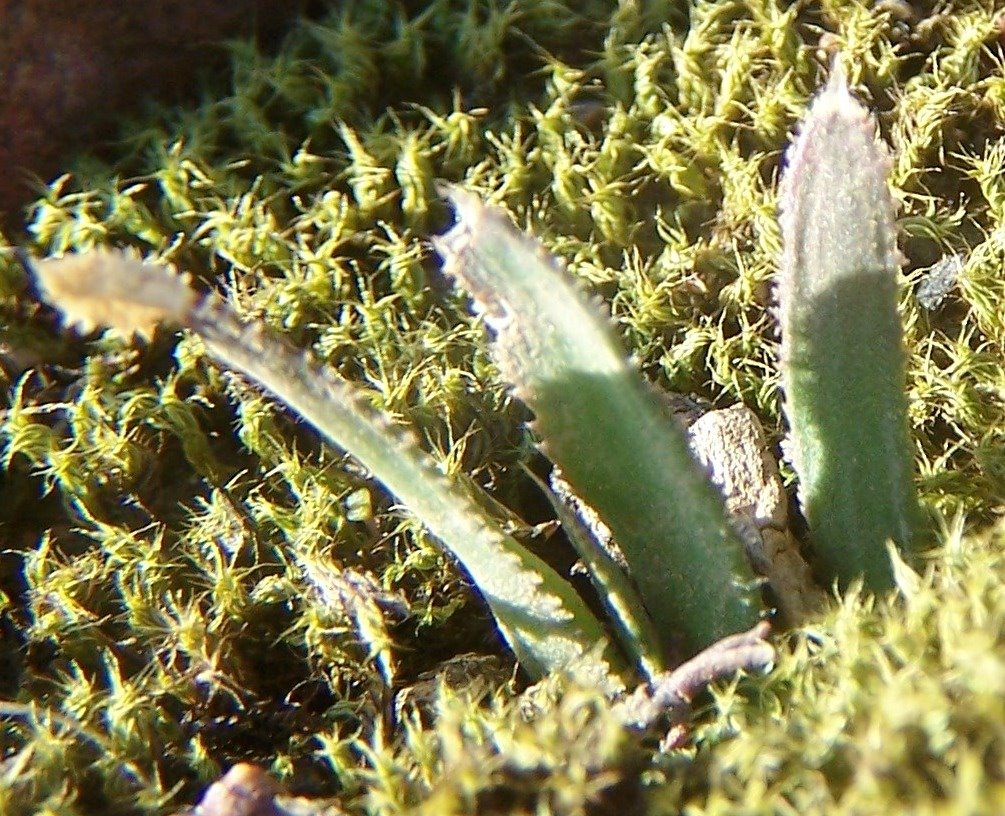- Table of Contents
- Mystery Introduction
- 1. Heidleberg and Albertinia
- 2. Hypothesis
- 3. Slang River and Haarwegskloof
- 4. Where to from here?
- 5. A digression to Kransriviermond
- 6. Contiguous
- 7. Floribunda spots
- 8. SE Tradouw
- 9. S Tradouw
- 10. Floribunda SW Tradouw
- 11. SW Tradouw
- 12. How do we know anything?
- 13. Swellendam
- 14. Flowers
- 15. Swellendam H. floribunda
- 16. How groenewaldii got it’s dots
- 17. H. mirabilis and groenewaldii
- 18. Recap
- 19. Surprises
- 20. Sandrift
- 21. Napky
- 22. Haarwegskloof again
- 23. Groenewaldii conservation
- 24. Non-Linnaean Taxonomy
- 25. Die Kop
- 26. Western boundary
- 27. Volmoed and an aside …
- 28. West of Riversdale
- 29. H. rossouwii
- 30. elizeae up on the Bromberg
- 31. Mirabiloids
- 32. Conclusion
- 33. Stormsvlei mirabilis
- 34. Haworthiopsis
- 35. Watsonia too
- 36. H. bayeri
- 37. Albertinia
- 38. Albertinia 2
- 39. Albertinia 3
- 40. Albertinia 4
- 41. Albertinia 5
- 42. Albertinia 6
- 43. Albertinia 7
- 44. Combobulation
- Supplement
Category Archives: Mystery
Mystery Introduction
More light on the Haworthia pygmaea/retusa/turgida species mystery.
While editing some old pictures I was just stunned that I have so understated the case that retusa, mirabilis, pygmaea, mutica, turgida and emelyae are really one species. The photographic evidence of the plants alone is unbelievable. What I do think has gone under the radar is evidence that I got from the flowers where the flowers of mirabilis, mutica, floribunda are shown to be inseparable.
Warwick Bayer: Do the flowers as a characteristic often fly below the radar as one may struggle to see flowers from different populations together? And one may so often be in the field and not see flowers at all.
Bruce Bayer: Yes, they do mostly because they are seasonal and often these places are not so accessible that it is practical to revisit. The other problem was of recording anything the so-similar flowers might be able to say. Dried they are useless. What I ended up doing was digital images of floret profile, side view, and face. … Very illuminating :)
2019.5.3 – Between the Gouritz Bridge and Herbertsdale. I do not anymore think it is a mystery in itself. The mystery to me is that a rational explanation is neither wanted nor sought.
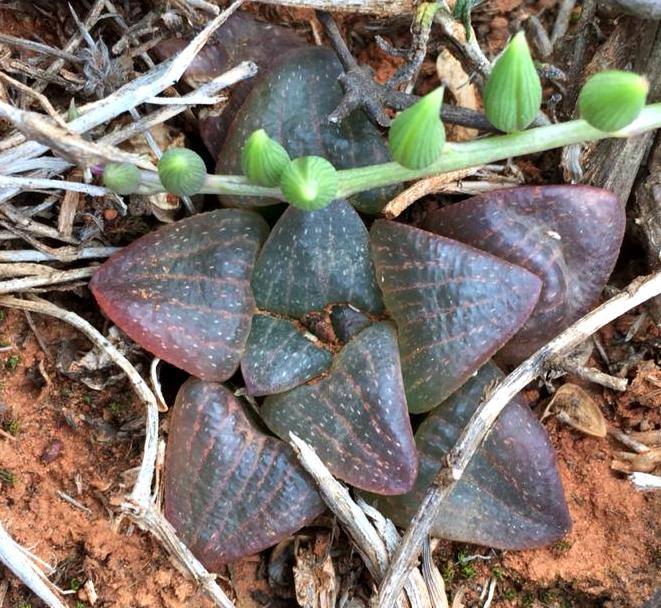
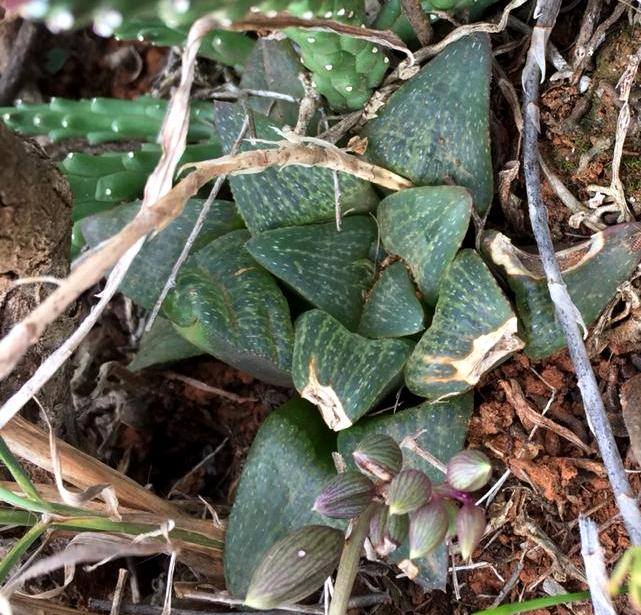
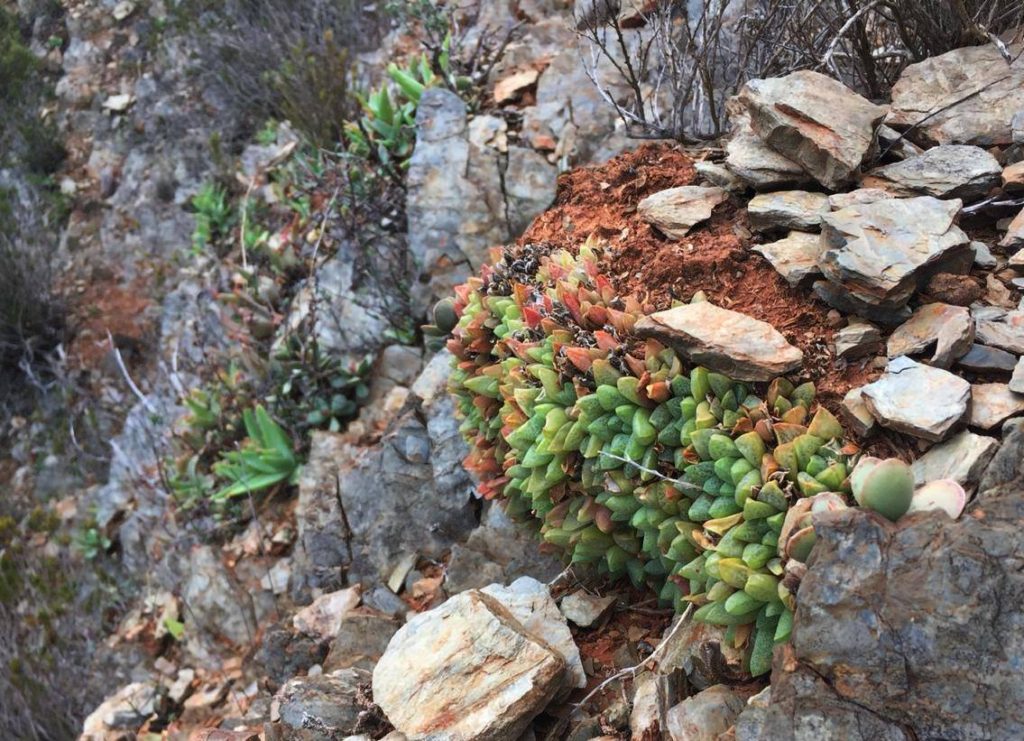
Here is a map to give a general idea of the locations.
1. Greyton/Genadenal area
2. Robertson Karoo
3. Bredasdorp, Napier
4. Breede River with Infanta, Malgas, Potberg at sea end
5. Tradouw with Buffeljags between this and 4
6. Slang Rivier to SE Heidelberg
7. Duiwenhoks River from Hedelberg to sea
8. Goukou River Riversdale to sea, Kruis and Wegwysers rivers to NE Riversdale
9. Gouritz River with Albertinia to east and Wydersriver to north Albertinia
10. Mossel Bay, Great Brak, Herbertsdale area
11. Montagu area N. Langeberg Range
12. N Garcia Pass in Little Karoo
12. Aasvoelkrans in Little Karoo
2019.5.6 – I thought I would post this to show how confusing classification, plant names and classification can become. I found a folder with these pictures – turgida, pygmaea, retusa, mutica, mirabilis, floribunda, and emelyae. Ridiculous as it seems, they can be linked by a geographically arranged sets of variants that morph them into a single set. In the process my mind just boggled at collectors who just cannot seem to grasp the problem or a solution. Around Mossel Bay we have two species H. turgida and H. pygmaea but in the west around Greyton to Napier, we have three H. retusa, H, mutica and H. mirabilis. In between there are a host of combinations while a fourth species intervenes viz. H. floribunda. Difficult enough, but across the Langeberg there is a fifth, H. emelyae. All one? H. floribunda has its own complications. No single picture is remotely adequate to illustrate any one of them. It is this kind of complexity that pervades the plant world and the botanical names we need to communicate about them.

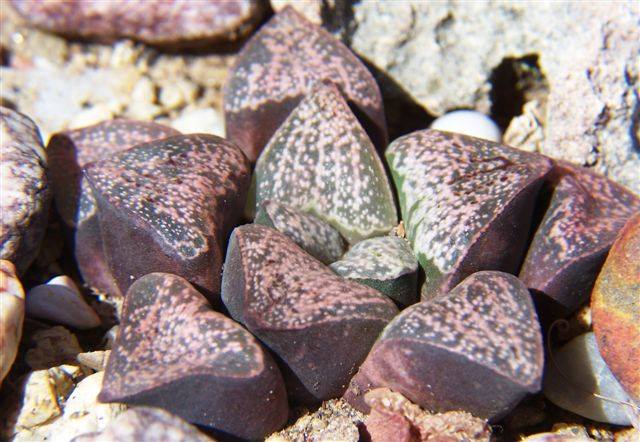
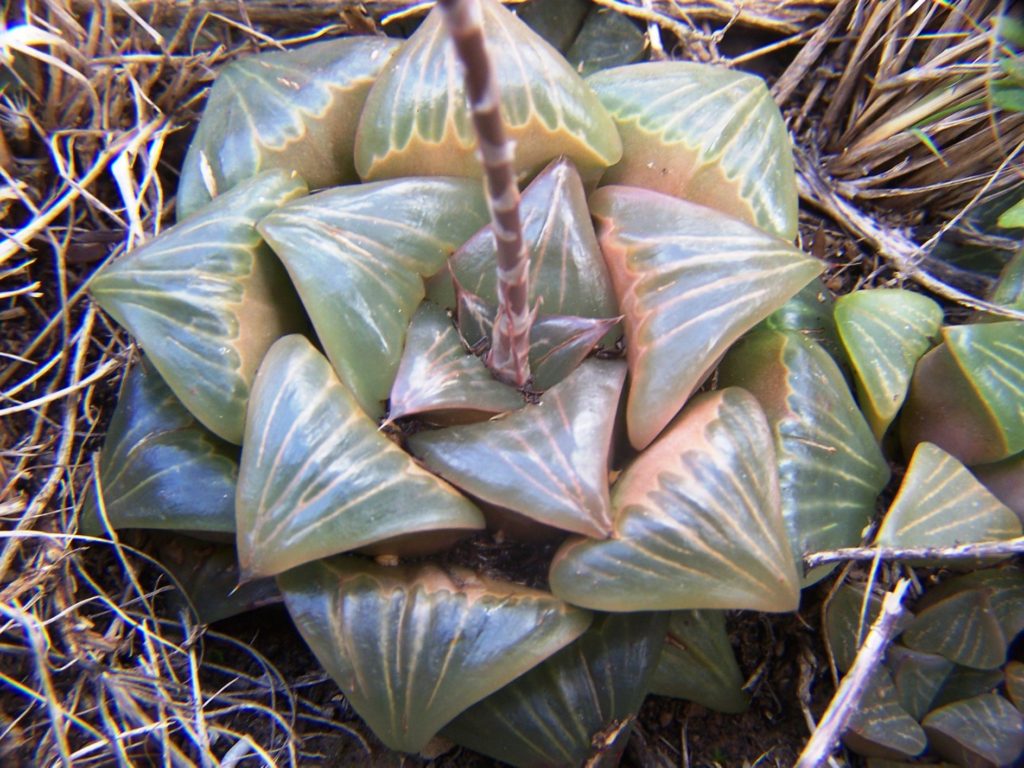
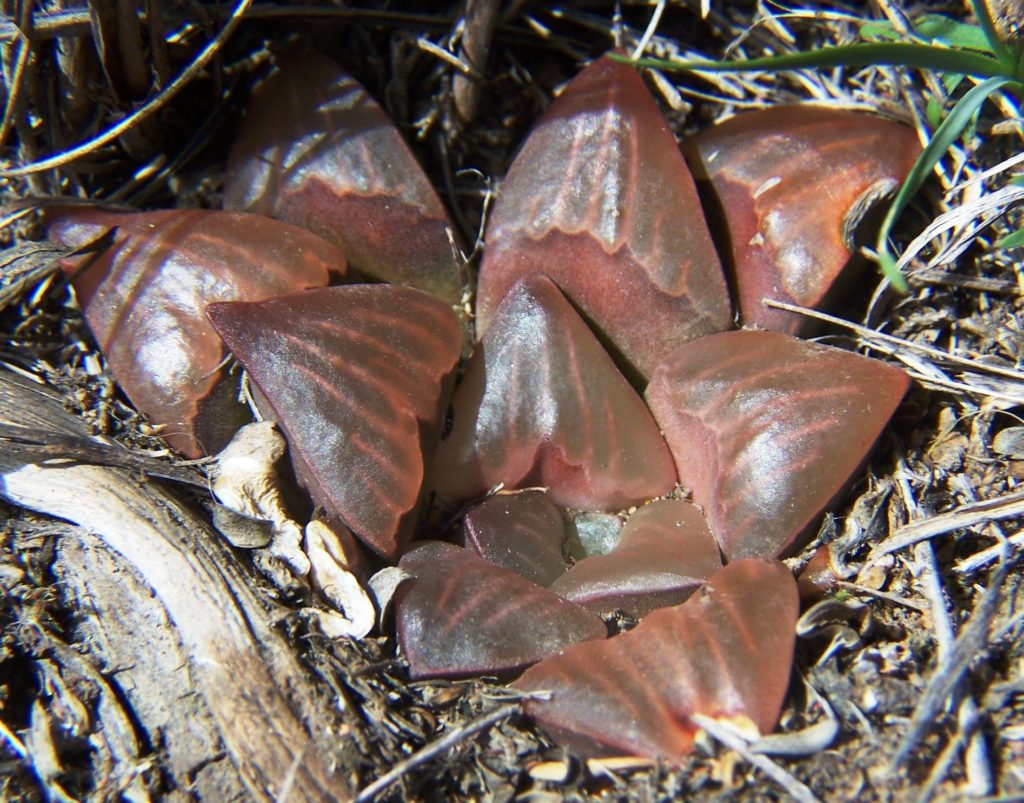
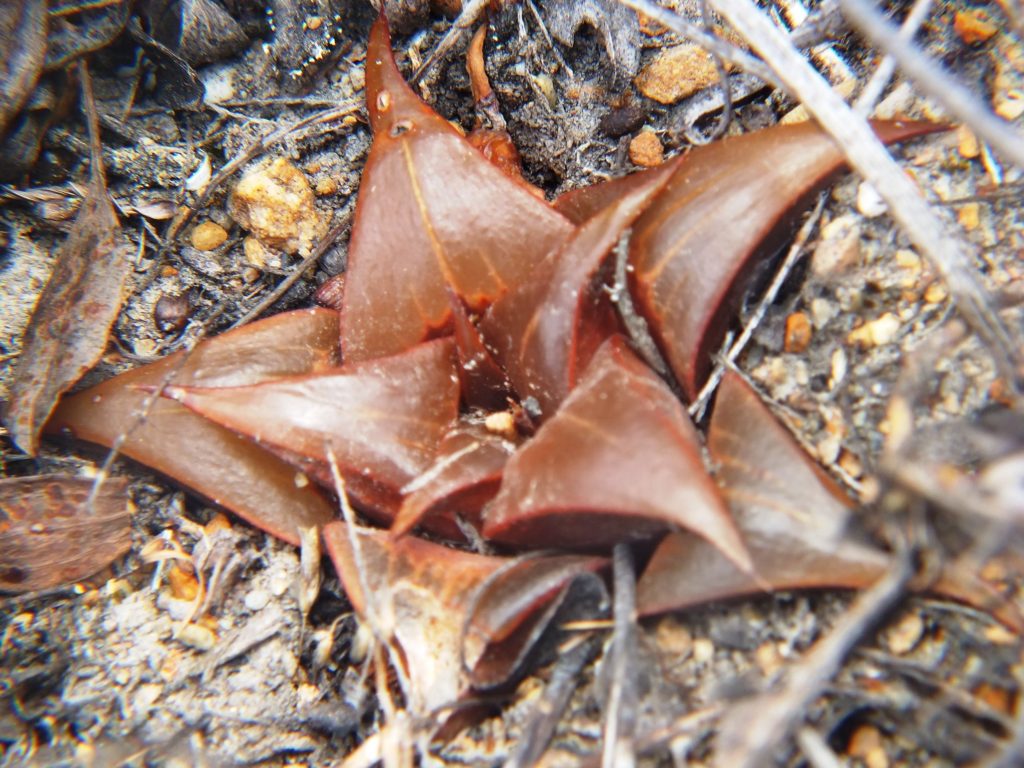
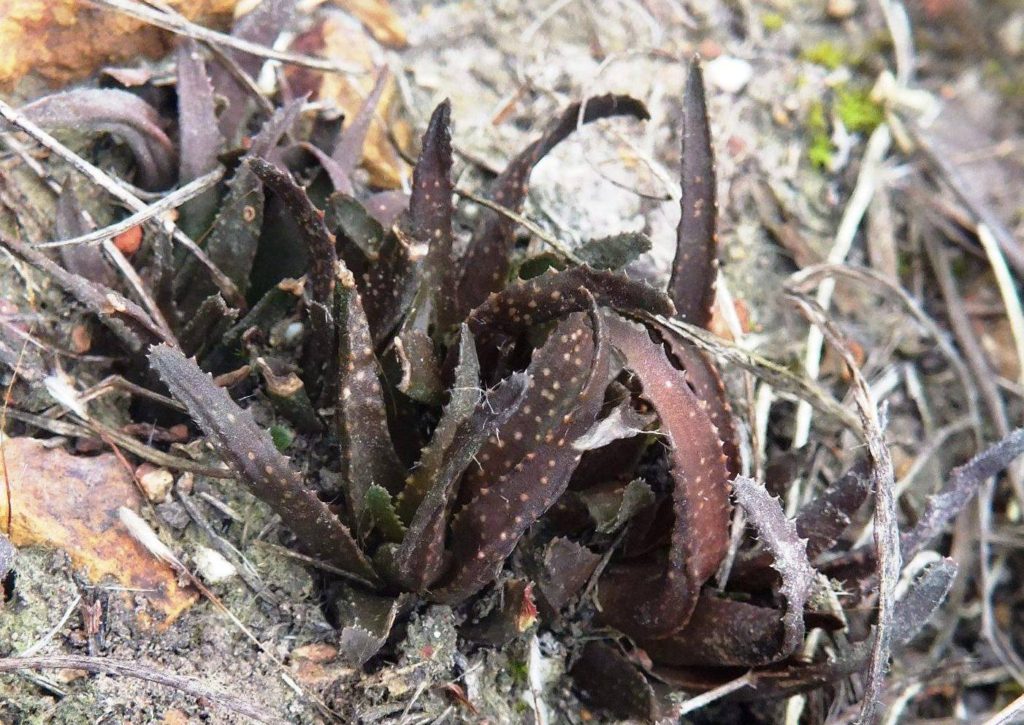
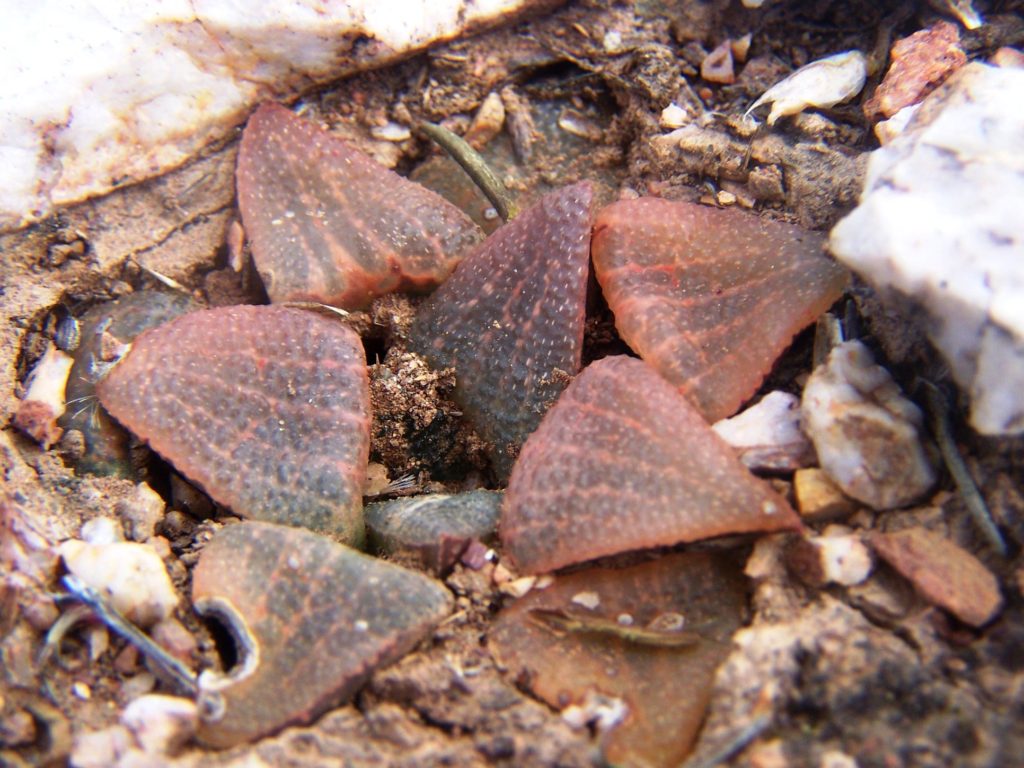
Steven Molteno: I’ve recently got very interested in the relations between floribunda and mirabilis, because of this gradient being so often syntopic with T. marginata. The N.Bredasdorp-Rooivlei Haworthia interest me in particular. Some really remind me of floribunda. More and more I feel the need to draw out some multidimensional lattice in order to try model or understand these relations. A bit like the map you once drew of them Bruce.
Bruce Bayer: Yes Steven – I think this is the real challenge and I find it difficult to believe that there are not botanists who are working at this – confounded by the majority who are stuck in a dead-end. I think I arrived at a classification solution by visualising such a lattice as a reality. What should be done now is to take the end classification and generate layers according to it. This would be a great test of the classification.
Here are more giant retusa from the same locality – what is true is that populations have characteristics as much as the “species” do. The Haworthia species mystery continues …

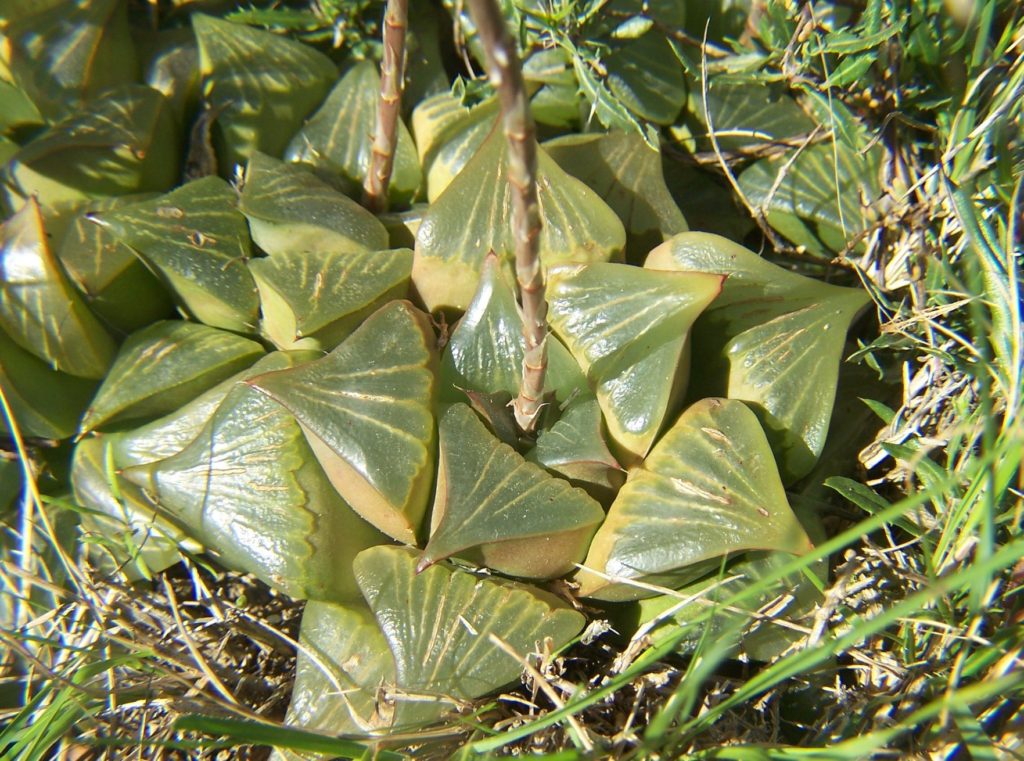



2019.5.8 – I only have two pictures of cultivated variants for a place north-east of Albertinia near the Gouritz River = “turgida”. They add to the next three that are the pictures sent to me from a locality a few miles further east right on the Gouritz. These pictures support this fact. If you interpret them in the light of populations to the east you might say the third and fifth pictures are H. pygmaea and the 4th “turgida”. But if you do so from the west you arrive at H. mirabilis and H.”turgida”. In fact, they are not quite either. Why? They come from a common gene pool that is one species! Proliferating all these personal and acquaintance names does nothing but bury the issue under a pile of garbage. ♦
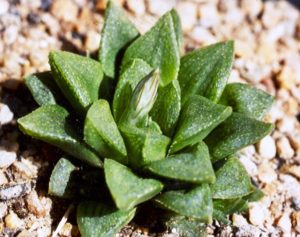
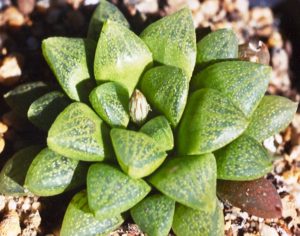
1. Heidleberg and Albertinia
1. 2019.5.7 – I am going to post a heap of habitat pictures of H. retusa/turgida to help enthusiasts understand these plants and their relationships. As with H. cymbiformis and H. cooperi, there is a direct correlation of clump-forming cliff dwellers (turgida) and more solitary ground hugging plains dwellers (retusa). It is quite important to recognise the geographic relationships as well but that is rather difficult to do without maps. The immediate geological formation e.g. less erodable sandstones vs. more erodable shales, is also significant. This is H. retusa at the midwestern limits of its distribution on the Breede River near Swellendam.
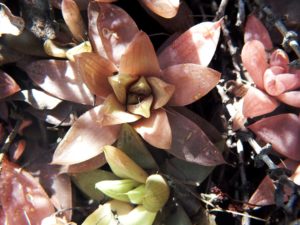
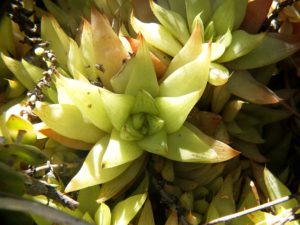
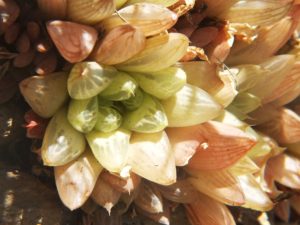
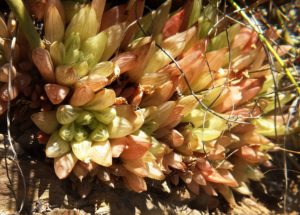
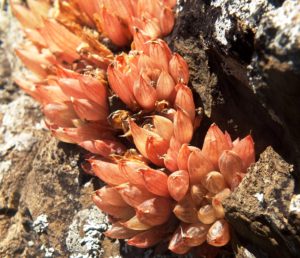

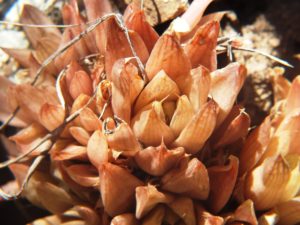
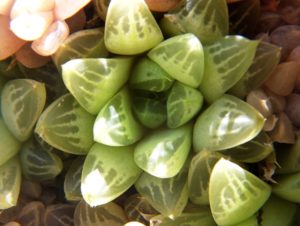
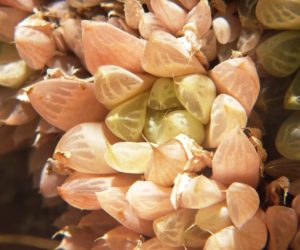

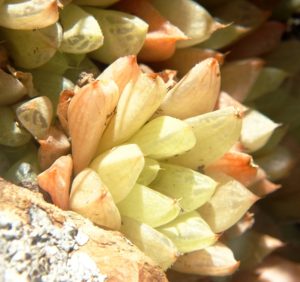
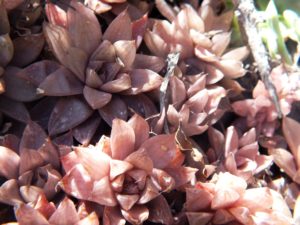

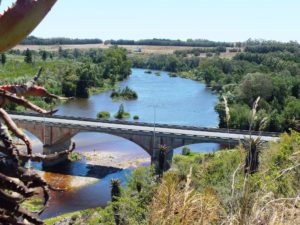

What I find extraordinary is the way in which amateur succulent journals resist any effort to rationalise names in accordance with some sort of scientific intent. The Latin binomial seems to be all significant and it has made life in Haworthia absurd. All it needs is a very simple adaptation and the adoption of a convention where the species name is taken as generic and is so understood in the community?
Steven Molteno : This post made me look at my maps again. I see the west-east gradient between mutica-nigra-retusa … I think I also see the habitat-gradation from retusa to turgida in the Eastern Overberg & Riversdale area. On the map it looks like turgida then stretches out in all directions (often along the river-valleys). I get this initial impression because in its westwards extension (i.e. back towards Swellendam), I do not yet see any gradient between turgida and mutica. Would it be correct then to assume that this is because they’re at different “ends” of this entity’s spectrum? (I’m not factoring in the other arms of this entity yet – i.e. mirabilis, pygmaea etc., or my brain will explode. I find it easiest to just examine portions of the Haworthia lattice, one by one, and maybe that’s a human tendency that leads us to the illusion of discrete binary units in nature.)
2. 2019.5.8 – Heidelberg is an extraordinary place for Haworthia and H. retusa has many guises particularly towards its turgida variant. In this population the plants are large and there is a mirabiloid connection as well.
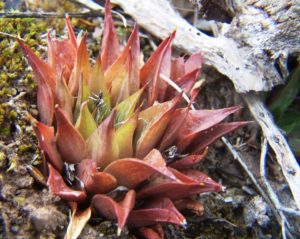

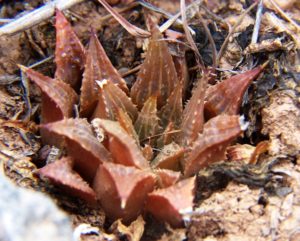

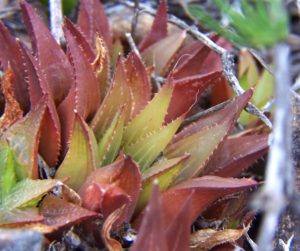
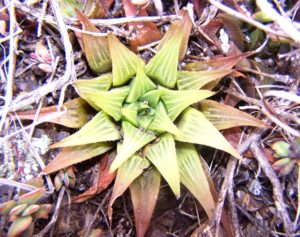
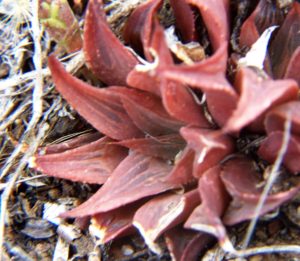


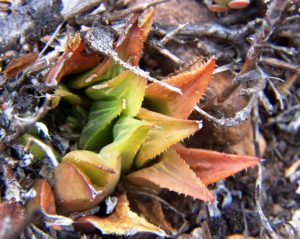
Steven Molteno: I’ve wondered about the mirabilis at Die Plotte west of Heidelberg. Many I thought had features I previously associated with retusa-turgida
Bruce Bayer: Steven – this was the near origin of “heidelbergensis” as very small mirabilis. But looking at only one population does not help much. There are several river systems in the southern Cape and these are associated with the drivers of species variation. At Heidelberg we have the Klipriver and the Duiwenhoks going down to the sea. So, from the sandstone Langeberg to the limestones at Vermaaklikheid we have all the ingredients for difference in the Haworthias. The entire mirabilis/retusa lineages seem to have their origins down those valleys.
3. 2019.5.9 – H retusa/turgida at Draaihoek NNW Albertinia – a classic as H. dekenahii also originated here but it is of more solitary and flatter to the ground (it fits better into the pygmaea element than into retusa). The 5th picture is significant because it is very mirabiloid and could easily be passed off among southern populations of H. mirabilis.


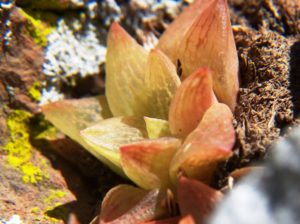
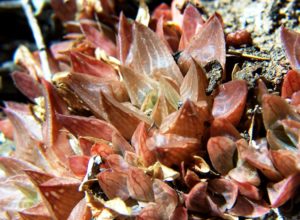
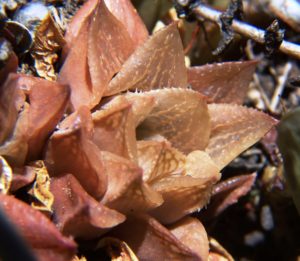
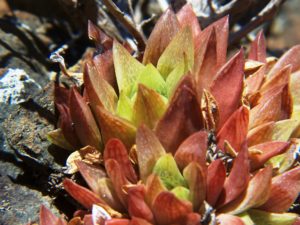
4. These are unfortunately the only pictures I have for “H. dekenahii” (= H. pygmaea) Draaihoek. The locality has been severely impacted by bush encroachment associated with fire management along a power servitude. I wonder if there are still plants there?



Delightful, as I find myself confounded by the very trap I am explaining away. Draaihoek is a principal element in the illusion that H. pygmaea and H. turgida are two different things. When the picture is complete it is very obvious that the two things there are the plains and the cliff forms of the same thing (H. retusa). It later becomes clear that we have a thing south of a mountain range and one north of a mountain range (H. emelyae) where space is the only difference?
5. 2019.5.10 – These posts are not in any sequence and are just taken fairly randomly. So just let us go back to Heidleberg and the Duiwenhoks river that runs to the sea. River systems was an early insight into how this puzzle arises. Tierhoek is a dry area to the SE Heidleberg. It seems to have been unknown or there would probably be a name for the plants!
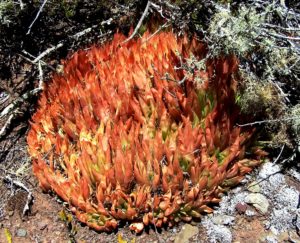
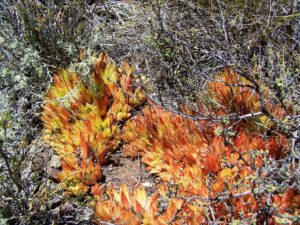
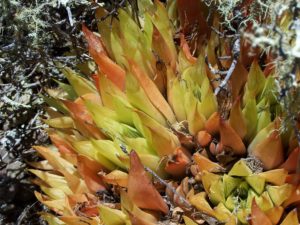
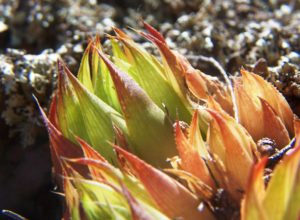
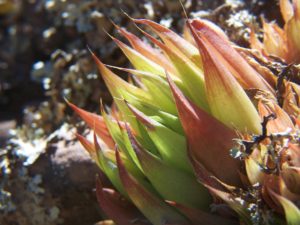


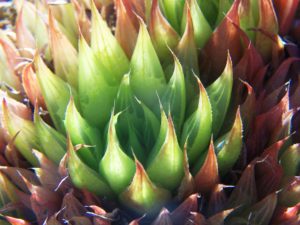
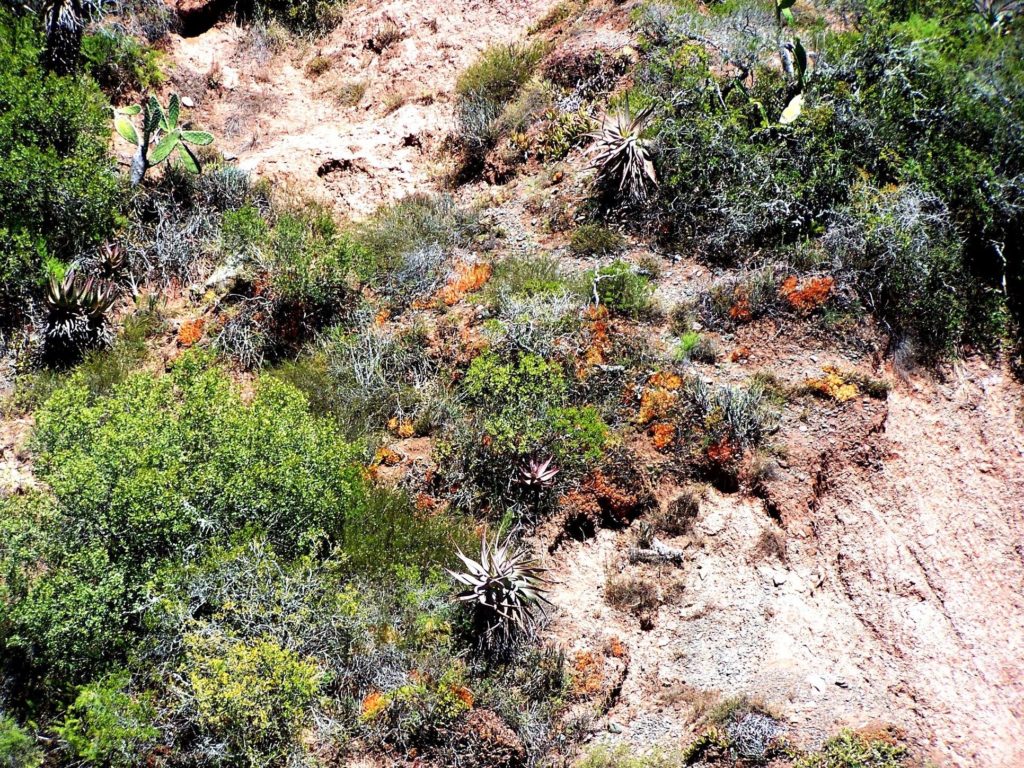
6. 2019.5.11 – In one of my very early articles I wrote about the continuity of H. turgida from about 16 miles north of Heidelberg down the west bank of the Duiwenhoks river to the town itself. This proved to me that the small spiny green forms in the Sandstones were continuous with the bigger, smoother, yellow, pink and red-coloured plants southward and again to the east all up the Goukou river at Riversdale. The foundation was already laid for the understanding that turgida led on to retusa.
This is an odd population from SE Heidelberg along the Duiwenhoks that in a way replicates the Sandstone forms of turgida (= caespitosa?).

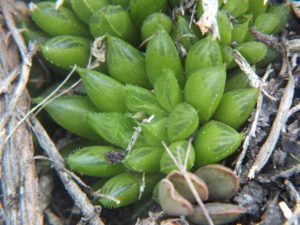
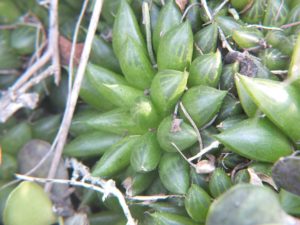
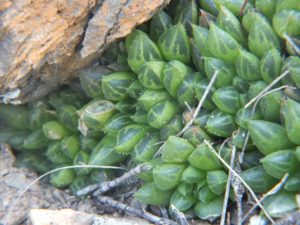
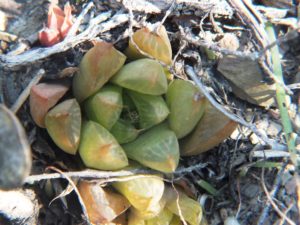
2019.5.12 – As an aside. While looking at these greener things, it occurred to me to make this connection. It brings multiple things to my mind that are fairly new and additive to my story. Is there a suggestion of continuity? What do you think?
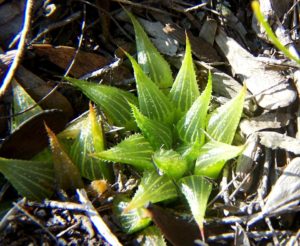
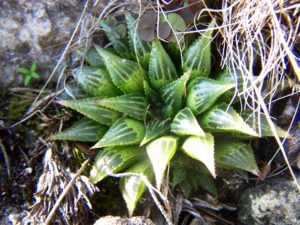

Lawrence Loucka: Oh look, 3 different species all in one spot!
Bruce Bayer: Too true! Disastrous! It makes me wonder if the story is worth telling. This is actually “H. paradoxa” in limestone at the mouth of the Duiwenhoks. Taking all the variants, I have no doubt that I could find images from the whole periphery of the distribution of emelyae, mirabilis, retusa, mutica, pygmaea to indisputably say this must be ONE. Strange how unavoidable it is that I use names to explain that only one is actually necessary!
2019.5.13 – The first two pictures are from Kransriviermond where this “turgida” hybridises (sic!) with “mirabilis” to generate “mutica var. nigra” – a lineage that can be traced back up the Duiwenhoks, through Heidelberg, along the Klipriver, Van Reenens Crest, Tradouw Pass, Buffeljagts Rivier to “mutica” in the west. The second two are “turgida” again, from a bit south at Dassieklip. That lineage crosses over to the Goukou River to the east and merges in the “retusa” “turgida” “mirabilis” melange of that area.
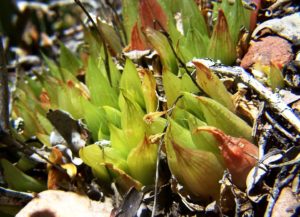
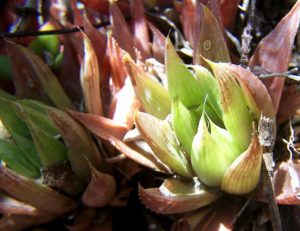
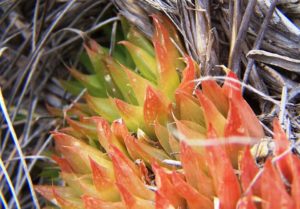
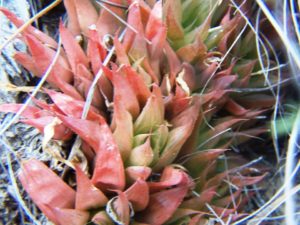
Jakub Jilemicky: I think plants from Brakkekuil, a bit further South have also both, turgida and retusa nigra.
Bruce Bayer: Yes Jakub, I posted a whole set of those Brakkekuil plants – what is also interesting about them is that it is neither a steep cliff-like habitat nor a flat surface habitat.
https://haworthiaupdates.org/2012/01/30/volume-5-chapter-4-haworthia-retusa-part-2/
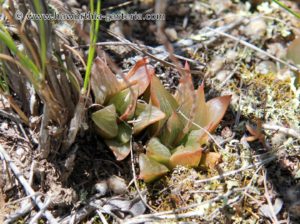
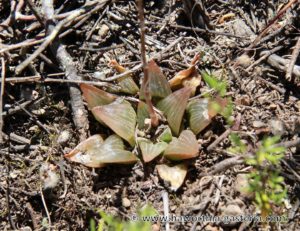
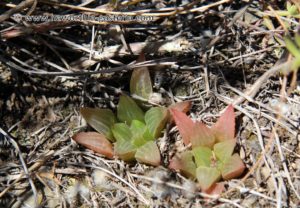
7. 2019.5.13 – Neither “retusa nor turgida” are known near this to the SW of Heidelberg on the Slang River. ♦
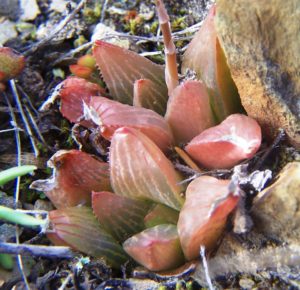
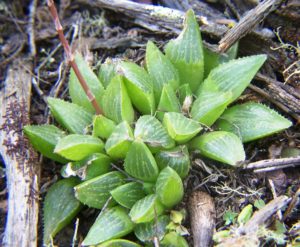


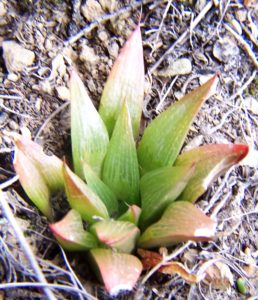
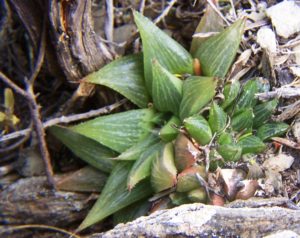
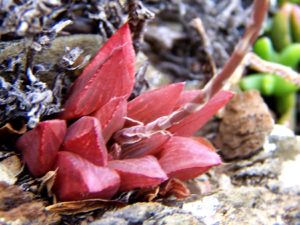
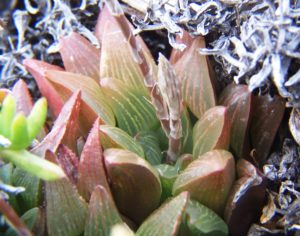
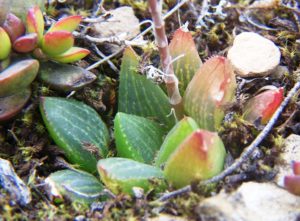
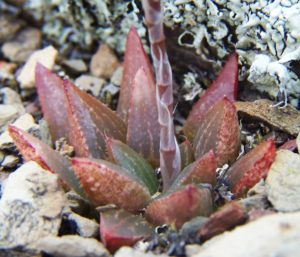
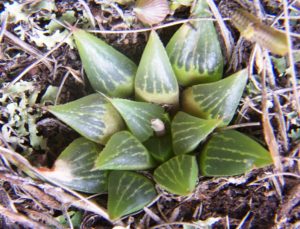
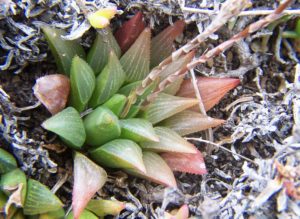

2. Hypothesis
7. 2019.5.19 – Perhaps I should have spelled out my hypothesis in the very beginning of this Haworthia Species Mystery. This is that Haworthia was separable into morphological and numerically defined entities that would fit into a clearly defined set of species. A proviso being that the word species was defined as based on the ill-considered and untrue precept of non-interbreeding entities. The nature of variability coupled with this weak species definition result in the initial hypothesis to be totally false. Haworthia does not present such clearly defined entities and in fact there is a very variable set of elements that can only be recognised in respect of their general appearance and their geographic distribution and relationships. These are themselves mildly confounded. In fact, the issue was grossly confounded by the now established fact that Haworthia was, in reality, three very different genera.
When I dismantled G.G. Smith’s putative two-volume manuscript purporting to be a monograph, these three genera were split into 20 sections with specimens of many of the currently recognised species, represented in more than one. I never pretended to be the knight in shiny armour that was a going to slay that windmill of confusion and I put a great deal of effort into looking for someone who could and would. That never materialised.
From my personal perspective (isolated as I am from the popular literature of the last 5 years), all I can say is that there is a publication authored by myself and Dr. John Manning that reasonably presents the truth of Haworthia. It does not entirely do so as this series of posts will show.
Science as a real matter of inquiry, together with objectivity, rationality, logic and reason, are not strongly represented in the human endeavours that have been and are being made to properly understand the phenomenon of the Haworthia species that can be observed. There is no doubt that DNA sequencing offers the very best solution to the issue. My experience suggests that there is still some way to go before that goal is reached and it will not be done until the complexity of issues like this one are seen to be real and understood as they are.
This is the reference … Bayer, M. B. and J. C. Manning. 2012. A rationalization of names in Haworthia: a list of species with new combinations and new synonyms. Haworthia Update, Essays on Haworthia, vol. 7. Preston: Alsterworthia International. Haworthia Nomenclator ♦
3. Slang River and Haarwegskloof
8. 2019.05.14 – The Slang River first runs south as does the Duiwenhoks, but instead of going on to the sea, turns westward and enters the Breede River further west. So, we find retusa again near Malgas – further south than my first post. Note I have abandoned using the name “turgida”! This is symptomatic of the whole issue viz. that application of names is so difficult because even in a single population the plants can be so different. Plant geography is interesting here in that Ceropegia (Stapeliopsis) stayneri is only found in its lower reaches. Recent developments in the taxonomy of the asclepiads and the disappearance of many genera is also worth noting.

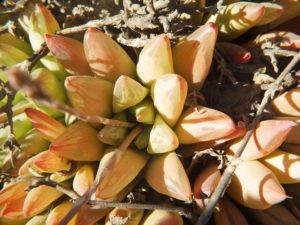
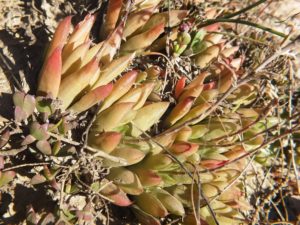
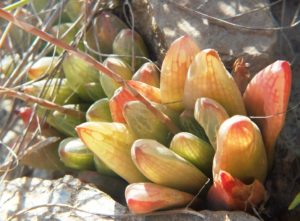
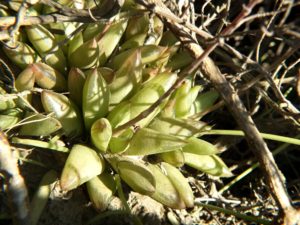
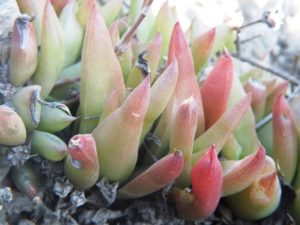

9. 2019.05.15 – It gets exciting for whatever direction one goes. This is to Haarwegskloof where Jannie Groenewald found this namesake. Here we also have H. mutica and H. mirabilis. So, I am trying to explain that they are actually the same species!!! Three posts a day and all my pictures; by the years end you too will concede that they are.
Haarwegskloof is west of the Breede River and it is important to consider the nature of rivers and river systems as they affect speciation. Rivers follow fault lines and other geological features, while haworthia thrive on exposed eroded surfaces and low biomass sites. So rapidly and deeply eroded formations provide different habitats to shallow surface erosion. The immediate river environment results in stepper cliffs and rawer rock. Thus we have the very deeply cut Gouritz river and fairly deeply cut Goukou, Duiwenhoks, Breede and Slang Rivers. West of the Breede we have curious rather shallow valley drainage systems with some water courses barely reaching the sea.
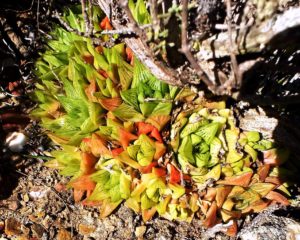
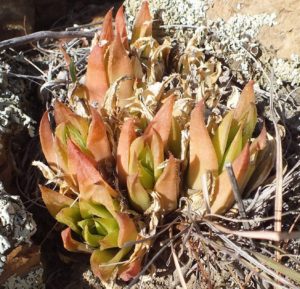
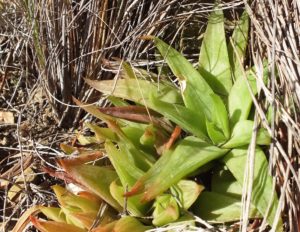
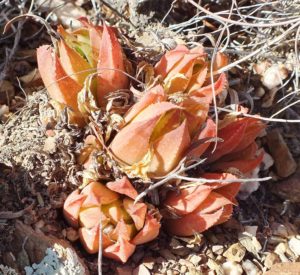
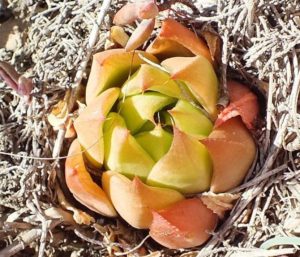
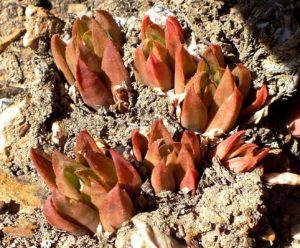
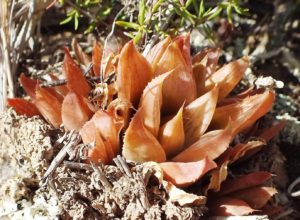


10. 2019.05.15 – Still going further west from Haarwegskloof we come to Rooivlei, north of Bredasdorp to the most southwestern known retusa and we have entanglement supreme. We have various forms of mirabilis, and perhaps rossouwii or variegata while mutica lurks not far away. These last two locations do make it difficult to accept that we are dealing with one species when in fact it suggests that the situation may be far more complicated. But really if one takes the various nodes on river or drainage systems, the situation becomes much more obvious.
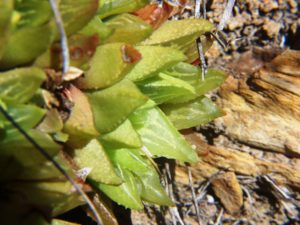
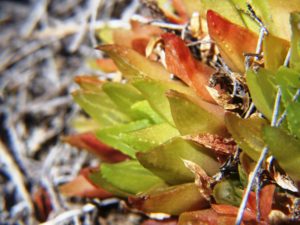
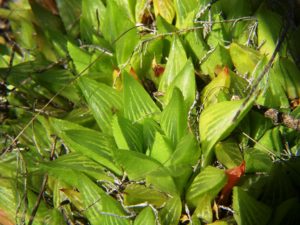
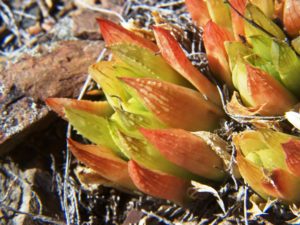
Steven Molteno: What I don’t fully understand is how Rooivlei and Haarwegskloof connect to the major river systems to the east. Breede river tributaries maybe?
Bruce Bayer: No, they do not and I don’t think so much significance needs to be attached to this if any. The occurrences of the populations are attached to geographic and geological features so drainage systems are just a weak underlying kind of thing. It is like the role of the Langeberg separating the karoo from the S Cape that also relates to the greater retusa complex and how emelyae emerges as a consequence.
Steven Molteno: Okay thanks Bruce, yes I didn’t see an obvious riverine corridor going there. But then there are several interesting parallels between that area north of Bredasdorp, and (specifically fluvial!) terrains further east. The relevant Haworthias seem to extend here of course, as you point out. In addition, Tulista marginata – usually known from high, eroded fluvial terraces further east (e.g. Die Plotte, Riversdale) or north (Bontebok, Drew, and maybe … overlying the Ashton Enon Formation!) … T. marginata is also on the flat-topped hills N. Bredasdorp, which intrigues me. I even tried to look up whether perhaps a long-dead primeval river might have run past there, before the glacial cycles played havoc with the sea levels! It doesn’t seem so, but who knows. ♦
4. Where to from here?
11. 2019.5.16 – Where does one go from here? These pictures all date from after the 1999 revision so forgetting all the pictorial information to that date I have only given a peek at what was “turgida”. I still have 5-6 folders for that, 24 for retusa itself and 14 for “nigra”. Then many more for mirabilis, mutica, pygmaea and emelyae. There are 6-8 threads among these that trace various continuities and I think next I will just go via “nigra” on the way to mutica?
What I find extraordinary is the way in which amateur succulent journals resist any effort to rationalise names in accordance with some sort of scientific intent. The Latin binomial seems to be all significant and it has made life in Haworthia absurd. All it needs is a very simple adaptation and the adoption of a convention where the species name is taken as generic and is so understood in the community?
Cohan Fulford: taxonomy is seen as a dirty word by many horticulturists, with what is perceived as constant changes – often to well known and cherished entities – and dissent among taxonomists taken as meaning the whole field is arbitrary.
Bruce Bayer: Yes Cohan and even qualified scientists in other disciplines, including botany, do not actually understand the processes.
True “retusa” is already posted from this same locality on the Duiwenhoks and just across the river is a small form of mirabilis that could involve floribunda! When I first saw a picture of this I speculated that it might prove to be involved with H. mutica. I cannot remember the exact history and why it came to be known as nigra var. mutica – but as a matter of interest I quote from the New Haworthia Handbook with reference to mutica and retusa…”if the two species do meet it can be suggested to be in the area between Heidelberg and the lower Breede River”. How true this has proved to be. But no meeting at all – just a dramatic flow.
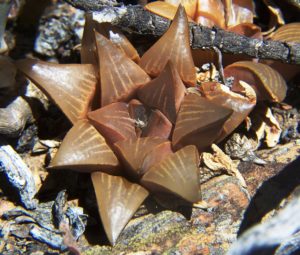
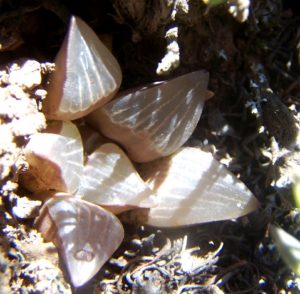
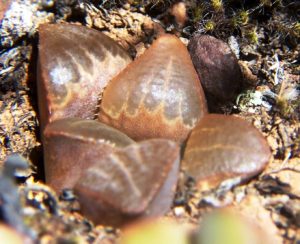
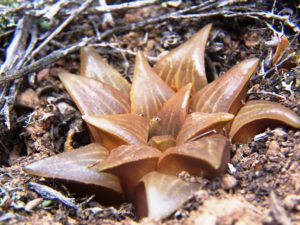
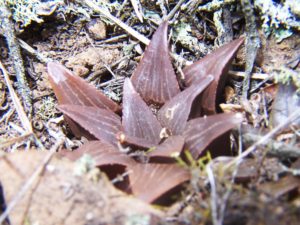
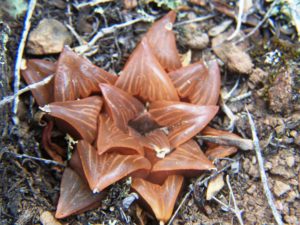


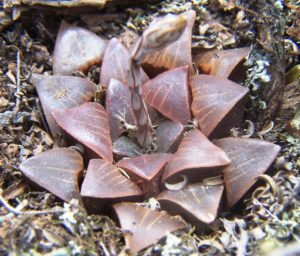
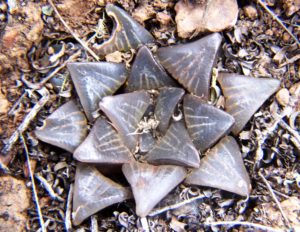
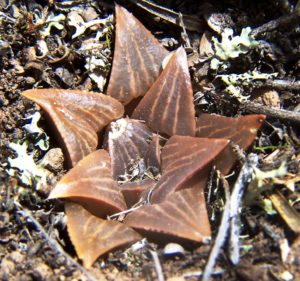
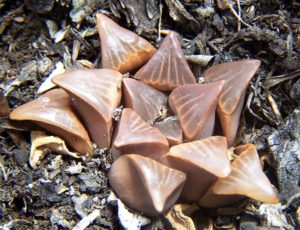


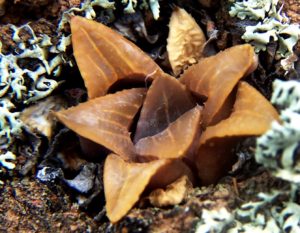


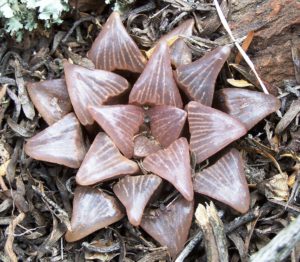
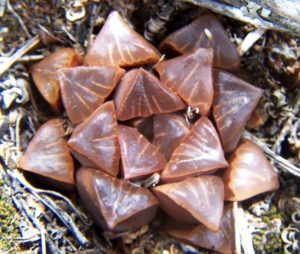

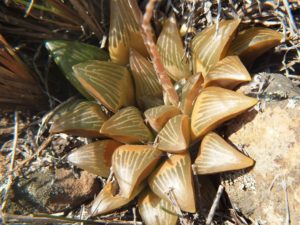

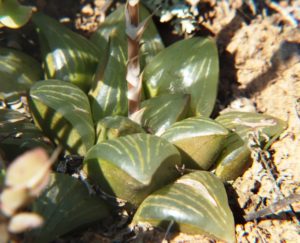
Cohan Fulford: Every one beautiful! Fascinating to get a glimpse into how the various taxa interact.
Bruce Bayer: Better understood as largely interaction within one taxon? There is or are levels above this doing similar things. Why are taxonomists not examining these weird happenings?
12. 2019.5.17 – Here are more pictures of the potential mutica viz. a mirabiloid/retusa with floribunda infused. Between Kransriviermond and Heidelberg.
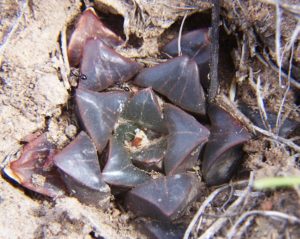
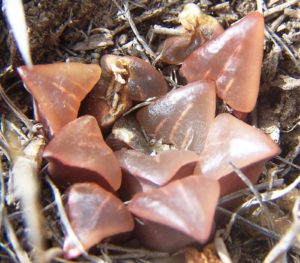
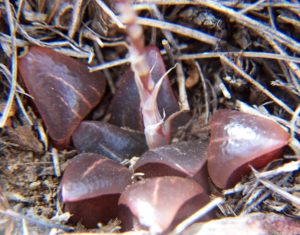

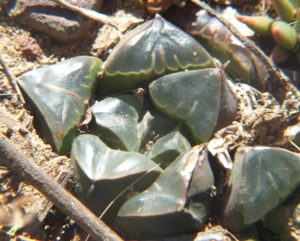

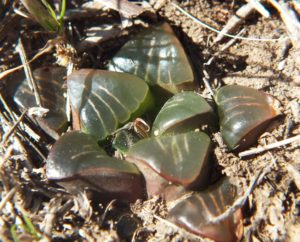

Steven Molteno: It seems a lot of the complexity arises from repeated radiations and confluences – in certain directions. The directions interest me because the southern cape’s been subject to repeated pulses of arid – wet climate (driven by the ice caps’ cycles apparently). So the suitable “bands” of habitat would’ve moved back and forth over the millennia, inhaling and exhaling Haworthia radiations across the Overberg! Perhaps especially along the river valleys, which sound like plant highways!
Bruce Bayer: Yes – I think one of the strongest points to make is that the model has been that an imagined model based on this sort of thinking has been predictability e.g. the fact that nigra is continuous with mutica.Irving Navarro: Steven Molteno, I always wondered how bruynsii came to be, it’s yellow roots always amazed me
Bruce Bayer: Irving that IS an interesting observation. H. bruynsii may have its origins in or near sordida but yellow in the roots may be an aloid character?
13. 2019.5.17 – There is also a very strong north/south influence in the distribution of the elements. H. floribunda is playing a much stronger role in my narrative than I anticipated. It covers virtually the same range as the 6 elements of retusa. But to the east it does not occur south of the principal road from Cape Town to Mossel Bay. It is only at Swellendam where it does come south of that and it emerges from mirabilis as a wholly separate element far further south at the Potberg where it is partly confounded with H. variegata. It has an incredibly close association with the atrofusca forms of the mirabiloids. These here are from 3 populations west of Heidelberg where the preceding muticoid influence is very strong as well as the input from floribunda. As a general comment, the mirabiloids to the west are generally more dominant in the southern parts.


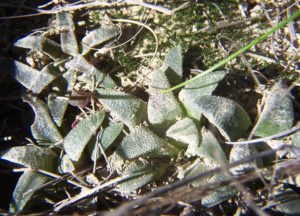
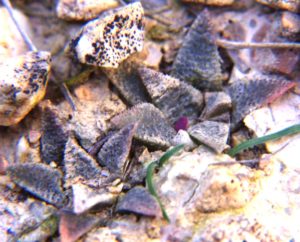
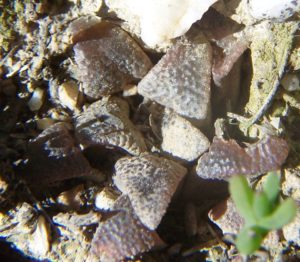

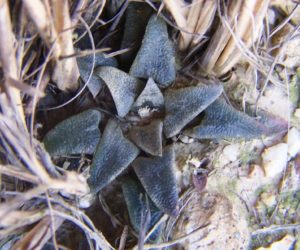
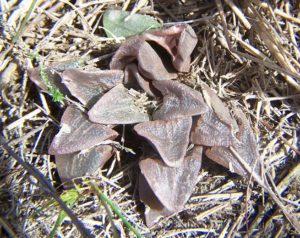
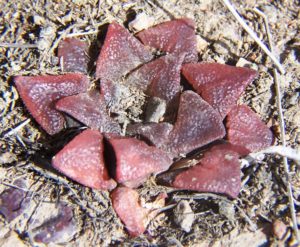
Bob Hunter: Bruce – I am finding this series of posts very interesting, and am glad that they are going to be collated, edited, and published. I hope that, given the problems with the traditionally used language here, that published collation can in some way accompanied by some sort of ‘graphical’ illustration of these insights – a hard ask, I know, but it would help a lot to make people think more about this issue.
Bruce Bayer: Thank you Bob, there is already a great deal published in HaworthiaUpdates.org as edited by Lawrence Loucka, but the whole issue is bigger than myself and it would be nice to grow it as a community of interested people like yourself. Steven Molteno is addressing a big part of the story and we are going to learn a lot more.
14. 2019.5.17 – I have not pre-planned this narrative of the Haworthia Species Mystery in the belief that there is a natural coherence to it despite the very broken nature of the available evidence. Human habitation and agricultural development have changed the landscape dramatically while exploration itself is not complete. I am finding a flow to the story that comes out of the evidence and not out of personal prejudice. Here I post some pictures for a population a bit south of the previous one. The retusoid and muticoid influence is dropping out and it is changing to mirabiloid dominance with an unquestionable infusion of florabundoid.
The language of “oids” is proving very meaningful and from here I will pick up again on the mirabiloid retusoid and the muticoid mirabiloids. In the introduction I wrote about the nature of the plants as they relate to geographic space, geological formation, slope and aspect. But also the question of a spring, as opposed to a late summer – early autumn flowering period being a major driver of diversity of this single species complex.
From the population illustrated, the mirabiloids burst southward and westward right up northward into the Robertson karoo and through the Tradouw Pass into the Little Karoo. From there they extend eastwards and merge into the emelyaeoids as other retusoids spread northward via Tradouw Pass, Garcia Pass, and Gouritz Gorge.
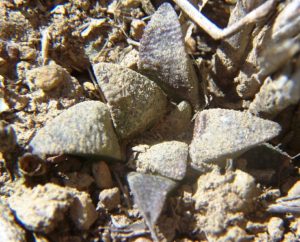
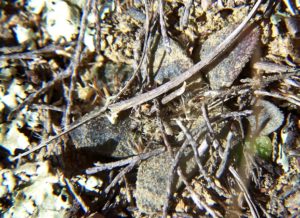
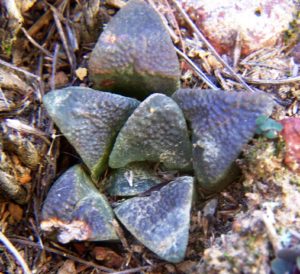
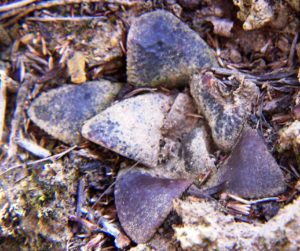

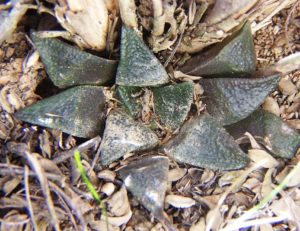
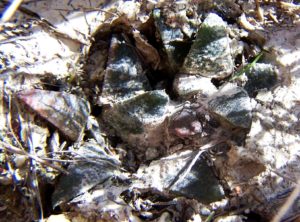
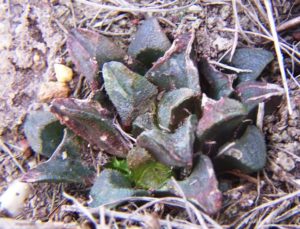
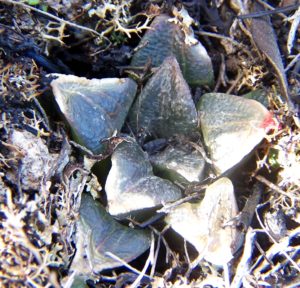
15. 2019.5.19 – Language – I have been and am, using the suffix “-oid” to mean belonging to a group of similar things. So far I have not shown that mirabilis and retusa are the same group of things. In fact I may not have done so for turgida and retusa either and tend to treat this latter as an accepted fact. What I have shown is my perception that a mutica-like group originates from retusa and mirabilis. So muticoid arose from retusoid and mirabiloid. So far my posts are following these groups westwards from the Duiwenhoks river and Heidelberg. My last two posts were mirabiloid with a floribunda infusion and these flower autumn. The next post is a little further west of a retusoid – I will call it muticoid retusoid because it does have a mirabilis infusion and it will lead to mutica. As will another group I will call muticoid mirabilis. Bear in mind that flowering time is important and not always available. These pictures now posted, were taken in September and thus spring flowering.
Incidental but very important is that nearby is one of the few floribunda populations South of the main e/w highway. These elements/oids are not sharing habitat!! ♦
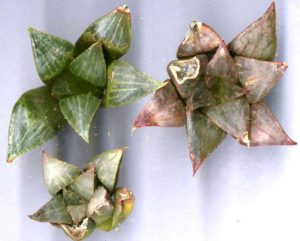
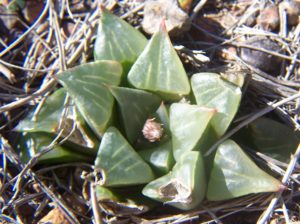

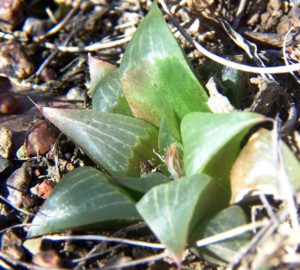
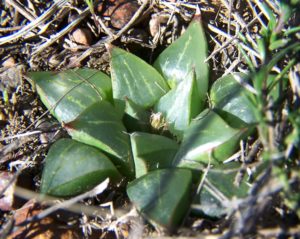
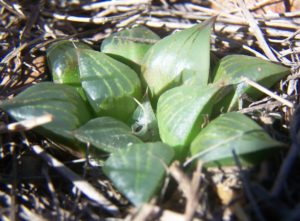
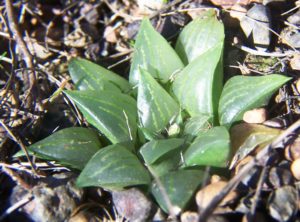
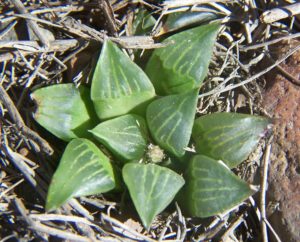
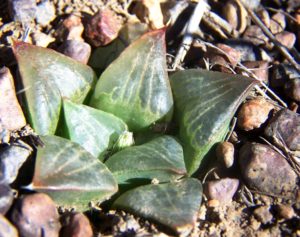

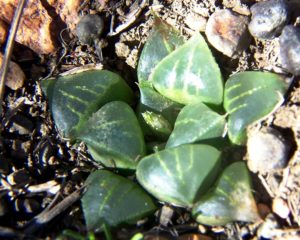
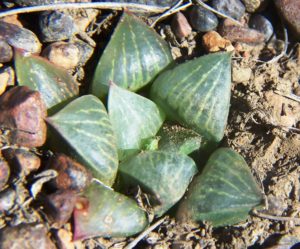

5. A digression to Kransriviermond
2019.5.16 – I need to digress – again. Here at Kransriviermond we have two things viz mirabiloid and retusoid. They hybridise to produce this element we call muticoid (“nigra”). The word “hybridise” normally implies interbreeding of different things (species). This is not the case here at Kransriviermond where it is recombination of diverging elements of the SAME species. In my next set of pictures from further north you will need to understand the dramatic role of H. floribunda. This is because this species is intrinsic in the mirabiloid at Kransriviermond. Note this carefully as it becomes very significant both eastwards and westwards and the issue will reoccur. Another thing very important to note is that the popular succulent journals service commercialism and popular interest; and not science. Some years ago there was a very well-written and eloquent article in one of the journals that virtually called for dumping of any discussion of the meaning of names in respect of species. All that was important was for a set of binomials to satisfy the collector frenzy and make it easy to label pictures? Thankfully Lawrence Loucka is editing and compiling all this stuff I am now posting, for Updates. I trust that one day there will be a true record untainted by the poor record objectivity has in plant classification. I will work on a map.
Please be sure you have read that digression carefully. This population is between Kransriviermond and Heidelberg. A significantly small version of H. rossouwii is nearby, a turgidaoid green form of retusa is not that far away and there is a mirabiloid very close by that is distinctly floribundoid. Haworthia floribunda has a characteristic rounded leaf tip without a terminal point – is this what appears across the board from pygmaea to mutica? I need to do a separate series on floribunda to explain its curious distribution and how it is absorbed in, or reacts with, the greater retusa complex. Sadly for me this sort of stuff is not popular with the Haworthia community and botanists have proven seriously disinterested – including those that have pretended to explore the DNA of the group. ♦

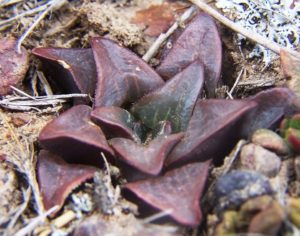
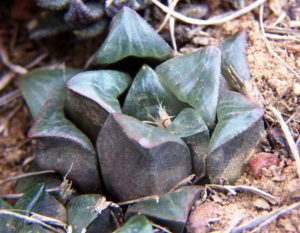
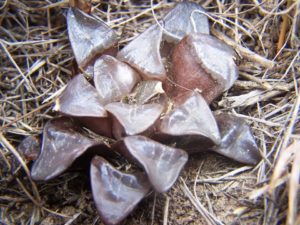
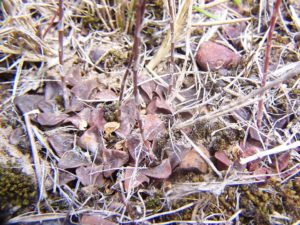
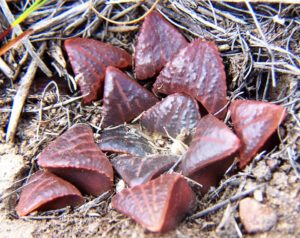

6. Contiguous
16. 2019.5.20 – The following plants were in bud in July to indicate a September flowering. North of this location is a large area with a lot of mirabilis and only one lot of retusa and again the retusa does not share the same space as any mirabilis. I need to find a word for that as something like sympatric or co-occurring does not quite fit. Haworthia habitats are probably characterised by their mixed-upness :). Small scale fragmentation. I will add a picture here of a habitat that is a small narrow fringe of exposed shale – the place used to house floribunda until under intensive pasturage everything was grazed away. Across the river is an area where there was a retusoid that was in short shrubby vegetation now being encroached by taller bush. It is nothing like it was 40 years before. Changes like this can be seen in the span of human life but it is still very difficult to assess just how much does change. The missing word seems to be contiguous – the populations may come so close as to have a common border but not randomly mixing. Otherwise populations may be in close proximity. There are many such inexplicable complexities that we gloss over in trying to understand nature. This mystery I am trying to explain is not going to be resolved in the next post or several thereafter – it will take all the pictures. By which time we will have forgotten where we started?
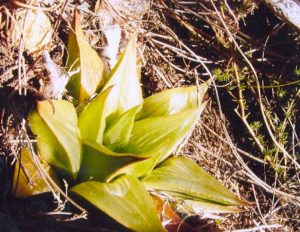


17. 2019.5.20 – This is from populations still further north and northwest of Heidelberg taken from before the days of digital camera – sadly. Mirabiloids seem to be absent and so is floribunda. But this is missing from the whole argument and tack … it seems I have not stated, or not states strongly enough, that Haworthia retusa is a single species incorporating the main elements H. turgida, H. mirabilis, H. mutica, H. pygmaea and H. emelyae. I am forced to include H. floribunda although that then leads on to many more seemingly improbable connections. What we have is a single gene pool represented by a large series of populations broken up on the basis of geographic space, local geology, aspect, slope and altitude. A major driver is two flowering periods among the populations; one is early spring and the other late summer early autumn. A significant point is that each population is discrete and seldom indeed can we identify a freely mixing population of two different species. While a whole additional set of names may be needed for the enthusiast and collector, it does not actually make sense to generate Latin binomials that just touch on some of the variability seen within populations and between. Five names is quite enough for practical purposes while for a collector or grower many more are useful. For a strictly botanical record one may be a true reflection of the state?
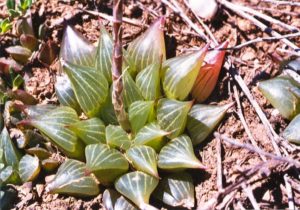

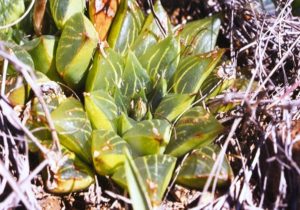
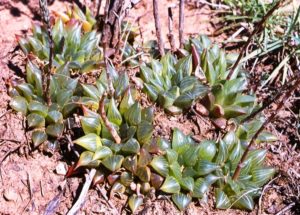
18. 2019.5.21 – From immediately south of Tradouw Pass. This population puzzled me for years. Inside the pass itself in 1970, were cliffs clothed with turgida retusa. Then the road was re-cut and the cliff faces destroyed. Westwards was the road to Zuurbraak with steep riverine vegetation. These cliffs were shale and could have held many mysteries. They were cut away too. I am not sure thus just where H. mirabilis may have been in the vicinity but these plants are practically certainly a consequence of a hybridization between the mirabiloids and the retusoids. These pictures were taken in March when the plants were flowering. Retusa’s flower in the spring.
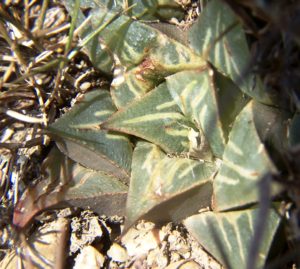
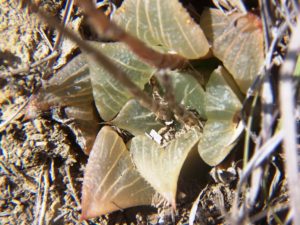

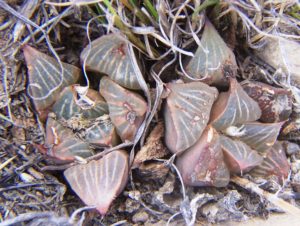

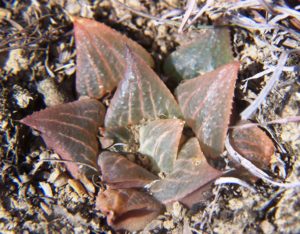
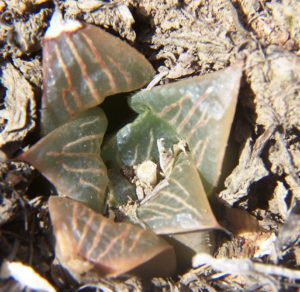

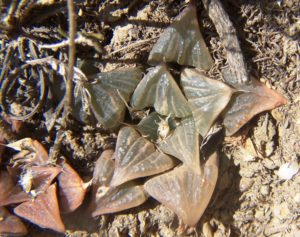
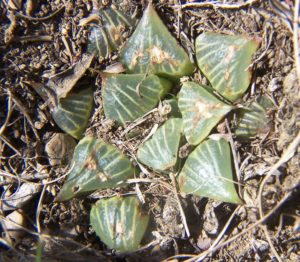

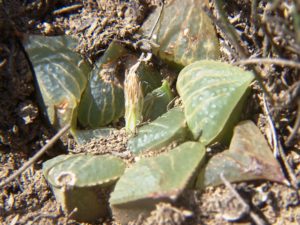


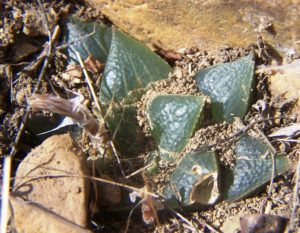
Jaap Viljoen: Bruce what would you call them? Due to farming activities there are not many left.
Bruce Bayer: Jaap – I am sure someone has coined a name for this all ready? AND I cannot deny it is very difficult to answer the question. Botany does not provide for this. I could say H. mirabilisXretusa, or H. retusa Tradouw. My suggestion would be that the Haworthia community through one of the Societies (where Aloe, Haworthiad and others have been very tardy in supporting any suggestion of such an idea) just concede that the formal botanical Latin systems does not serve common interest, and establish a secondary naming system. Use that existing coined name but dot not fool anyone into thinking it means anything more than a collector item. As I recently posted – it is just not sensible to use a formal Latin botanical name because most of the plant forms found in this population can be seen in many other populations across the whole southern Cape from Caledon to Great Brak – and north of the Langeberg. We can’t live with our head in the sand about this issue forever?
Jaap’s question about a name for these things is important and just what this group about. For the collector, the name is connected to what the plant LOOKS like. To the botanist it is where the plant is in the history and evolutionary pathway, what its DNA is or tells them and perhaps a lot more depending on some discipline or other in the subject. This is another set of pictures from S Tradouw – same place as previous but taken in September. I have another set of 34 pictures of seed grown plants and no two plants look the same. Perhaps members can explain to me what single name is going to serve a meaningful purpose. Nearly every single population presents this problem. What riles me about the DNA sequencing I have been involved in is that single specimens are taken to represent “species” in a sequencing project based on an existing classification. Perhaps someone has done a study where sequencing has been done on a raw set of unnamed specimens replicated from one population as well as representing populations across the gamut of the group in question? I have yet to learn of it.
A very pertinent question by my friend Jaap – what do we call plants from south of Tradouw – when no two plants are the same? It raises the question of the definition of the species and the establishment of identity. In the present informal systems where commercial growers and also the very highly skilled observers like M. Hayashi have great expertise, there will be a name – but that name will not fit all the variants in the population nor the endless number of variants that will emerge among seed grown plants. In the present formal system it should be H. mirabilisXretusa and the locality name should be added, as there are other such hybrids (single or in populations). In a system based on a more rational definition than is currently used, I think it should simply be H. retusa!
Jaap Viljoen: As I expressed my views before about all the discussion on names, one thing will never changed. You can give a Haworthia any name you like, but the one name that is factual is the locality. If you want to call these plants a mirabilis or retusa, and it makes you happy it is up to you. If you want to make all the so called botanist happy, do so. These plants will always be known as the base of the Tradouw Pass population. However they will all be extinct very shortly.
Bruce Bayer: The problem here is that the vast majority of botanists do not know what taxonomic botanists do. Taxonomy is seldom good science and modern taxonomy revolves entirely around DNA sequencing that my experience suggests is far short of ideal. While I agree with Jaap that locality is so vital for anyone who wants to know about the plants. For a botanist the name H. retusa would be best and they would additionally need to know what the relationship is between the typical retusa element and the mirabilis elements. Note that the practice of using the name H. retusa typica fell away many years ago in the favour of H. retusa retusa – both trinomials! ♦
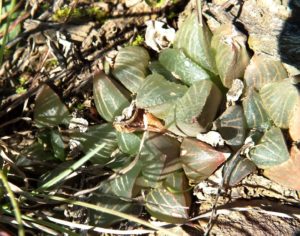
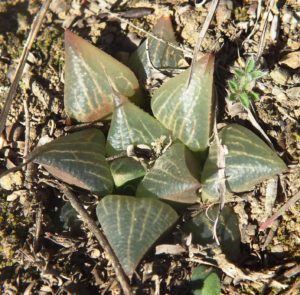


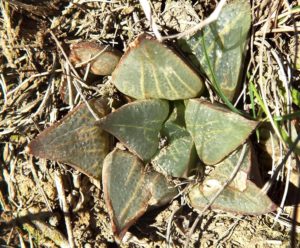
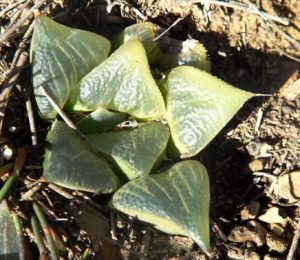
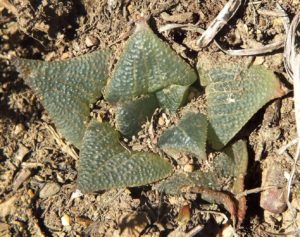
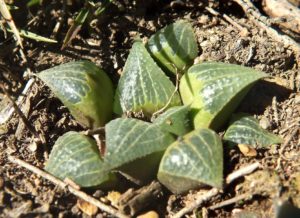
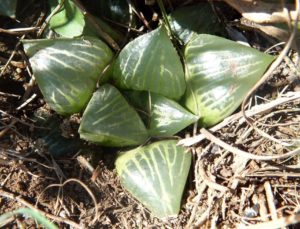
7. Floribunda spots
19. 2019.5.23 – On more than one occasion some collector or other has sought retreat from an argument about species to some purported botanical expert (i.e. someone with a botany qualification) to support their wild guesses and assumptions about names. Too often such persons simply assume they know more about classification than any botanists might. Here are two plants of H. floribunda in a population that differ in having these strange white spots in the leaves. According to the H. groenewaldii argument it must surely be a new species. What about all the other plants in the population? Far more significant is that these plants are in a floribunda population not far from where “H. groenewaldii” (= H. mutica) occurs, where occasional plants have significant leaf spotting too. H. floribunda is very closely entangled with the greater retusoid complex where groenewaldii is secondary to the mutica element in that complex. Those spots must have a significant connection. ♦

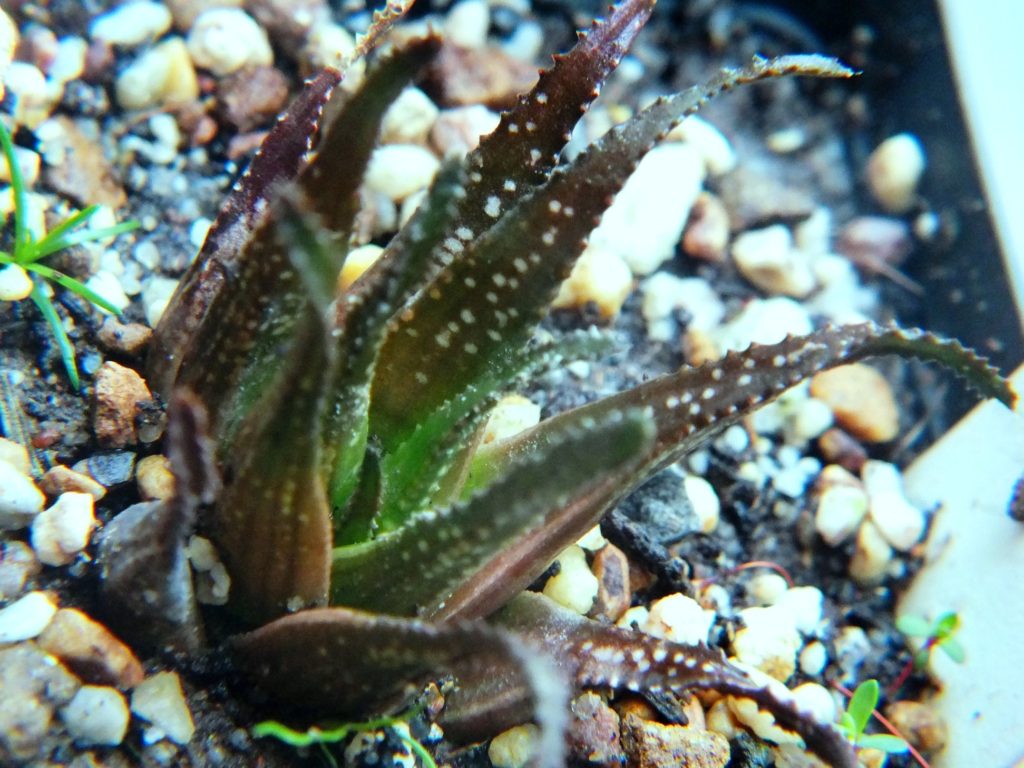
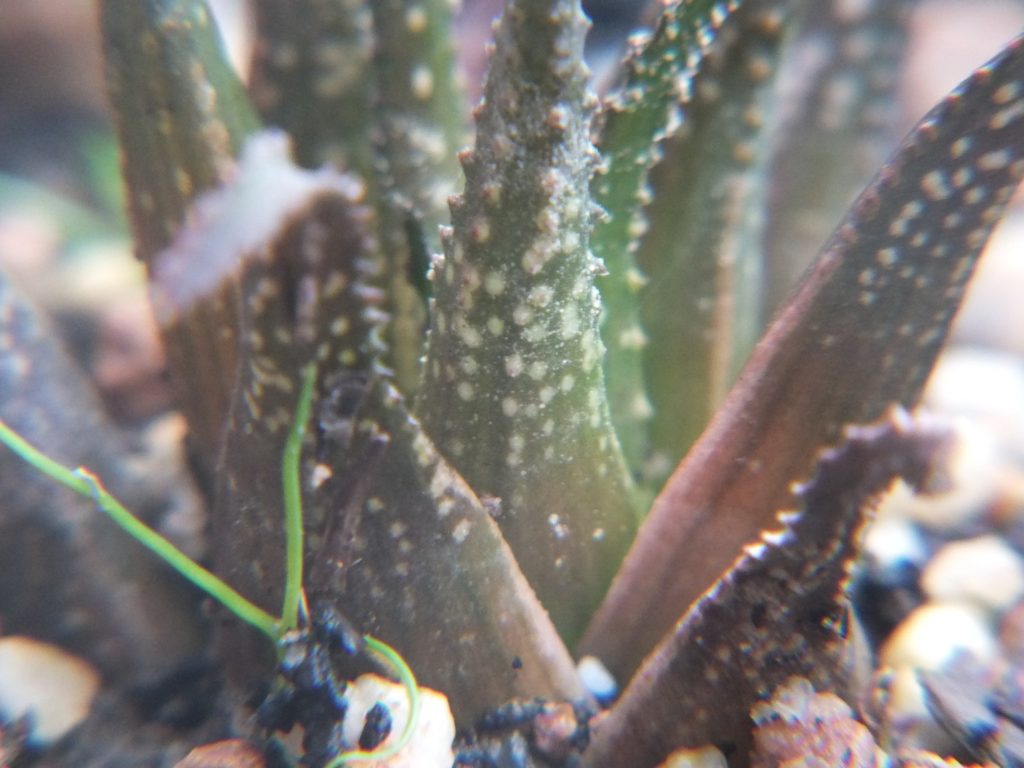

8. SE Tradouw
20. 2019.5.23 – The next pictures are a consequence of Jannie Groenewald’s (H. groenewaldii fame) activity and I am truly grateful to a remarkable young man fully absorbed in the wonder of plant life. These will be from 4 populations southeast of Tradouw. The first is mirabiloid flowering autumn. The others are retusoids (flowering spring) in the context of sandstone populations and populations in the shale, clay and even limestone southwards. It is worth noting that the habitats are near identical and yet occupied by either of the ‘species’ and never both.
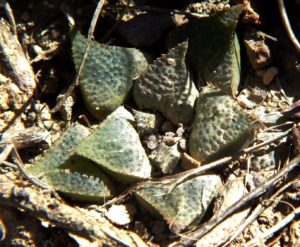

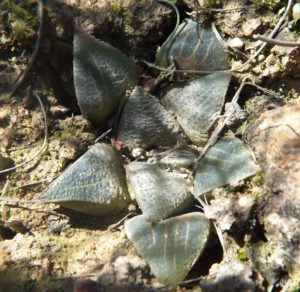
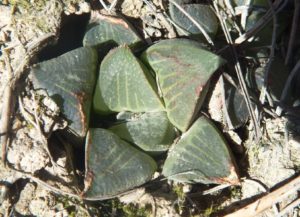
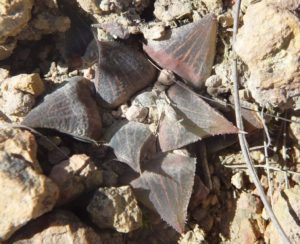
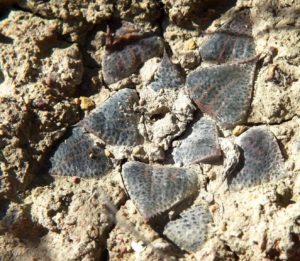
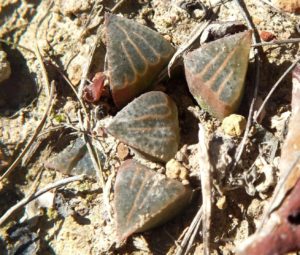

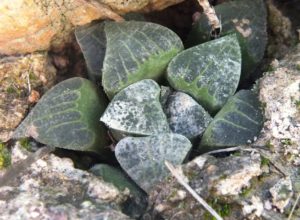
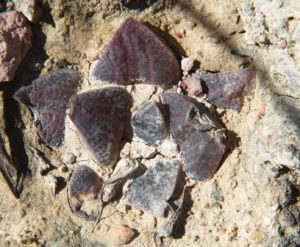
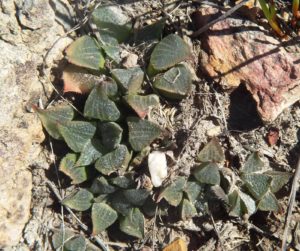
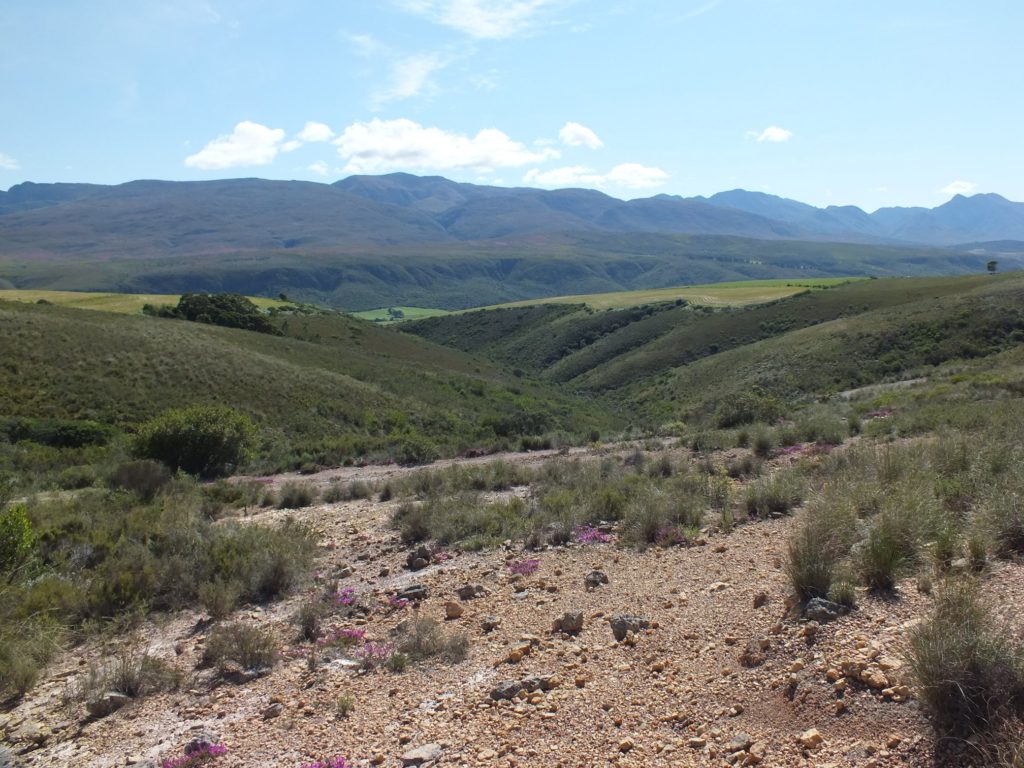

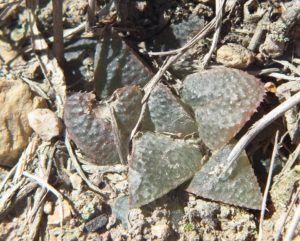


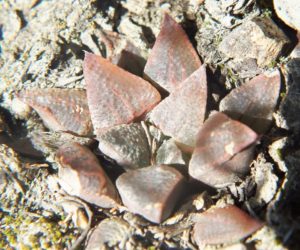
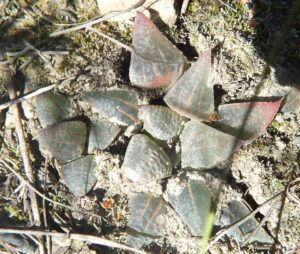
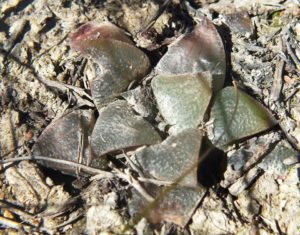

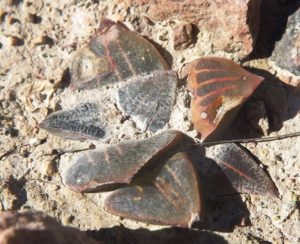
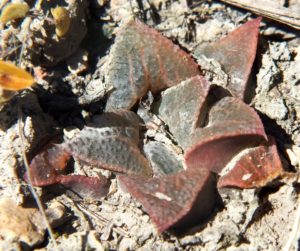
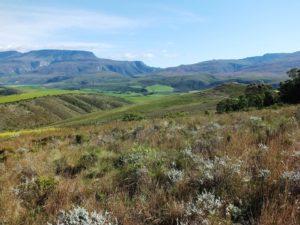
Jaap Viljoen: Again, I cannot help to smile about the Groenewaldii population. Mostly to Jannies frustration when we visit the site and I continually asked him to show me a real Groenewaldii. The percentage of plants of which the dots cover more than 50% of the leaves is so small, that the population could hardly been called Groenewaldii. With all the visitors these dotted plants become even less. Viva to the Jannie Groenewald haworthia population in Buffeljags.
Bruce Bayer: Yes Jaap, the fact is we looked across the valley and I said these plants must be there too – and they are and spots are very rare. But there is much more to those spots too.
21. 2019.5.24 – Another population from southeast of Tradouw. Note the presence of plants with rounded leaf tips and dark coloration. Again huge variation and as was done in the days of Smith and von Poellnitz, there are the ingredients for several species!
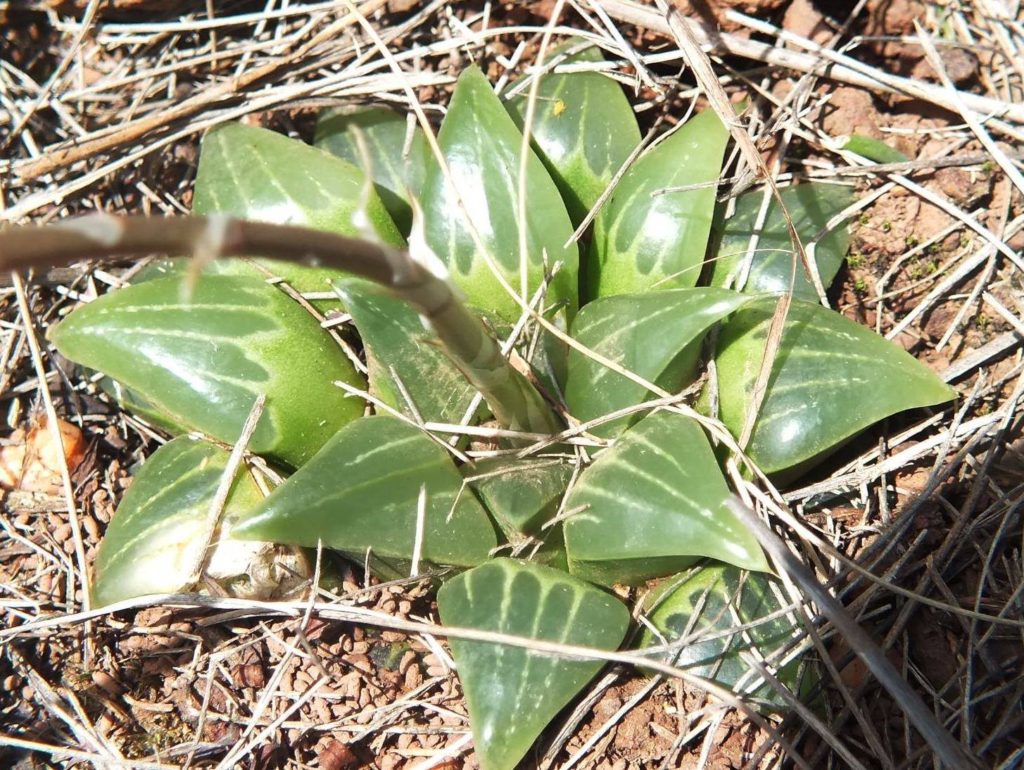
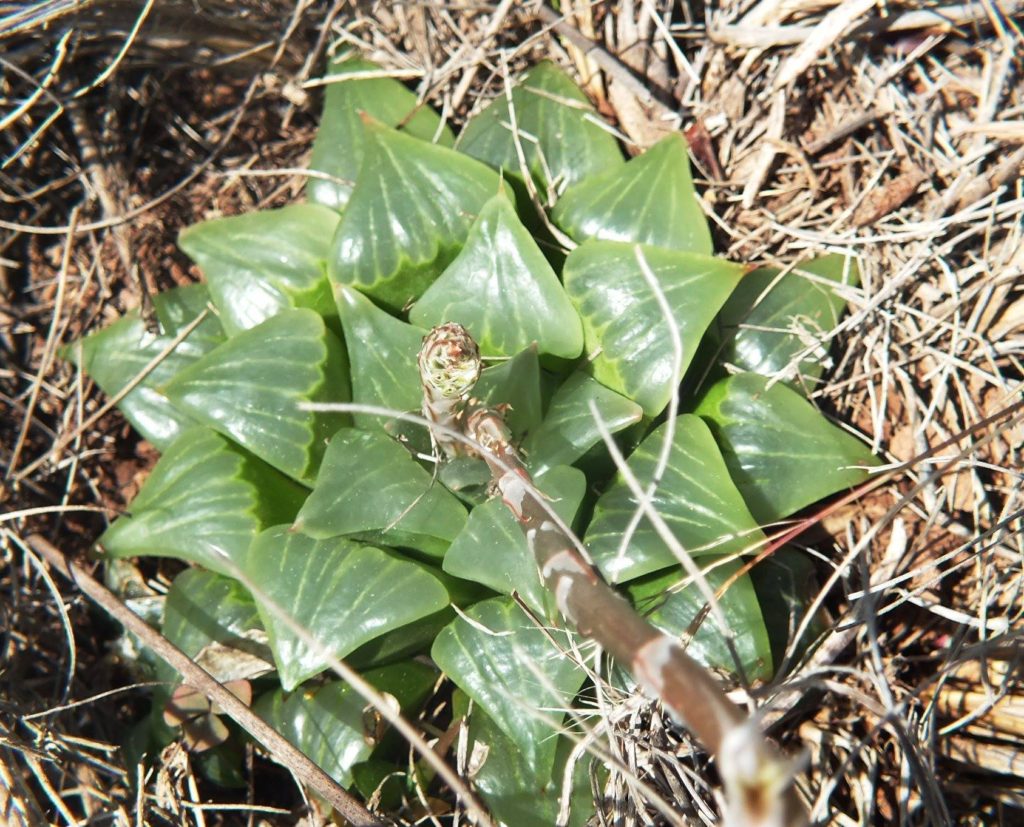

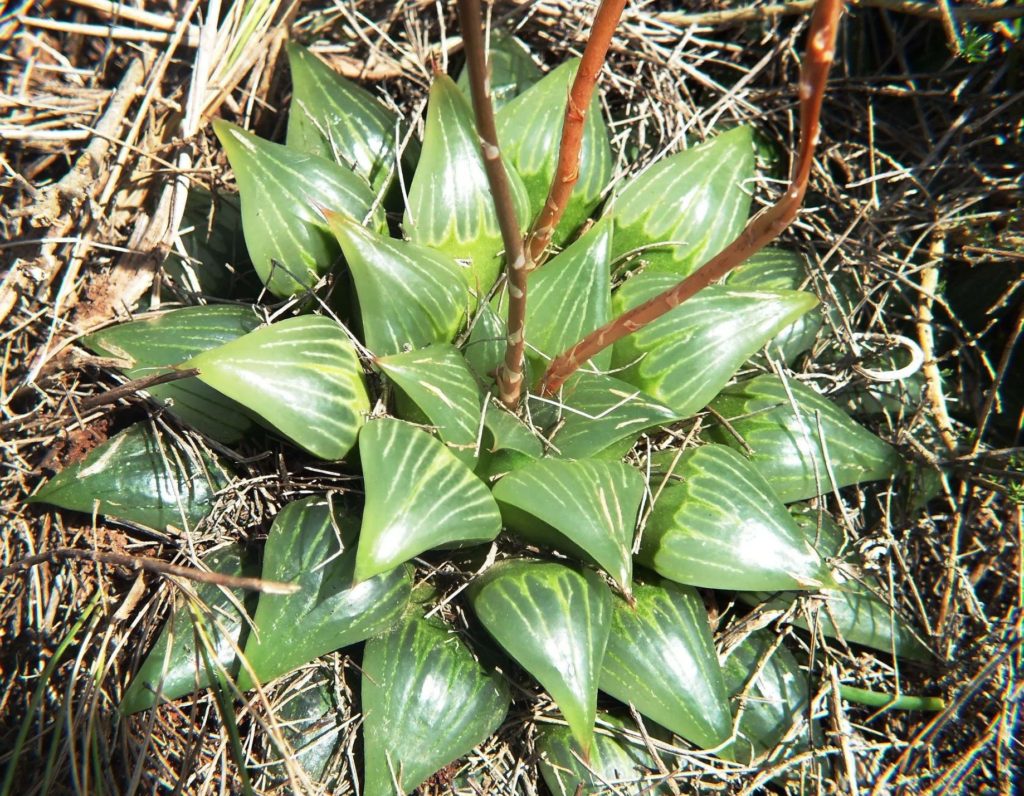
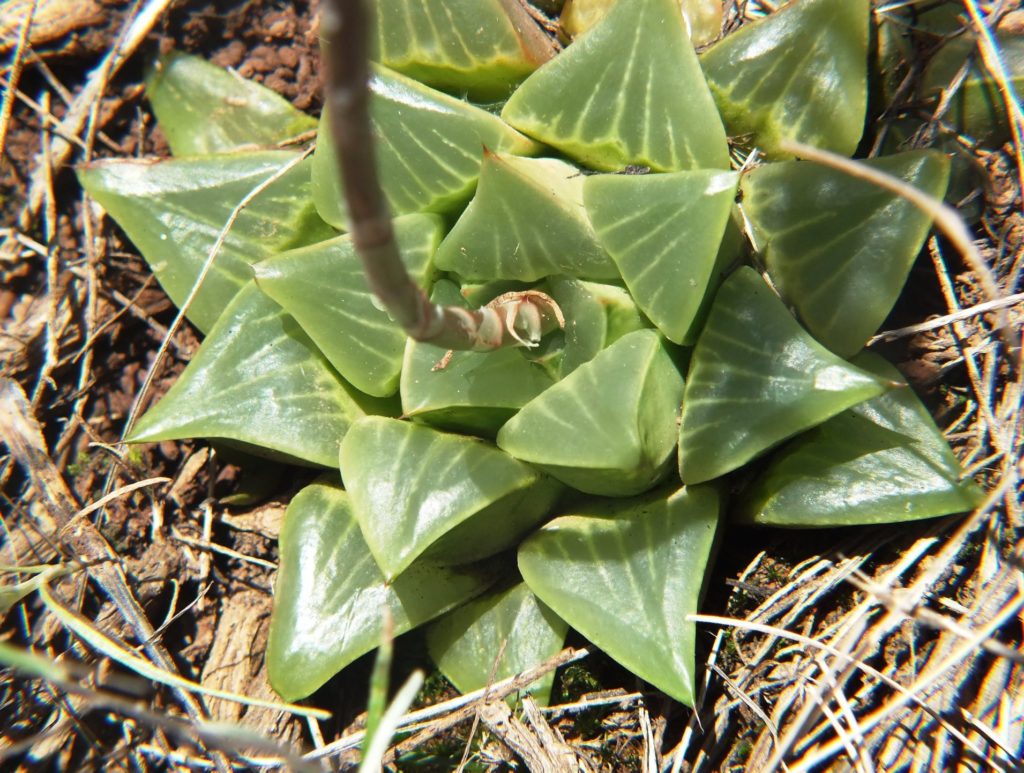


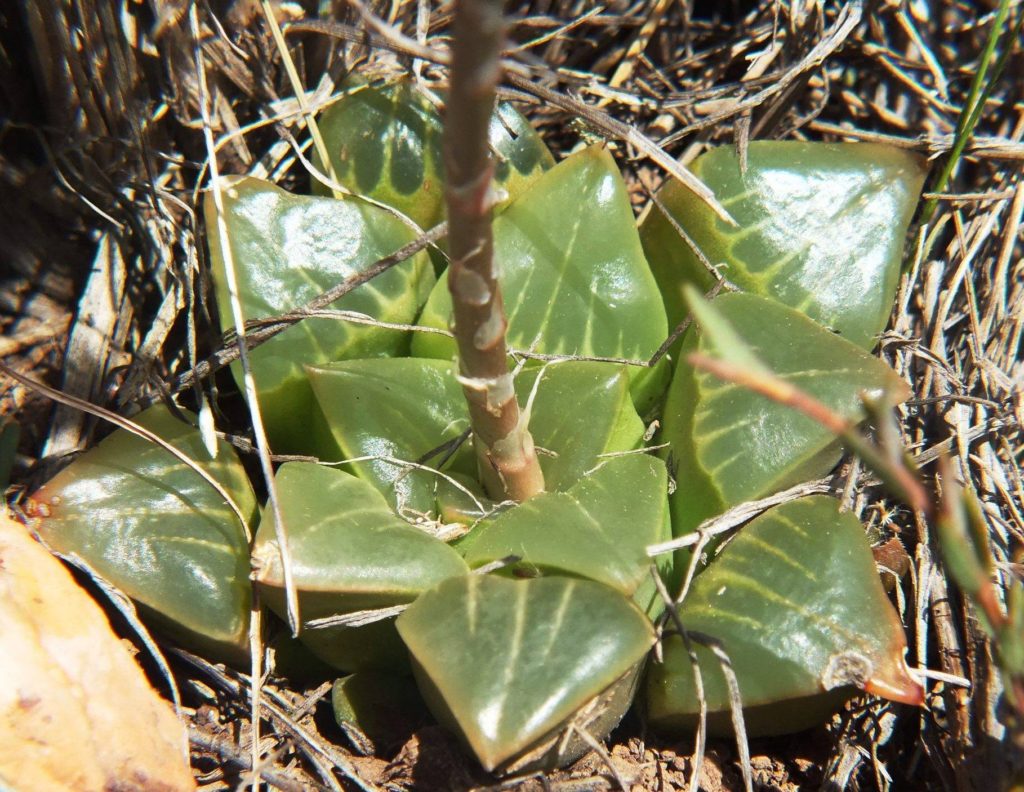
22. 2019.5.25 – Mulling about how to proceed! Past experience is that it is difficult to get readers to keep all the variables and all history in mind while trying oneself to do that. I have posted 2 sets of retusoids from southeast Tradouw. Here is another. I will forego the next 3 because, while they tell the story of variability, they add nothing new. But what is significant is this – with these south of Tradouw populations, there are another 22 very similar localities/habitats in all, separated by various distances from 200m to a few kilometres, 22 populations drawn from 3 species. What has happened to keep the species apart? Ponder this while thinking just how coherent family, genus, species distributions are worldwide? Locally too. The guesses we make about seed distribution and spread do not seem to amount to much.
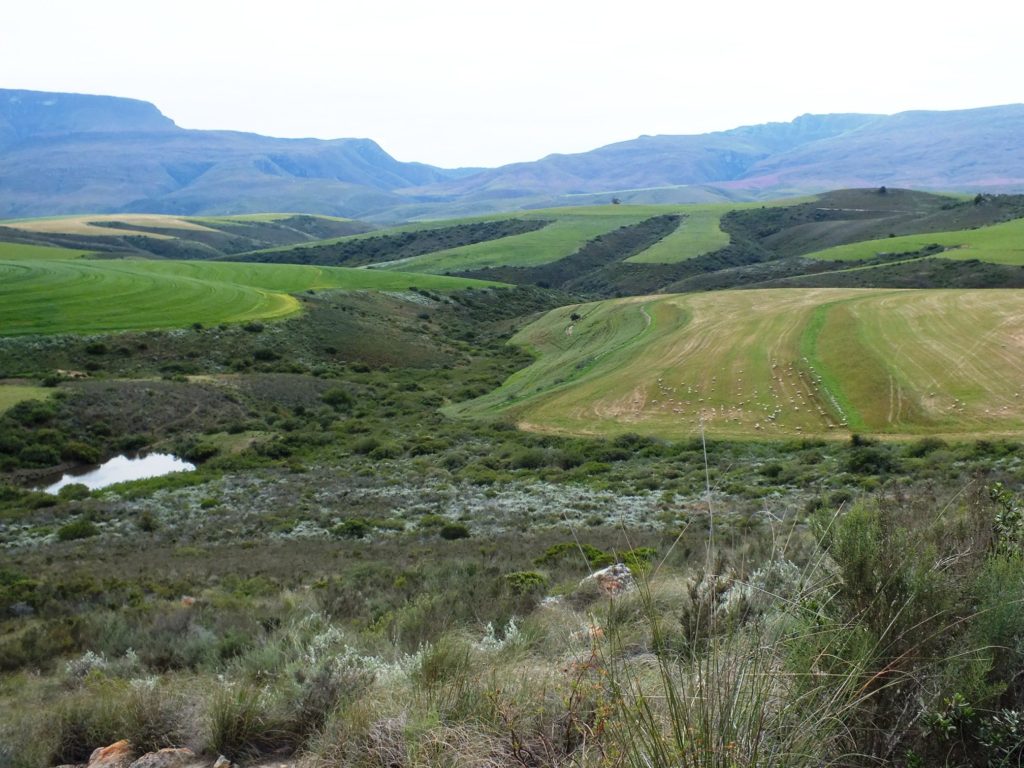
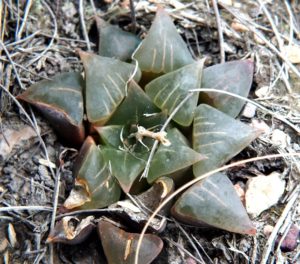

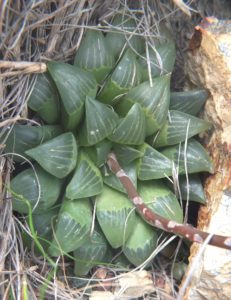
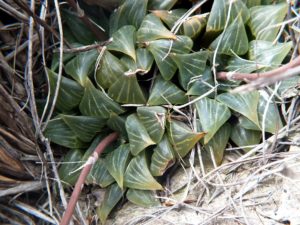

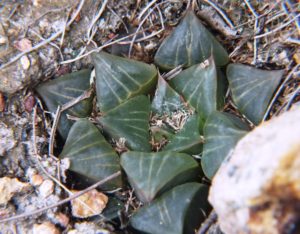
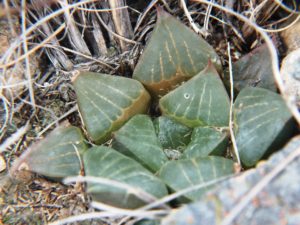
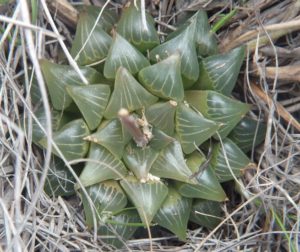
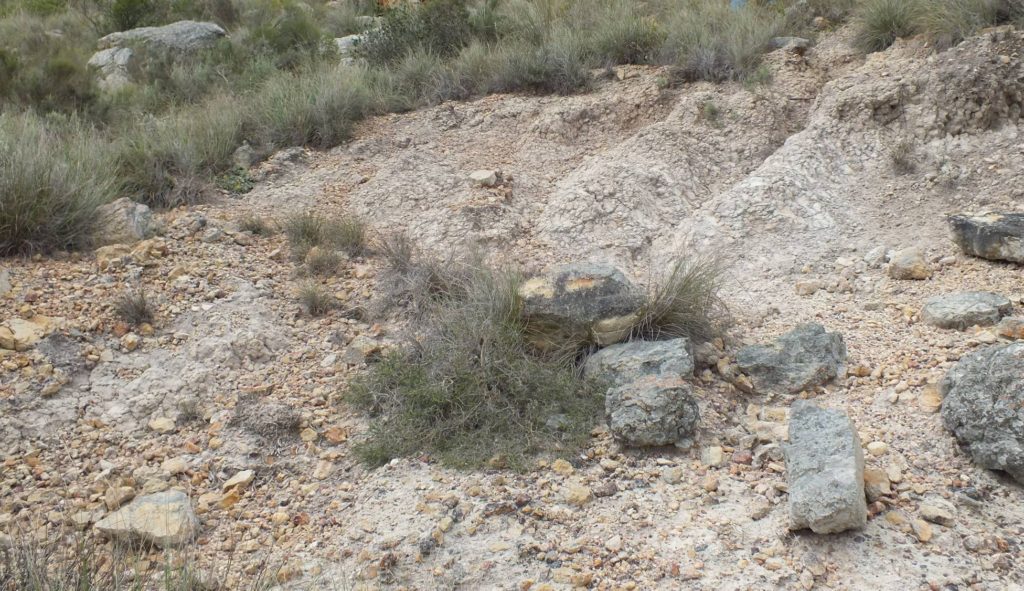
Flowering time. I have said that this is a significant driver WITHIN the retusa complex. The mirabiloids and floribundoids flower in late summer/early autumn, while retusa/mutica/pygmaea flower in spring. Nevertheless, despite this difference, one finds hybrids between these elements despite expectation to the contrary. I have seen hybrids of floribunda in the wild with retusa (typical retusa and turgida), pygmaea and mirabilis. In one remarkable instance that also demonstrates a quite amazing inexplicable spatial separation, mutica and mirabilis are separate and confined to immediately adjacent areas, of exactly the same rock, soil type and corresponding general vegetation (contiguous). The same was seen in such absolutely adjacent mirabilis and retusa. Not even extending further into what appears to be identical terrain. There was a hybrid on the point of meeting in each case, despite gross differences in flowering time. I observed this hybridization with H. floribunda and H. mirabilis too, but at least they flower at the same time.
A similar case with Haworthiopsis pungens and H. scabra. H. pungens confined to a quartzitic and pebbly slope with minimal associated vegetation. About 75 meters away, a single cubic boulder of conglomerate about 1m width and depth, in dense proteoid vegetation. On top of this were several plants of H. scabra and several obvious hybrids where H. pungens was the other parent.
There are populations such as Kransriviermond, the one I mentioned south Heidelberg, and the one at Tradouw that seem inarguably to be “hybrid”. There are many similar cases that strongly suggest such “hybridization” that is really more likely to be a recombination of diverging elements of the same species. It has clearly happened in the past, and often too. Other observations have been of odd flowers outside of the expected flowering windows of the species. Remember the plants are self sterile. Generally. I have had plants that are self-fertile and produce viable seed.
23. 2019.5.28 – Moving a little further west at Tradouw there are many mirabilis populations that will no doubt get a species name. Just how beats me because no two plants are the same across all the populations. This area is probably the oldest and highest remnant of an old sea bed? Steven will have to explain the geology of the S Cape for us.
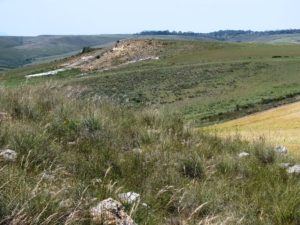

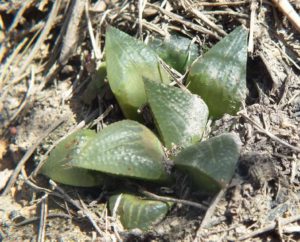
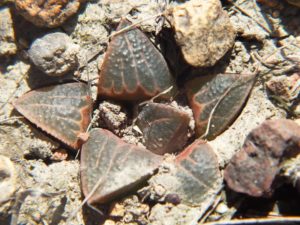

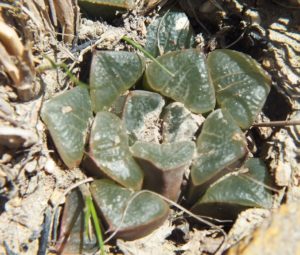

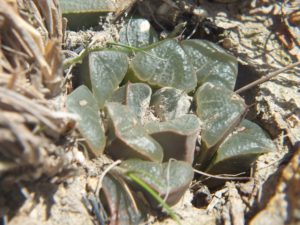
Reviewing all these Tradouw pictures leads me to say … I am not trying to prove anything. I am just pointing to an end point of 80 years of questioning the identity of these amazing plants. My conclusion is that these Retusoid things are but one species and botany would be better off if someone competent seriously undertook to truly find out where species stop and start. Retusa, mirabilis, mutica, pygmaea are unquestionably one species and the lesser like wimii, breueri, vincentii, jakubii, bobii, esterhuizenii are not necessary to even consider as they are but variants within a much greater complex. While groenewaldii is a central binder to them all in a different land form. Elizeae and some other unnamed single elements are highly problematic.
Lawrence Loucka: When you say the lesser names “do not figure at all” do you mean they are or are not part of the single species?
Bruce Bayer: I mean that it is just not necessary to even consider that they are anything but variants within a much greater complex.
24. 2019.5.30 – Bear in mind when looking at this set of mirabiloids (map location 5). Truer retusoids on near identical habitats fall away of these SE of Tradouw. The green smaller spinier retusoids (caespitosa) are in the sandstone Langeberg Mountains to the north and stop (as far known) at Tradouw Pass to the north. There are only a few populations of the clumping cliff dweller south that continue west. This is the upper drainage area of the Buffeljagsriver. What we are looking at is a series of mirabiloids that have swallowed up the retusoid form. The great variability must bear this out. The summer rainfall flowering seems to be a dominant character. A curious observation is that this area seems to have never been explored for succulent plants either in the mid last century when collectors were so busy – or in more recent times. There are no aloes, gasterias, euphorbias, crassulas, stapeliads, or even mesembs to speak of.
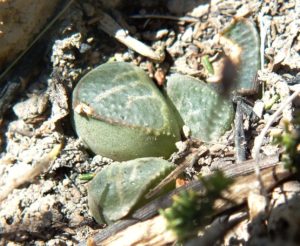
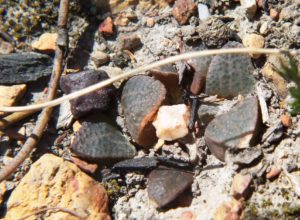
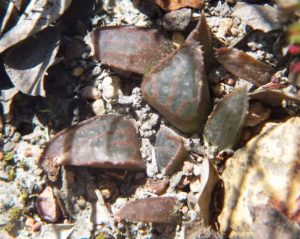
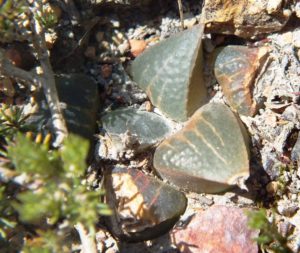


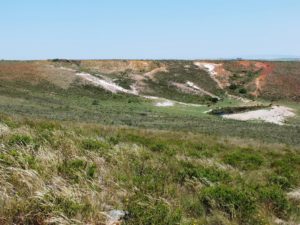
25. 2019.5.30 – Still south of Tradouw – what an amazing array of some of the forms here – and strangely they do not occupy the whole area. So there is quite a vast seemingly suitable habitat with only a small piece of it considered livable for the plants.
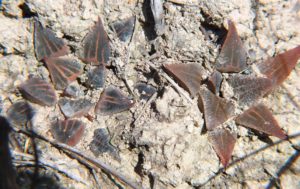
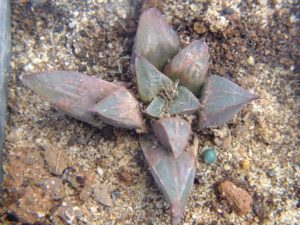
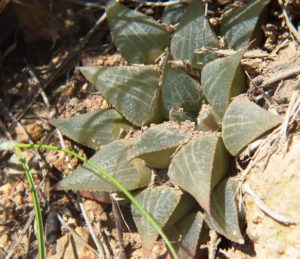
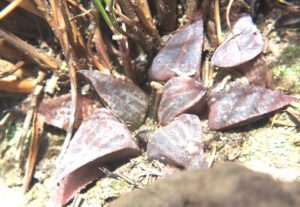
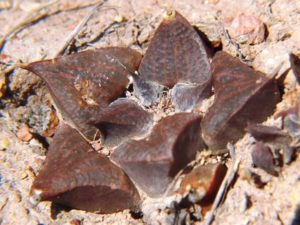

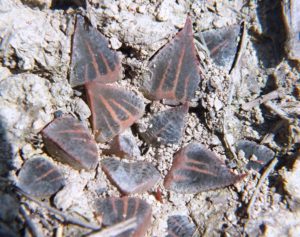


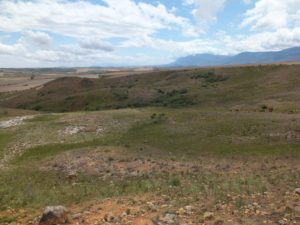

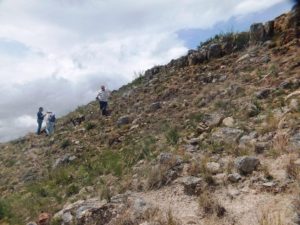
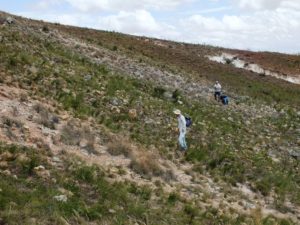
26. 2019.5.31 MBB7917 – This South Tradouw area is a wonder – I have many more pictures from this confined population. How my taxonomist friends accommodate this variation in their wondrous ways is above me.
Lawrence was with me and he might have more pictures = perhaps not this specific population. And I’m not done with local variation by a very long shot. Do note the morning dew and the flower buds in November.
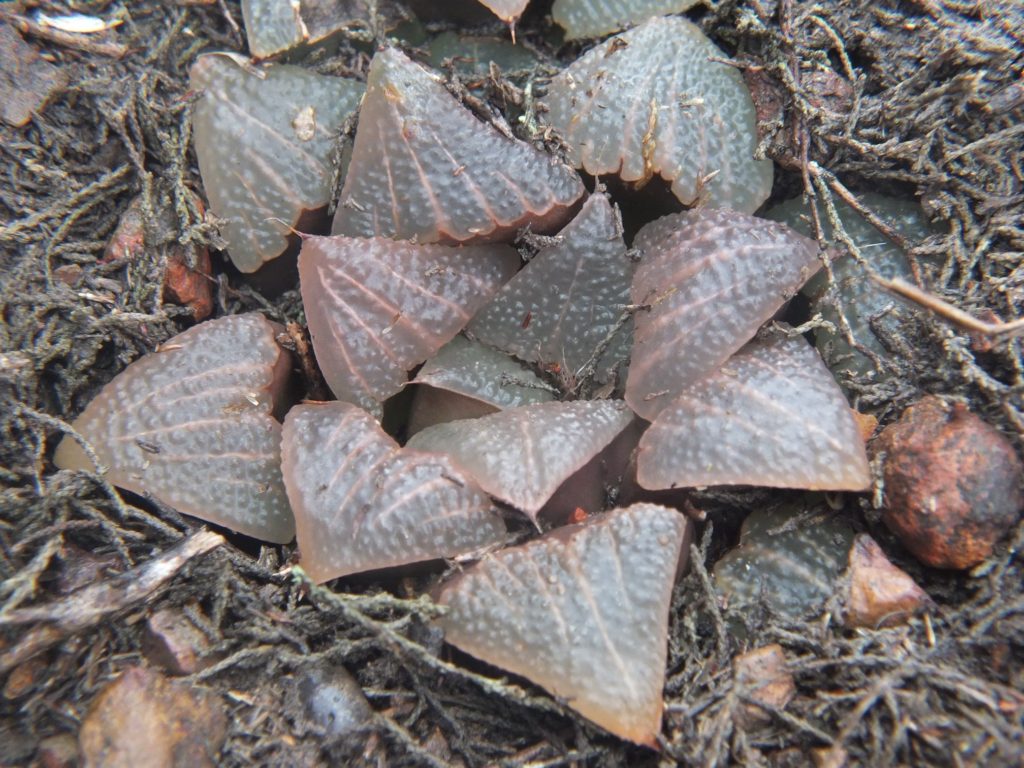
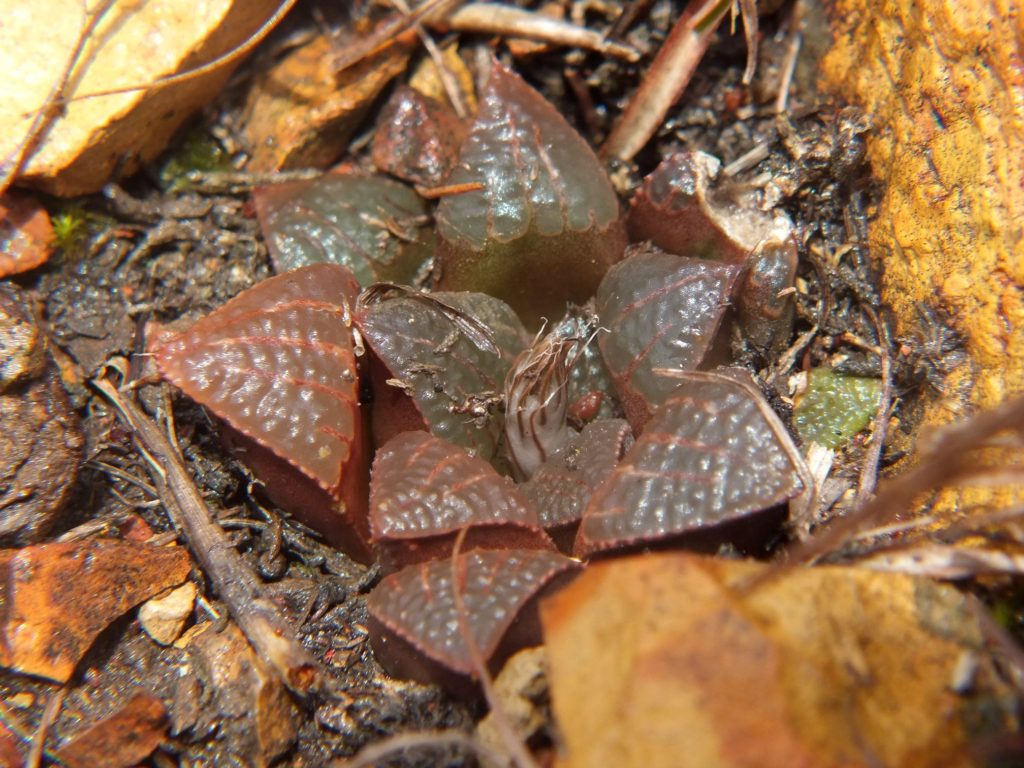
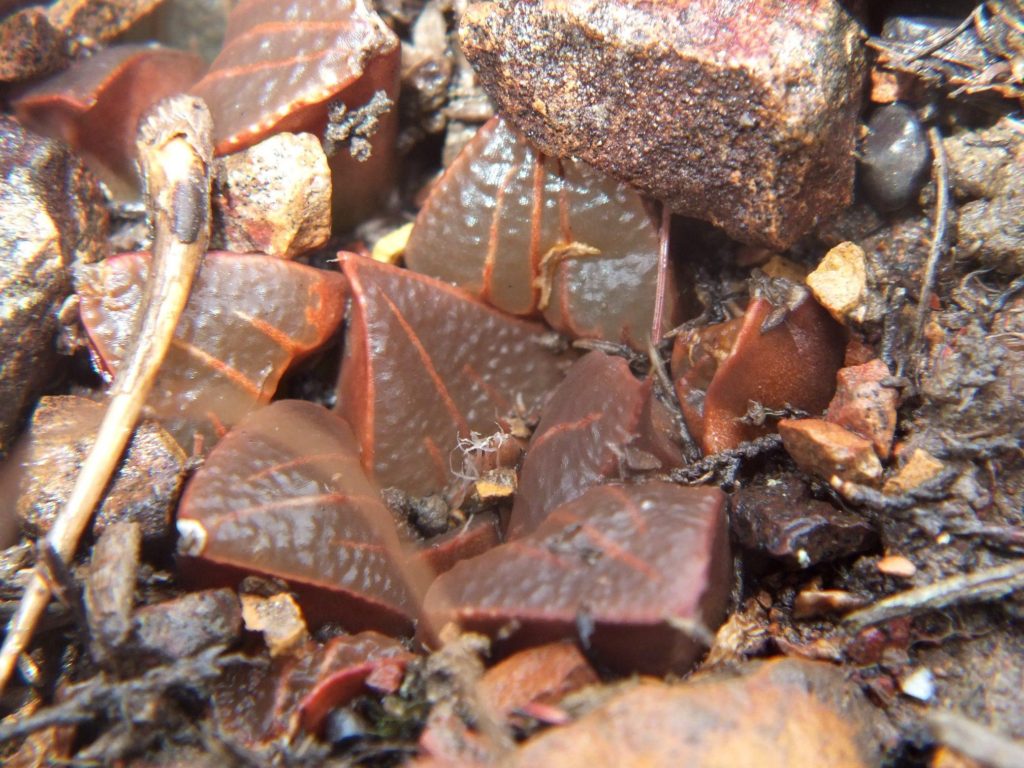
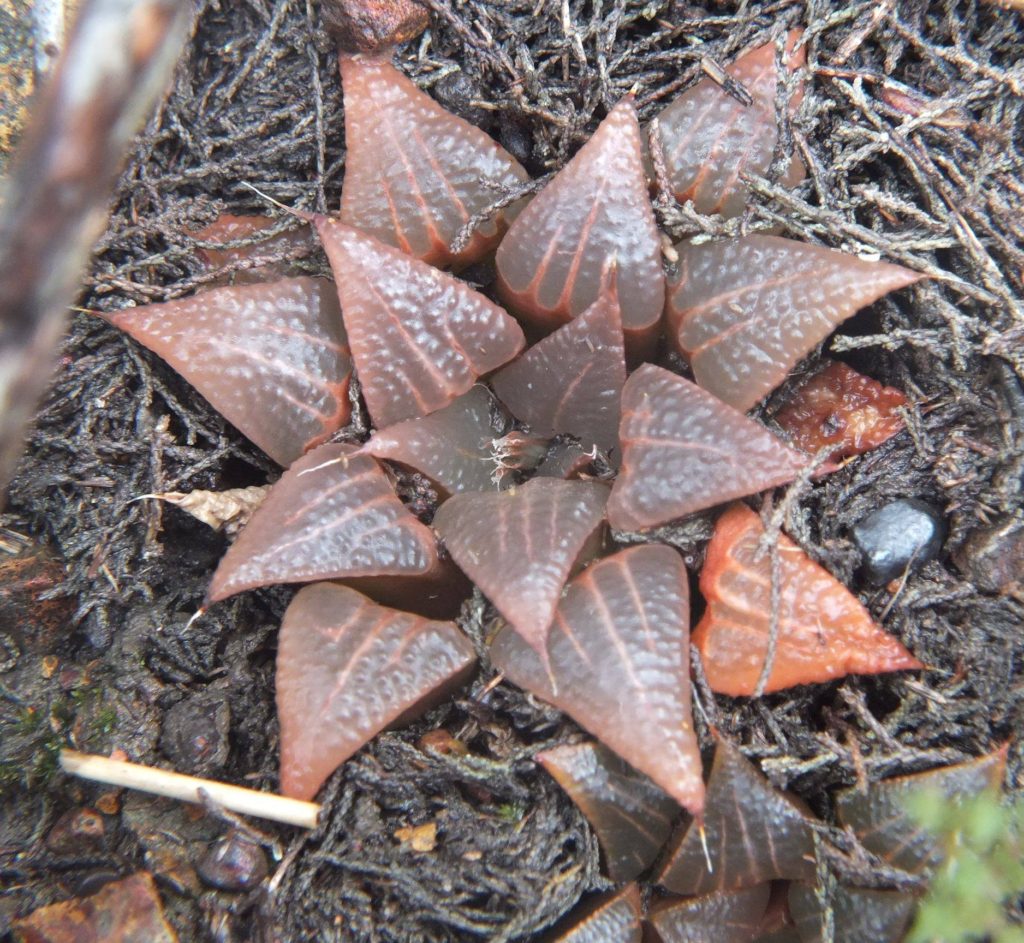
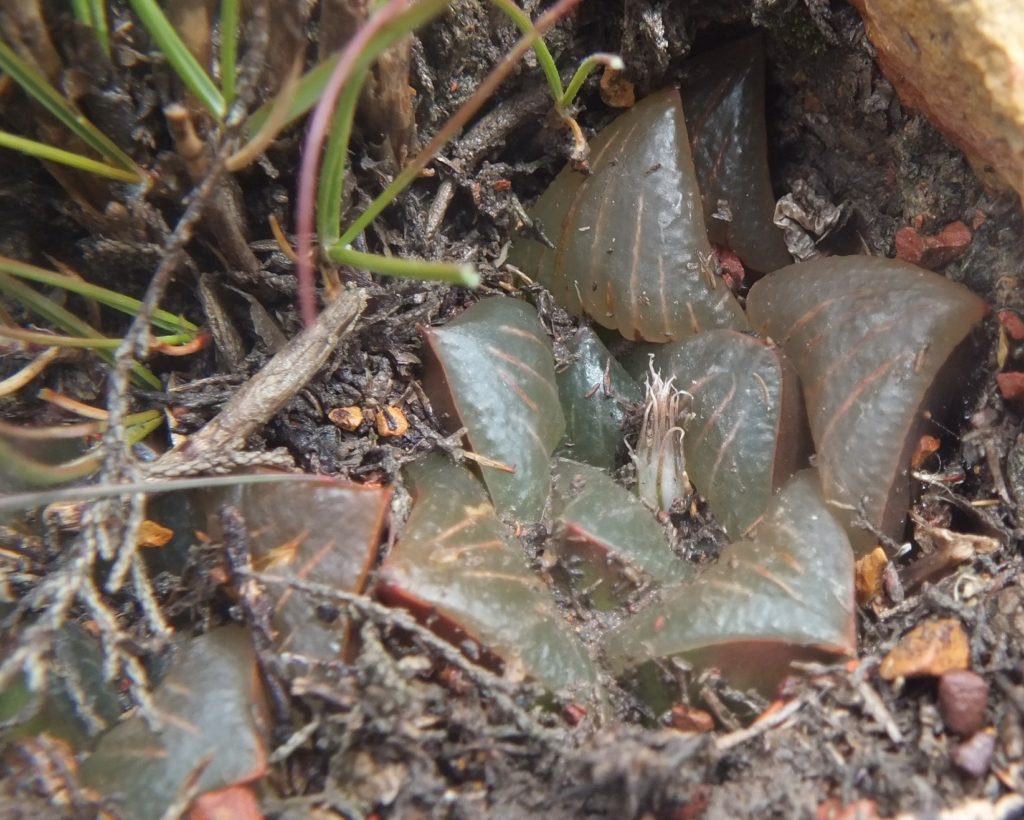
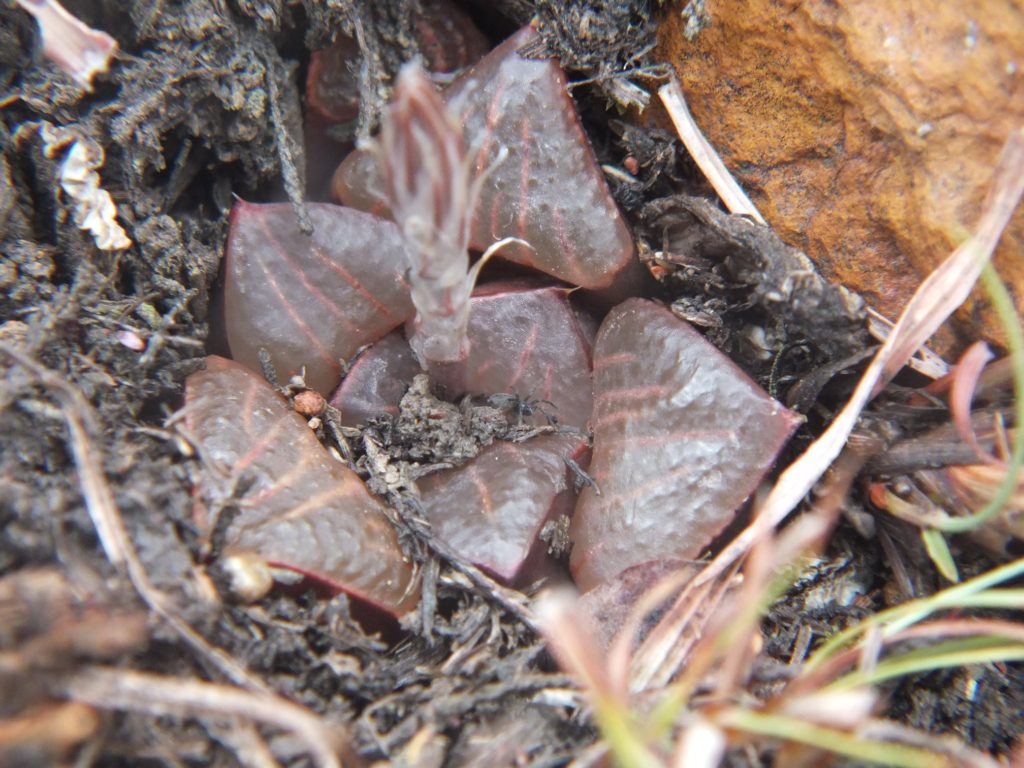
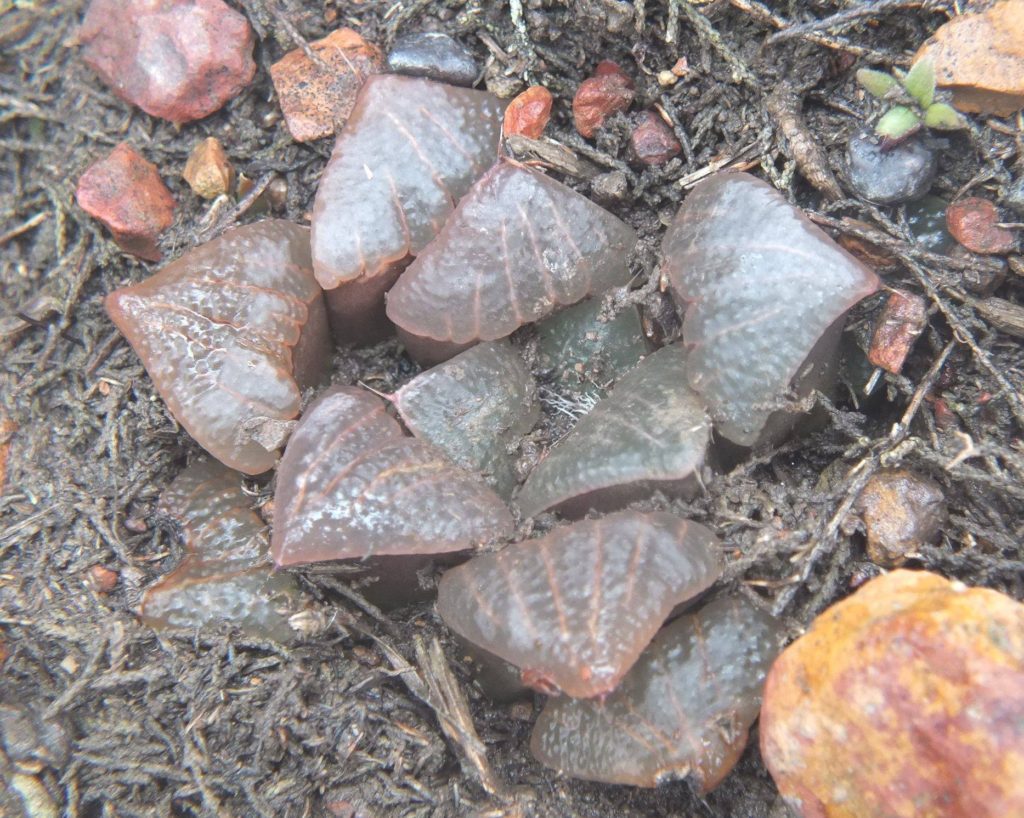
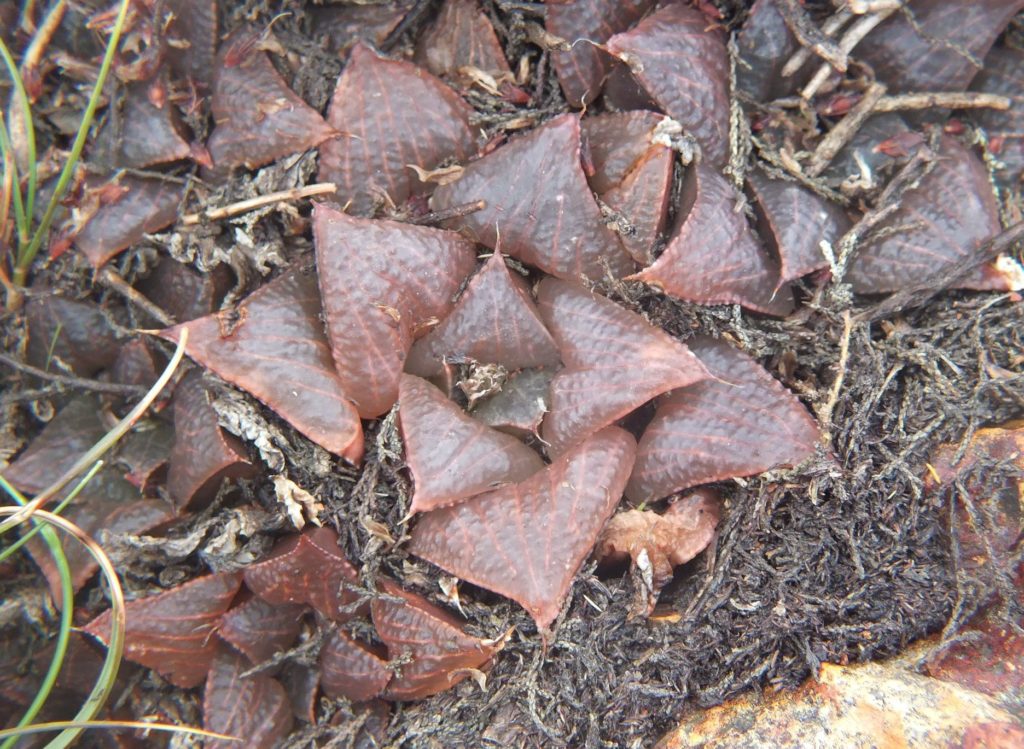
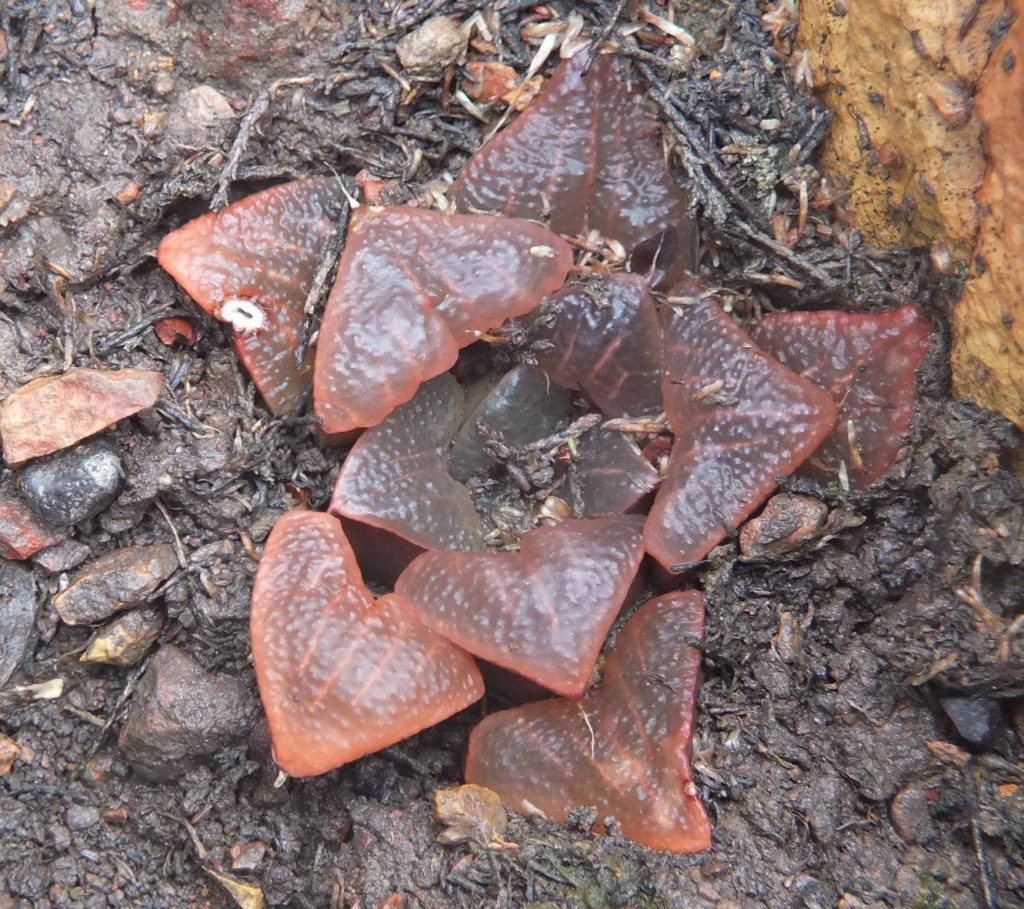

27. 2019.6.1 MBB7918 flowering in January. The habitat has a much grassier element and the clay texture was indescribably different. The plants are more cryptic and less attractive too. Same general map area 5, south of Tradouw.

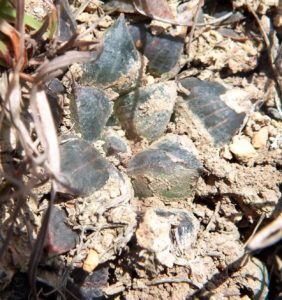
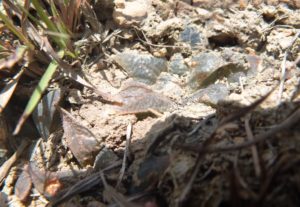
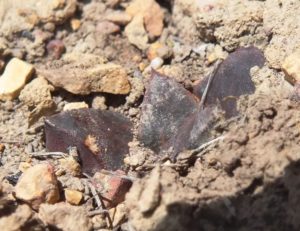
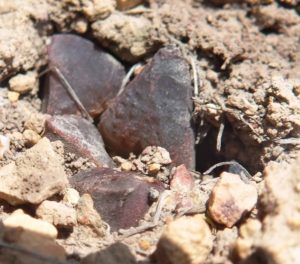
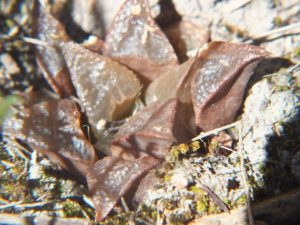
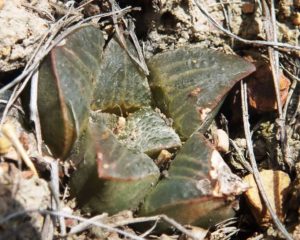
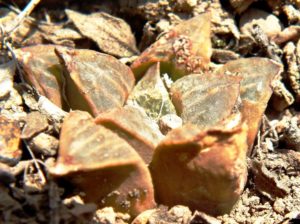

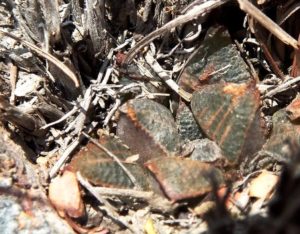

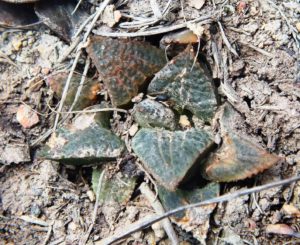
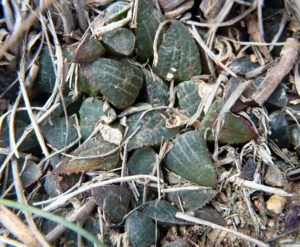
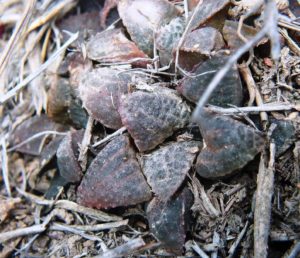
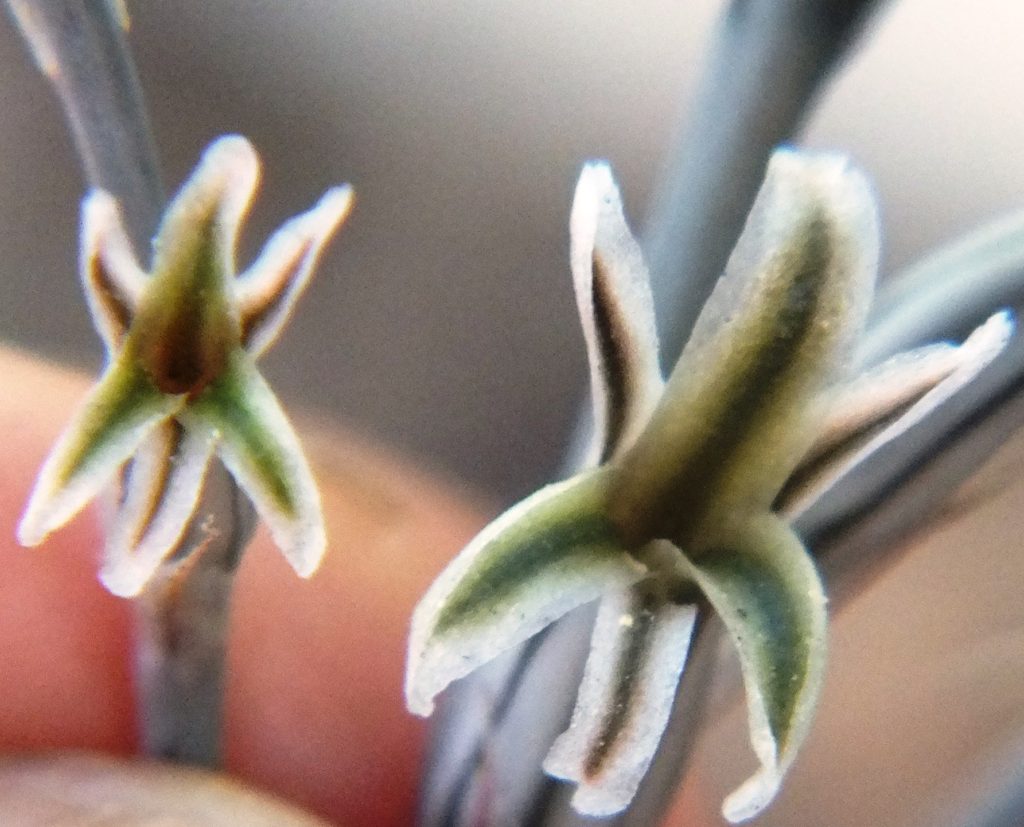
28. 2019.6.2 – Still south of Tradouw and another population. I find it very difficult to leave pictures out. Some of the plants are clumping, some have shiny smooth leaves, others tubercled. One plant was even distichous – it has two huge flower stalks so it is not juvenile. Some plants show the floribunda-like flattening of the leaf ends, with slight twist. Still 5 populations of these “mirabiloids” to go.

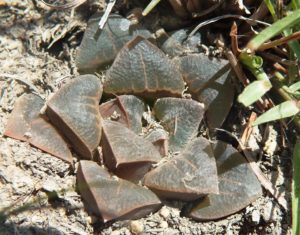


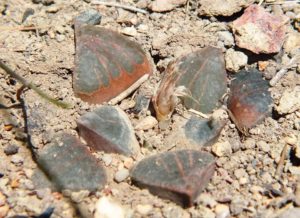
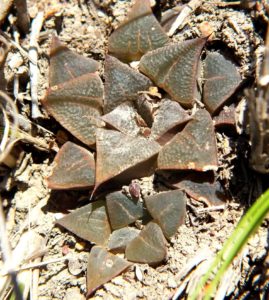
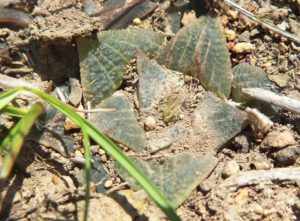




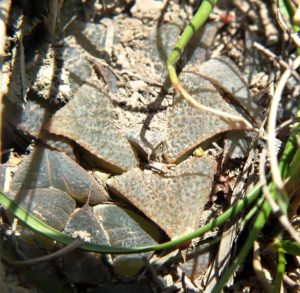
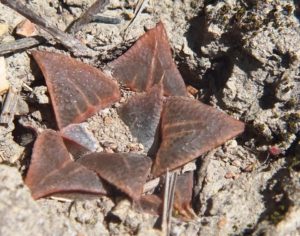
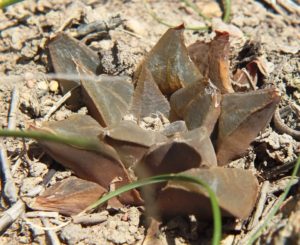



29. 2019.6.3 MBB7955 – Still south of Tradouw observed flowering in November and February. Plants very abundant locally and note the different colour and density of the clay. Retusoid mirabilis?
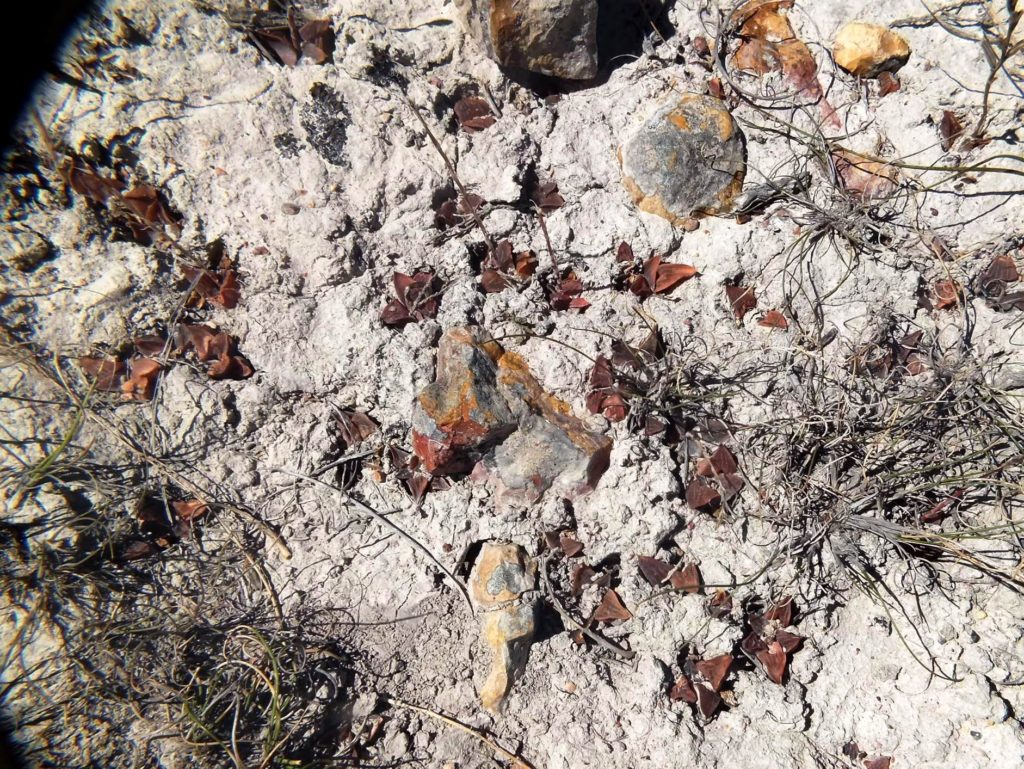
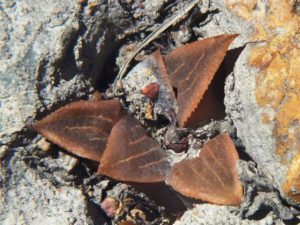
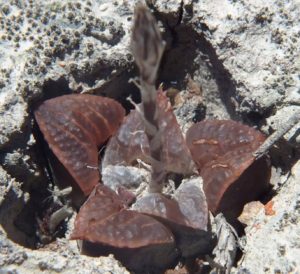
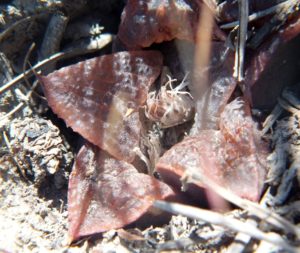
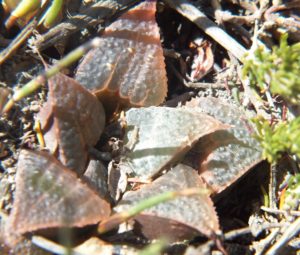
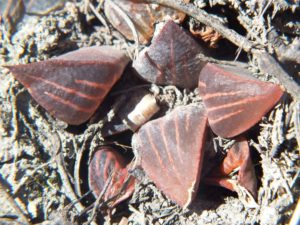
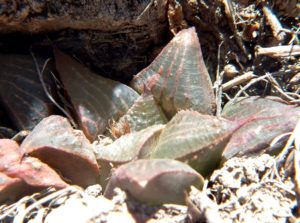
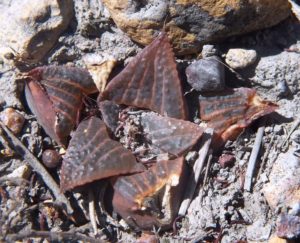


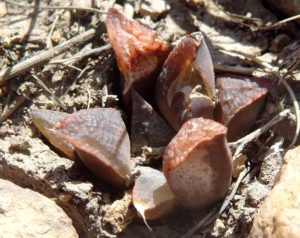
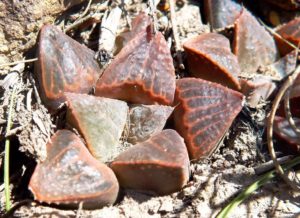
This really is an important image because it brings to mind the whole problem of what is termed the “typological” approach. Names are always attached to a single type specimen creating a crude and false belief that a species can be adequately represented by a single individual. This has completely bedeviled classification in Haworthia where for example a name like “magnifica” can even imagined to exist as a distinctly separate group with the general qualities of the original specimen so-named. The exact same applies to this illustration of H. retusa. ♦
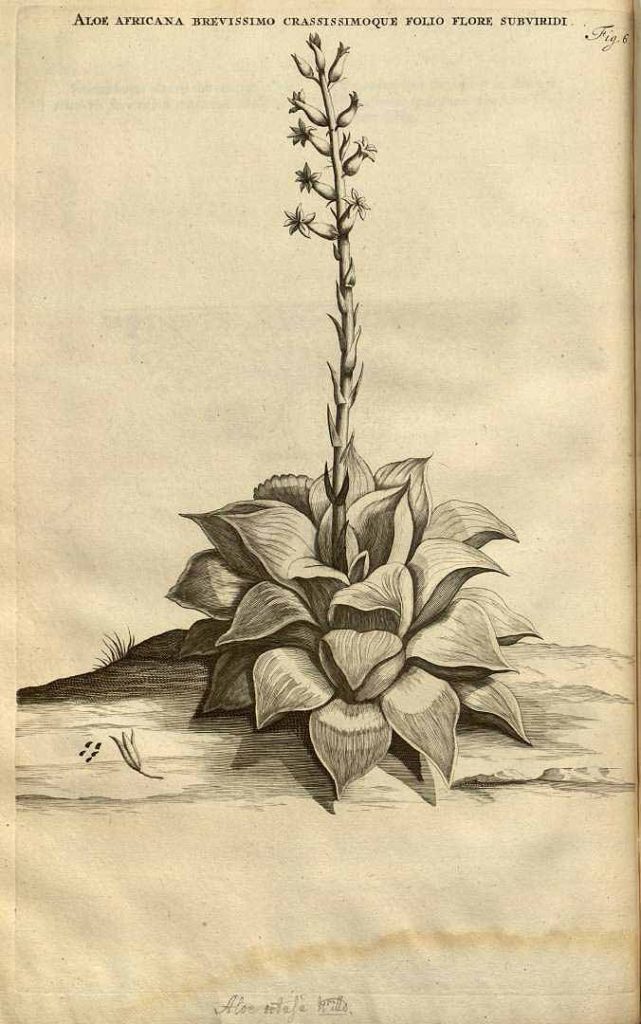
9. S Tradouw
30. 2019.6.3 – Yet another set again with incredible variation and seemingly setting itself apart from the others in the general area. Steven has given me a very nice summary of the geology of the southern Cape – it really needs to be understood to make any sense of these retusoid/mirabiloids to recognise and dismiss the utter nonsense made of the classification of these plants.
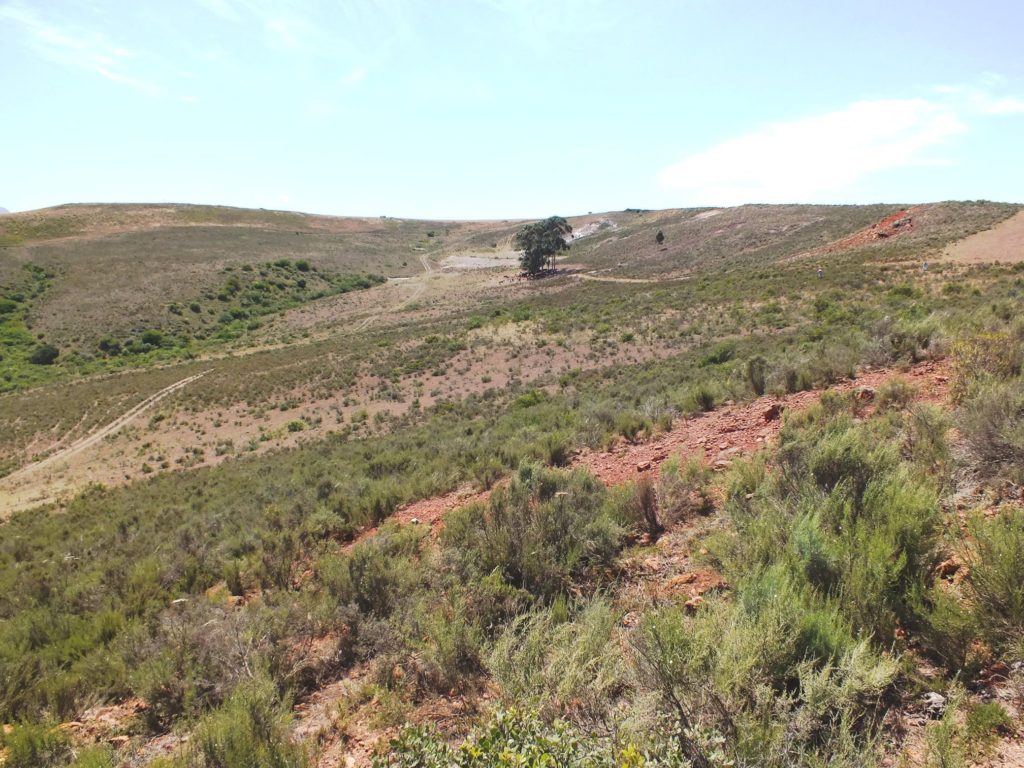
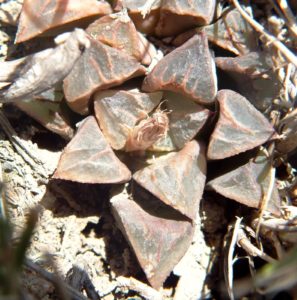
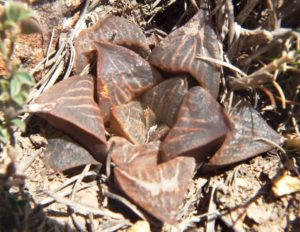

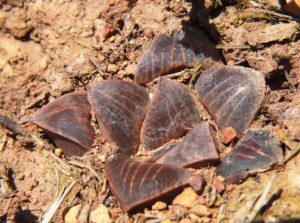
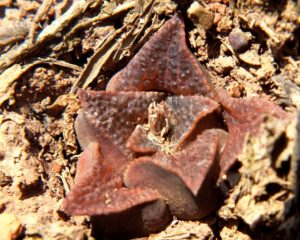
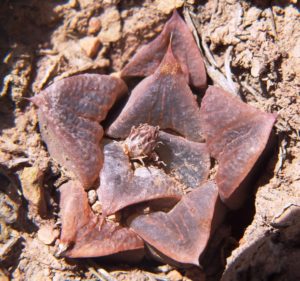
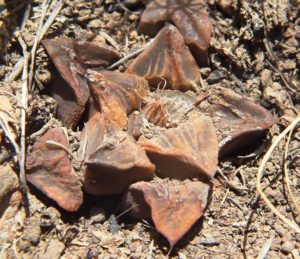
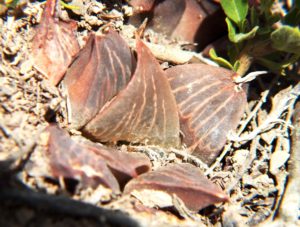
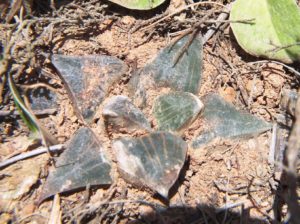
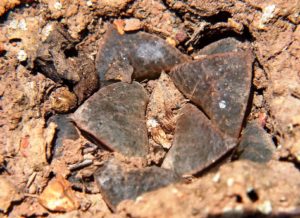
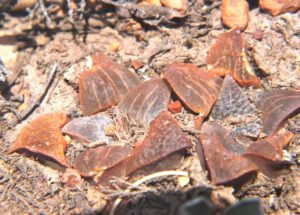

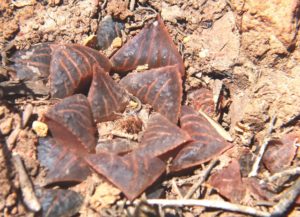

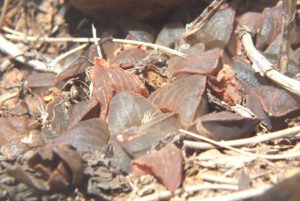
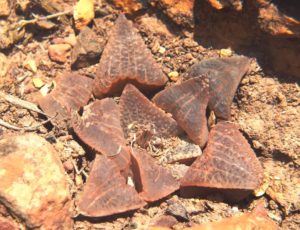
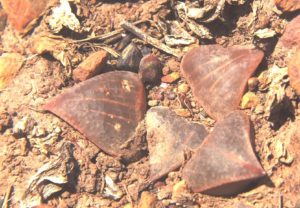

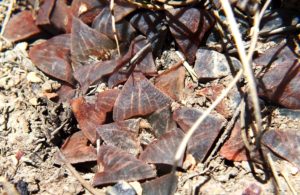
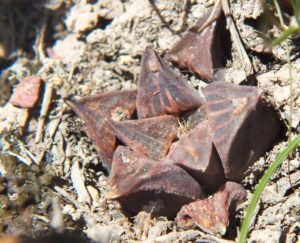
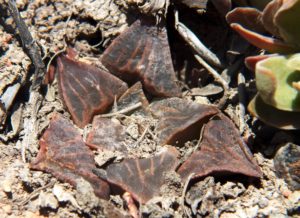
31. 2019.6.4 – These were more scattered plants on the upper level of the terraces south of Tradouw.

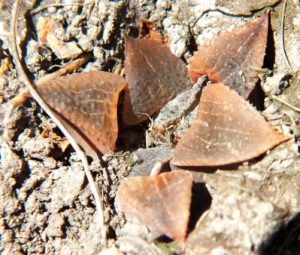
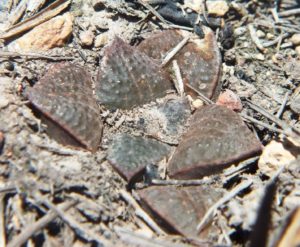
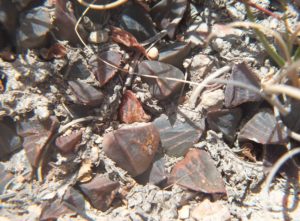
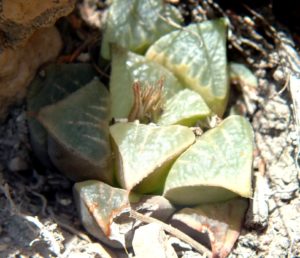

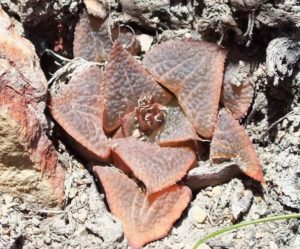
32. 2019.6.6 – This is a very retusoid set of mirabiloids and I hope the message is getting across that even in a small defined area it is difficult to form a clear picture of an element that stands apart from a great many others. A lot more to come. Jaap Viljoen sent me a very nice article on Lithops where the number of species is reduced. Curiously the author refers to his new set of accepted species as his “species concept”. What he means is that it is his concept of the species that constitute the genus Lithops. While obviously based on geographic distribution he says not a word about what his concept of a species actually is.
A new taxonomic approach for the genus Lithops N.E.Br – Harald Jainta

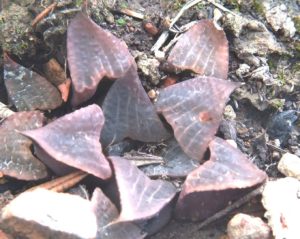
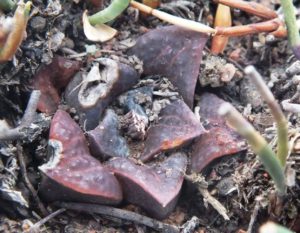
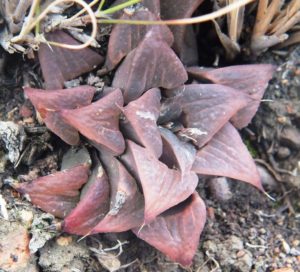
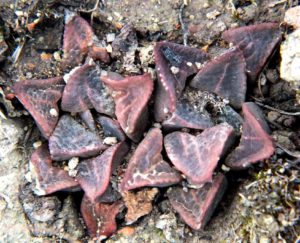
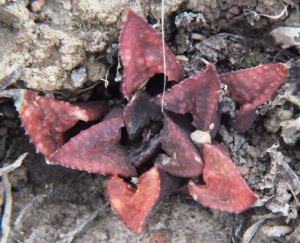
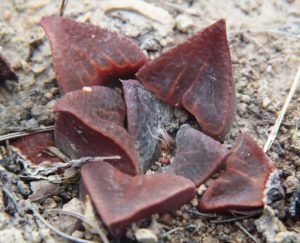


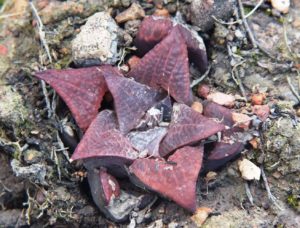
33. 2019.6.6 – Last population from south Tradouw and it is really worth considering each plant individually and asking just what it tells you about any relationship to mutica, mirabilis, retusa or any other “ii” or “iae”s – even to the rest of the S Tradouw set. The habitat like in one or two other instances, is not the decayed under layer to a cemented top. The southern Cape had an old sea or lake floor that deposited a geologically young sea-bed terrace. The upper layer was cemented by mineral accumulation ferricrete, calcrete, silcrete. Massive erosion has subsequently removed most of the terrace leaving many other exposed terraces of different ages as well as more recent ones. The old under layer never formed a really hard vitrified shale and has been leached of many of the minor elements to leave a very erodible clay = kaolinite. It is surprising how variable the old terrace actually was as there is a manganese predominance in the west while another clay = bentonite occurs eastwards, often as ocher. Clay is a critical component of soil and its complexity is mentally more challenging than I can manage.
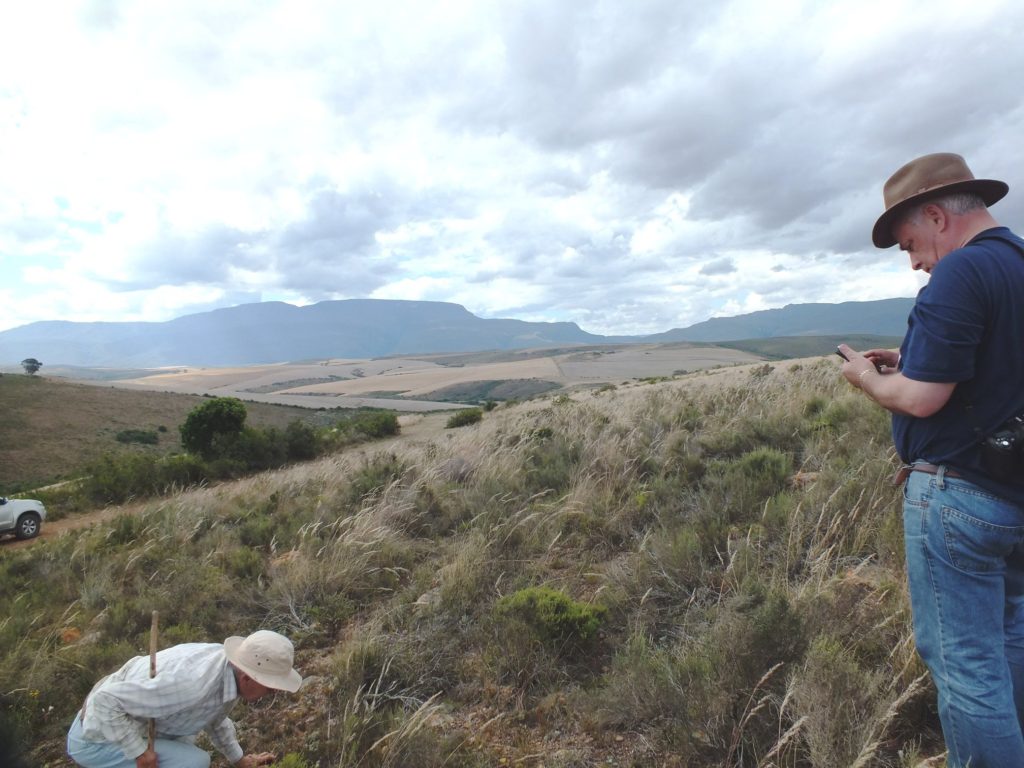
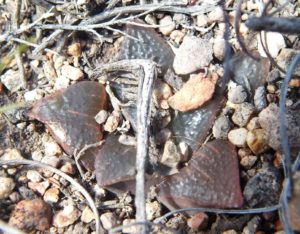
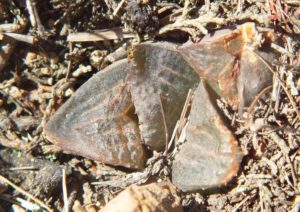
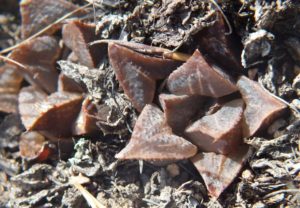

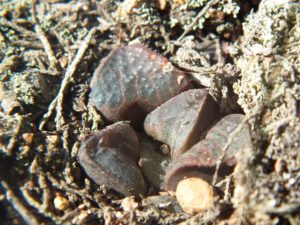

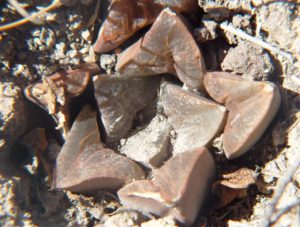
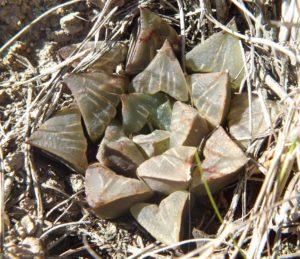
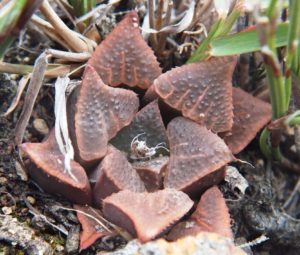
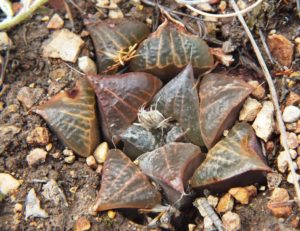
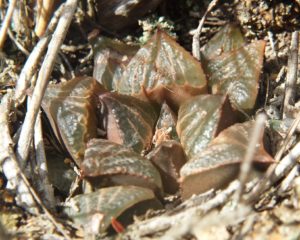
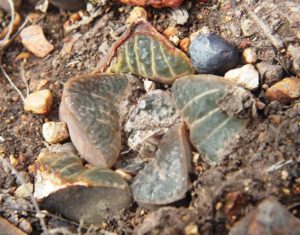
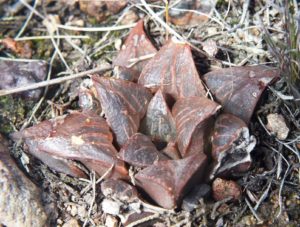
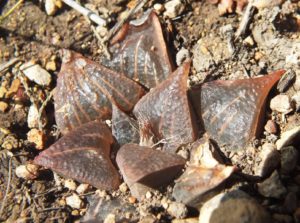
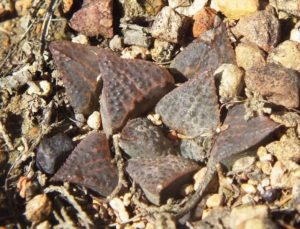
Steven Molteno summarised a bit about the Southern Cape Geology … Ancient river systems are the main influence on the geology of the Buffeljags-Swellendam area. So the area’s geology is composed of multiple layers of alluvial gravels. All of which sit on top of a deep basin of older Bokkeveld shales and Wagendrift sandstone/shales.
So for the alluvial layers:
• The youngest gravel layers are obviously the lowest ones, and closest to the modern river. They’re almost always loose and uncemented.
• The older gravel layers are the higher terraces; The oldest become silcretes (soils fossilised in dry climate) or ferricretes (soils fossilised in wet climate). Others haven’t been cemented yet, so they’re just high-level colluvial terraces (uncemented cobbles like the marginata terraces at Drew).
• The oldest of all are not even gravels anymore. They’re the Enon conglomerate from the Cretaceous, and this survives in the area immediately around Swellendam and also in a patch just north of Buffeljags.
The character of these terraces is determined by the origin of the alluvial cobbles (quartzite clasts, sandstone, or maybe even shales), as well as the nature of the matrix cement (usually a reddish silt, but can vary). This means that each layer can have a unique soil and a unique flora. It’s also possible to correlate the remaining patches of a certain altitude, in order to reconstruct the original alluvial layer before most of it was washed away and replaced by younger, lower layers. The Bontebok Park is particularly dominated by these layers.
2019.6.8 – What am I doing? I started off just to share a bunch of pictures I was enjoying. I am reminded of “The Rime of the Ancient Mariner” by Samuel Taylor Coleridge. Why he shot the Albatross is an unanswered question as he stays bound to tell the story of how it was hung around his neck and later dropped off, for seemingly the rest of his life. Haworthia seems to be my albatross and it really dropped off when I wrote Update Vol. 8. Anyone seeing these pictures should read the document that deals with flower character in Haworthia. It will explain why I will accept H. groenewaldii as a species other than as H. mutica, only if it grows wings and flies somewhere else. In Vol. 8 I explain why I consider mutica to be even conspecific with H. retusa. There are far more intractable problems in Haworthia than this. As for the albatross. The memory lives on! Curiously I can’t remember a single validation from anyone regarding those 12 or so Updates. So while laboriously telling my story it appears that no one has been listening! As Lawrence said “If they ain’t learnt, you ain’t taught”!
References:
Haworthia mutica (groenewaldii) and its twisted leaves.
What is typical Haworthia mutica?
Haworthia flowers – some comments as a character source, part 1
Haworthia flowers – some comments as a character source, part 2
Haworthia flowers – some comments as a character source, part 3
Haworthia groenewaldii I. Breuer spec. nov.
“If the student hasn’t learned, the teacher hasn’t taught.” ~ Henrietta C Mears
Also attributed to Zig Engelmann. link ♦
10. Floribunda SW Tradouw
34. 2019.6.8 – Traveling west to SW Tradouw there is a habitat just like those that house mirabiloids and retusoids. Yet here there is H. floribunda and Aloe brevifolia in separate discrete small areas in an area stretching about 300m. There is Aloe arborescens that likes the creted upper zone of the old terrace and Aloe ferox that hangs around on usually the edges of the exposed and bare clay. Why no mirabil/retus-oids? ♦

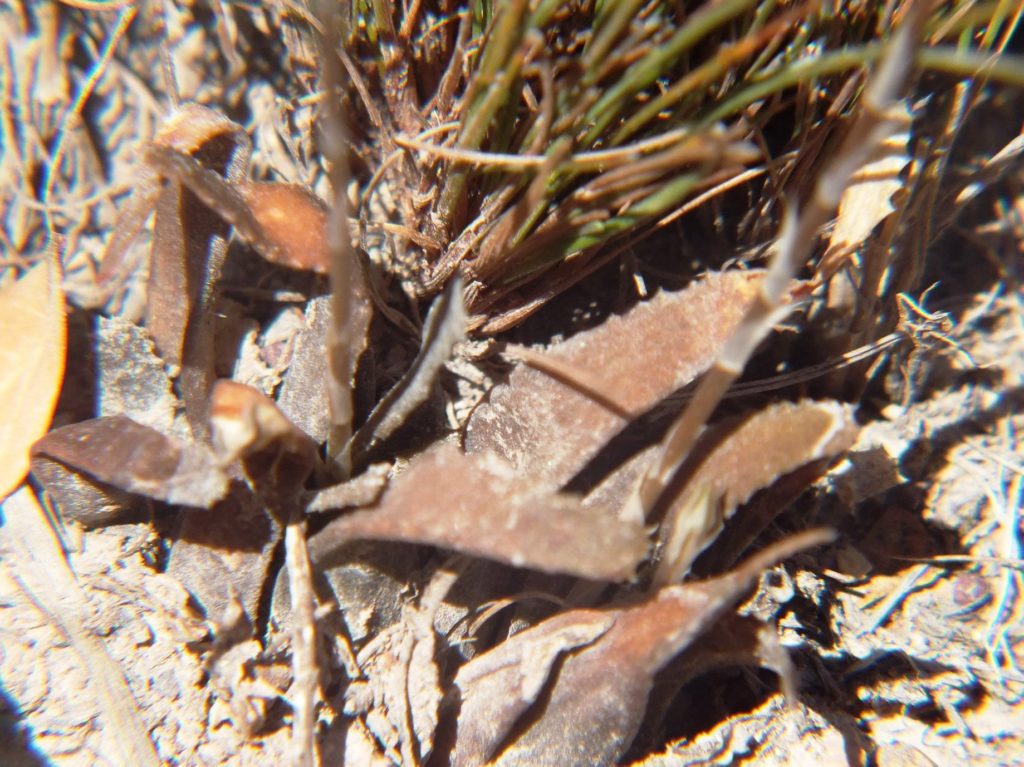

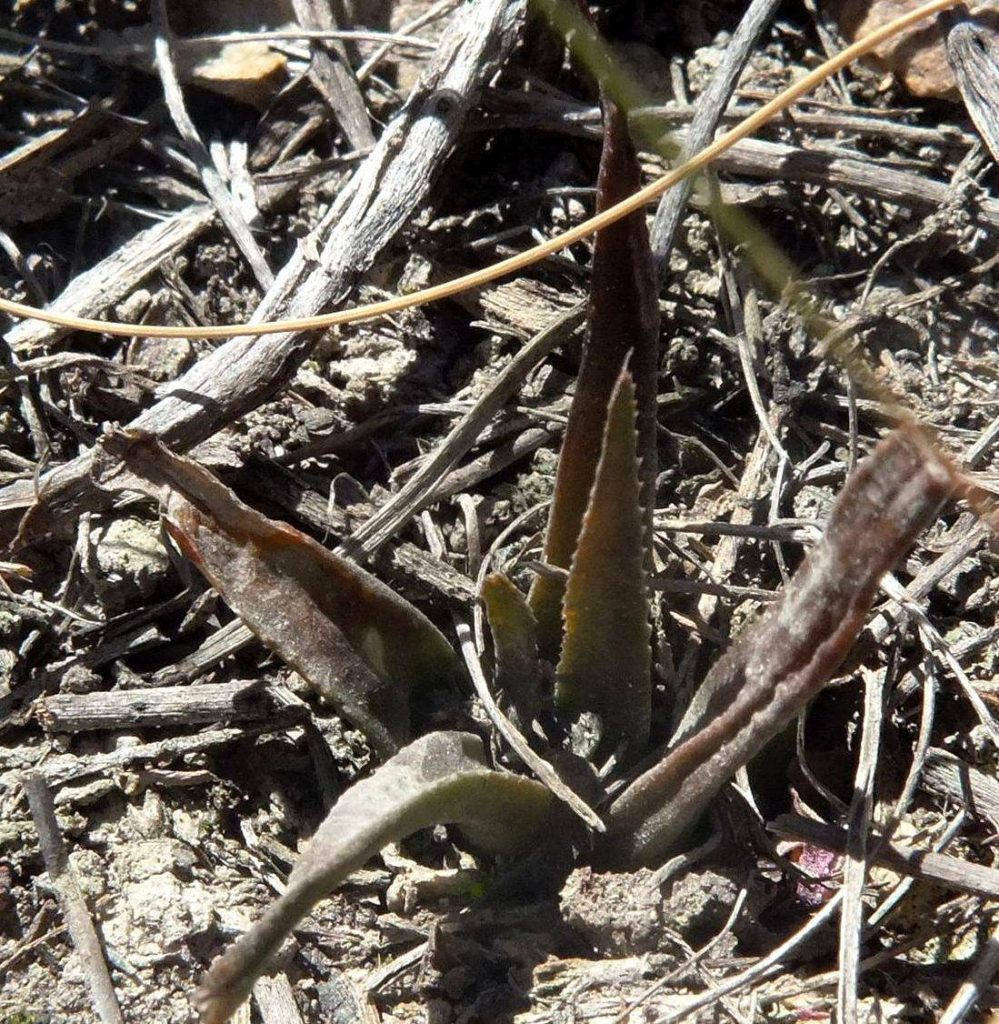
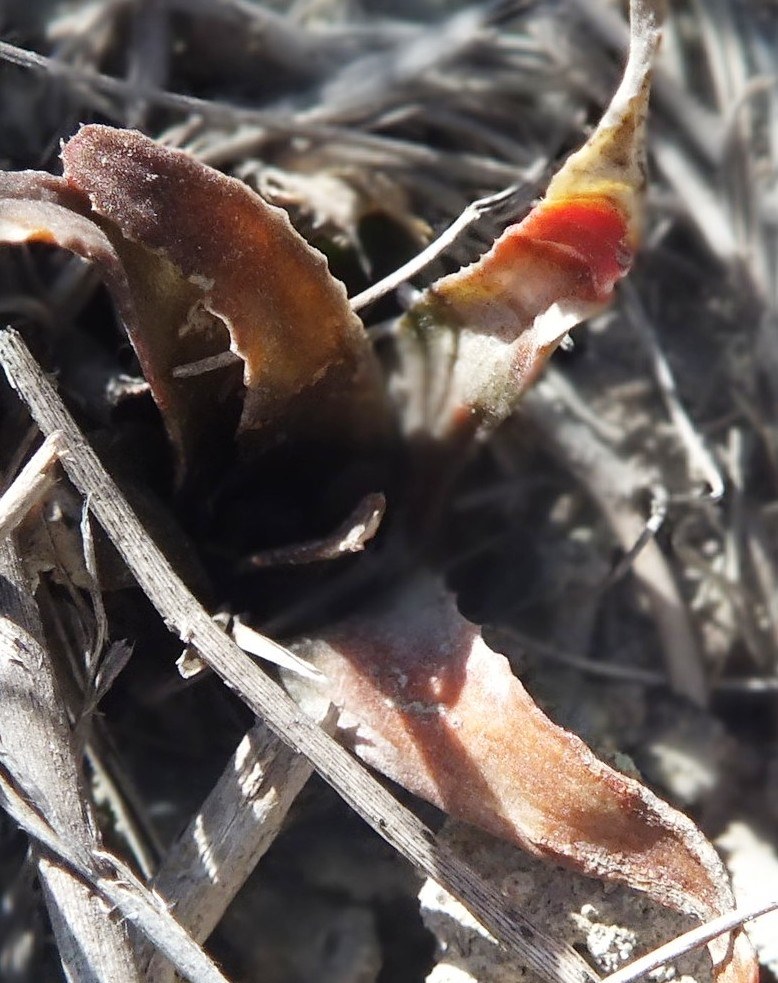

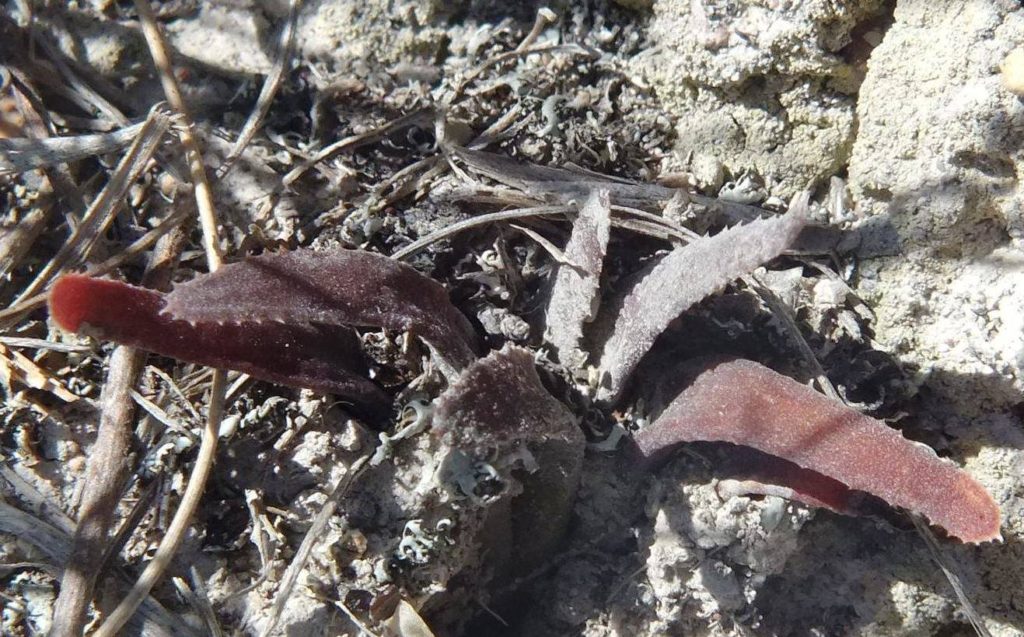
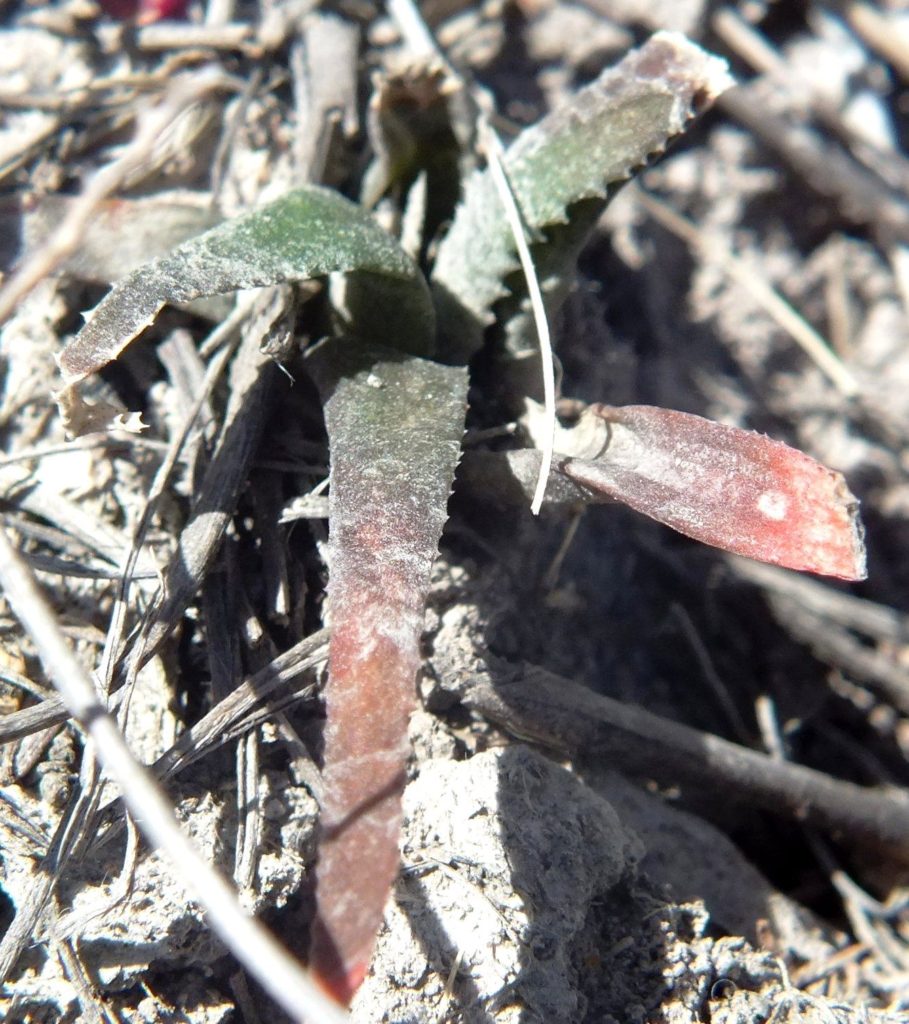
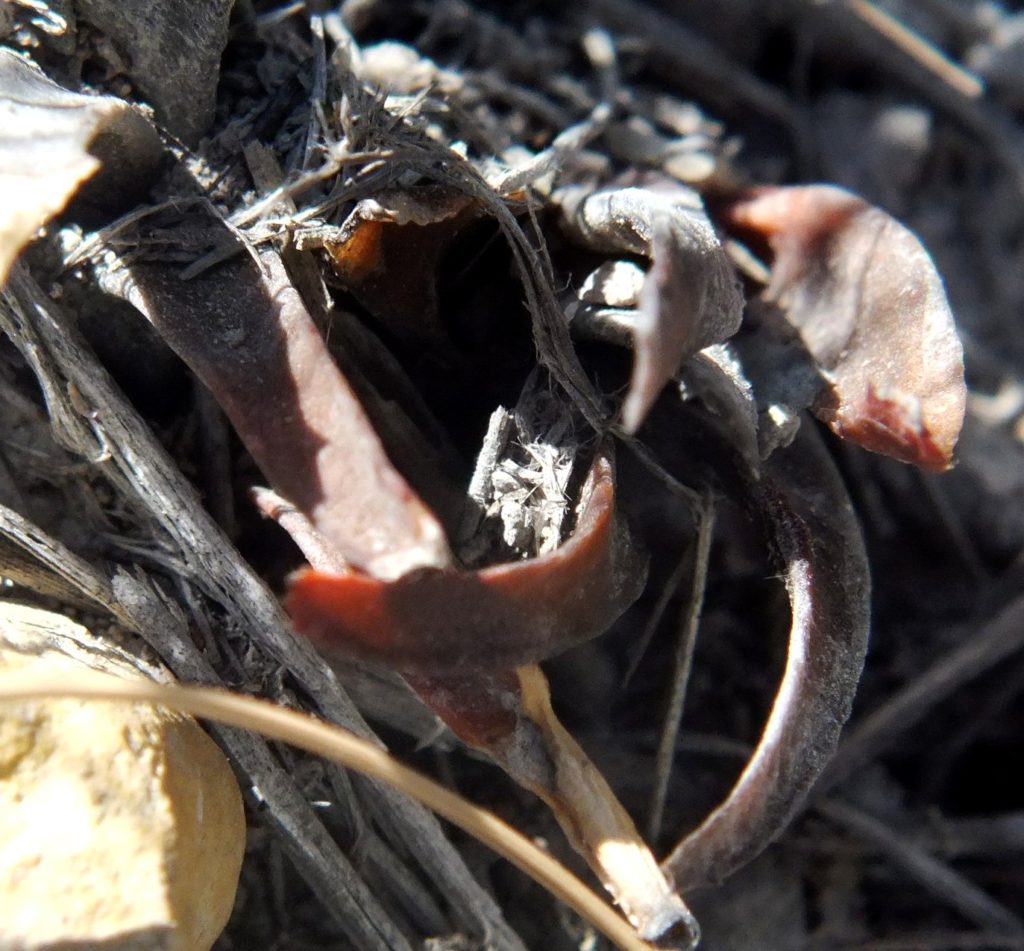
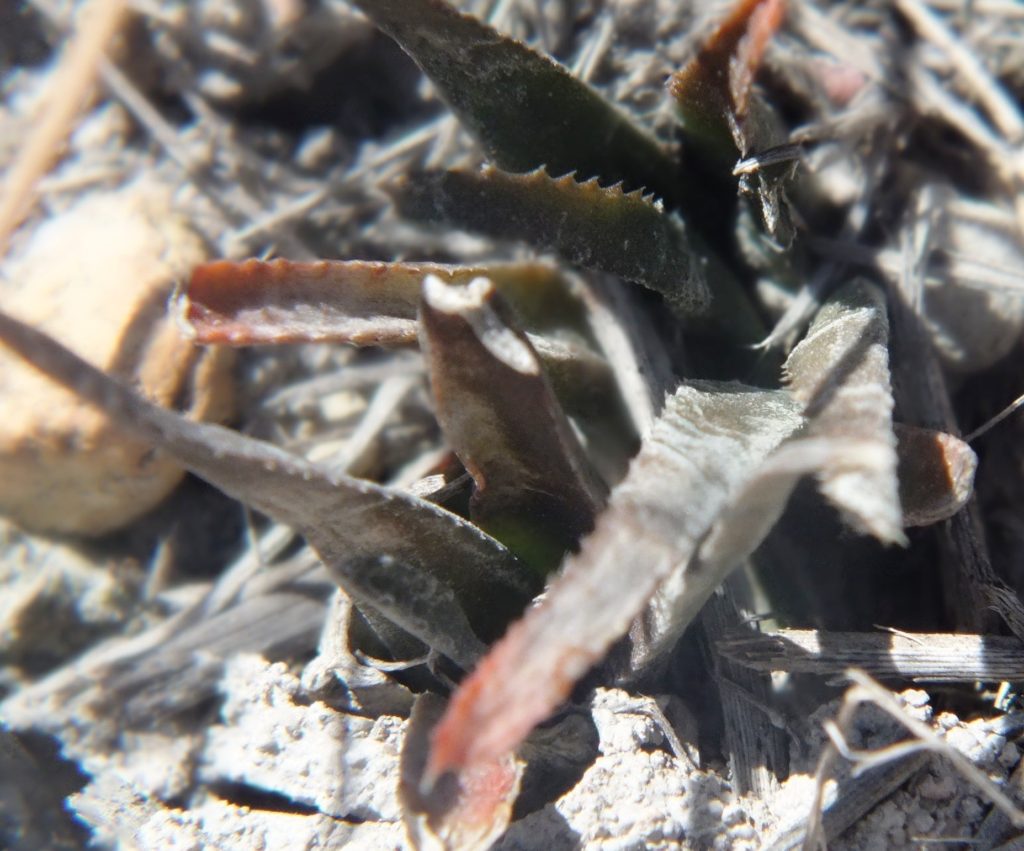
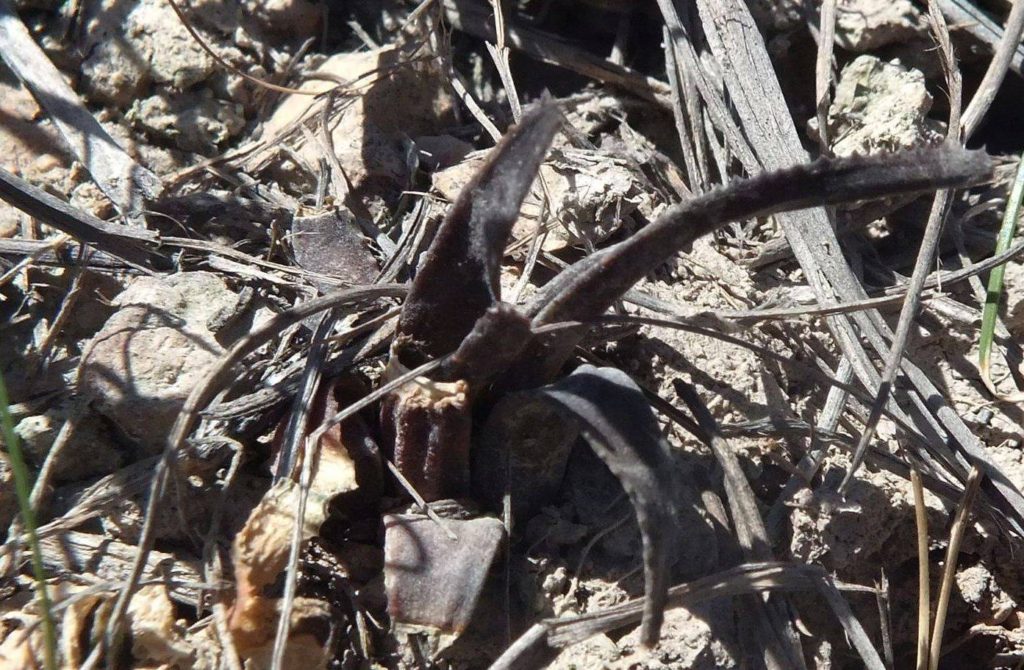
11. SW Tradouw
35. 2019.6.9 – A great big album of variants SW Tradouw. I have multiple flower pictures of most of these populations and I should really put them all together as for the Update Vol 8. But journal editors and writers do not want to be persuaded. As Benjamin Franklin said “A man persuaded against his will, is of the same opinion still.” I reflect on how in 1970 going through all those very muddled pictures of G.G. Smith, that I was sure that his Buffeljags pictures held a major key to understanding the Haworthia of the southern Cape.

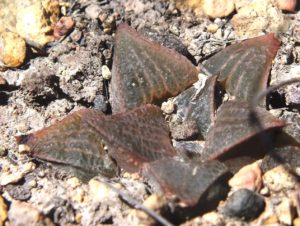
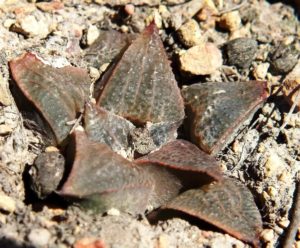
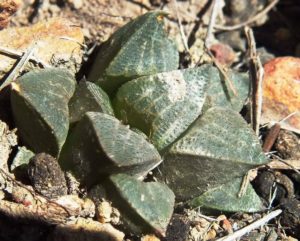
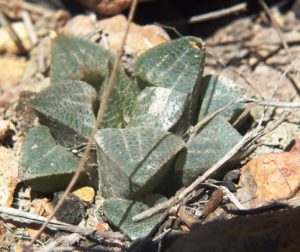
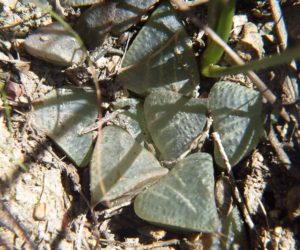
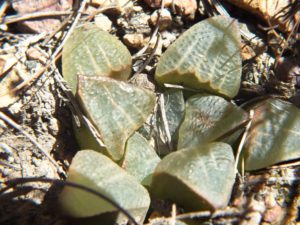
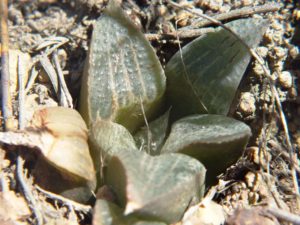
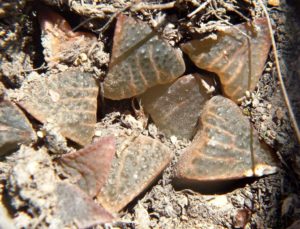


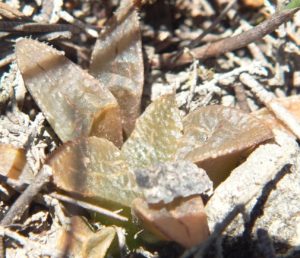

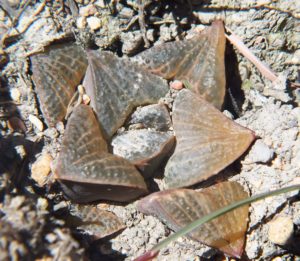
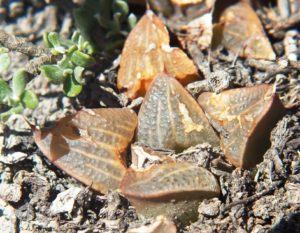

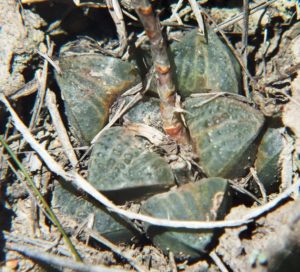
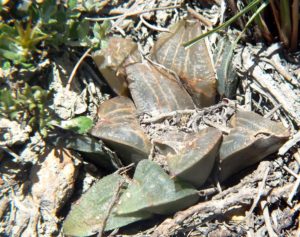
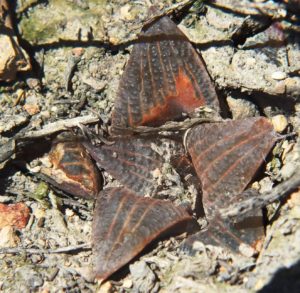
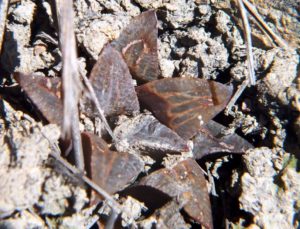
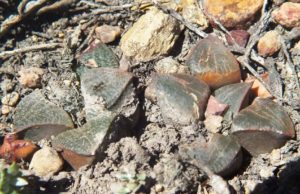
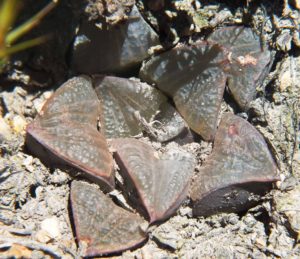
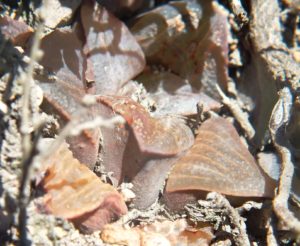
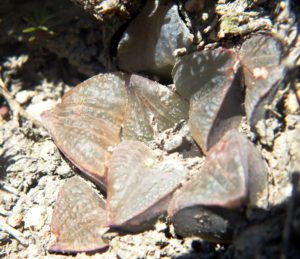
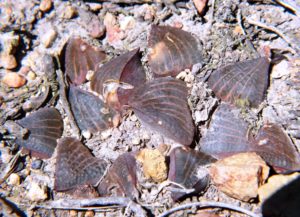
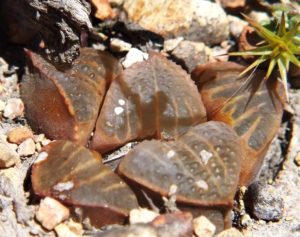
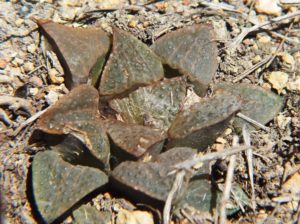

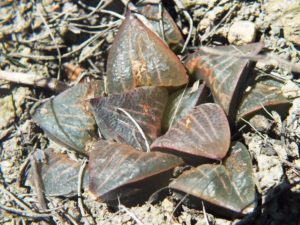

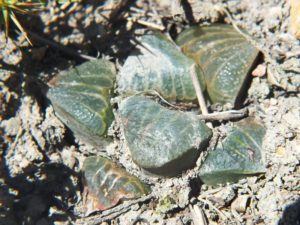
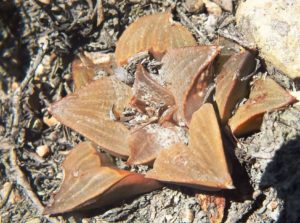
2019.6.9 – Many years ago there was a debate about classification being science or art. It sure is confusing because you just have to look at the qualifications of people who have dabbled in Haworthia classification to see a problem. It has included bus-drivers, engineers, traffic policemen, accountants, artists, musicians, librarians, human resource managers, doctors, bookkeepers and more. Where botanists have been involved the end-product has not been much better. Now to our detriment science as DNA sequencing, has got a stranglehold on the subject that is not going to be shaken off.
Apurva Sukant: Dear Bruce, I imagined the DNA sequencing would be the holy grail in identification and classification. Why do you suggest that it will be to our detriment? Thanks for the post and clarification.
Bruce Bayer: It is to our detriment because it is so difficult for anyone to question the result. Also it is quite clear that for genera like Haworthia the degree of difference is just too small. Finally there seems to be a problem in that people doing the DNA studies are not field familiar with the plants and are not considering the results in respect of the observable.
A problem for me with DNA sequencing is that the result is presented as a phyllogram (cladogram, dendrogram, branching tree) just as the old diagrams of evolutionary steps. The only difference is that the stem is on the left and the end-points of the branches on the right. I see this as a representation of a process in time where time is represented by the left-to-right, and the branch end-points then represent the “species” in space? If this is so, it simply cannot work because space has a minimum of two dimensions. Only once have I had a botanist say it can’t work because species are reticulate – they do not proceed on a linear evolutionary path? Anyway, who really knows if evolution is fact, science fiction, or change with time of a spontaneous creation?
36. 2019.6.10 – S Zuurbraak, SW of Tradouw. The clay here is different and the plants have lost that dark colouration.

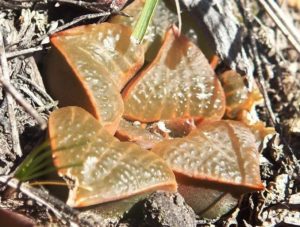
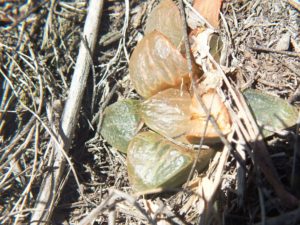
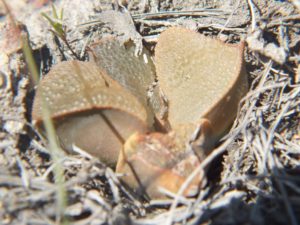

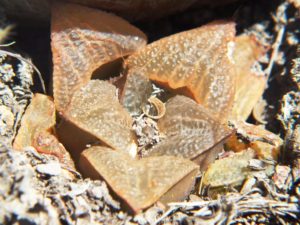
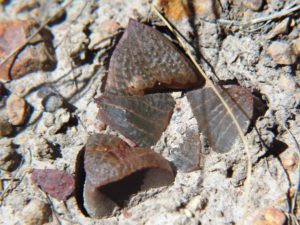
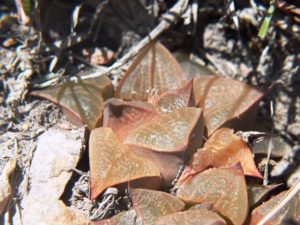
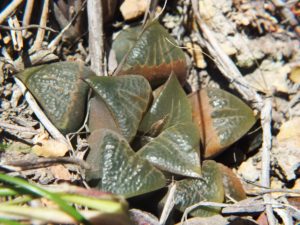
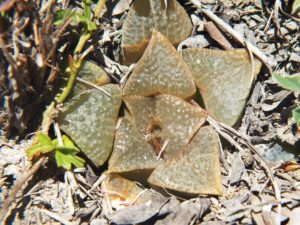

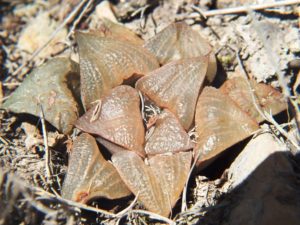
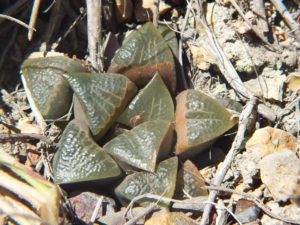
37. 2019.6.11 – Not very far from the previous population, and a significant discovery is that I do not know as much about the geology or the origins of these Haworthia as I might have thought. Essentially this place is about the highest and oldest remnant of the African terrace. The high backwater of the Buffeljags River. That is Steven’s job to explain someday? Beautiful plants!

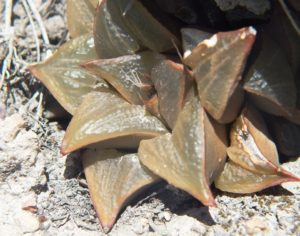
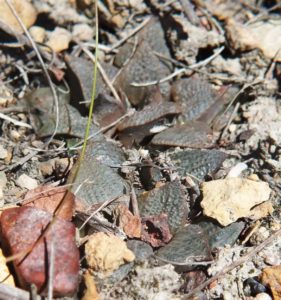
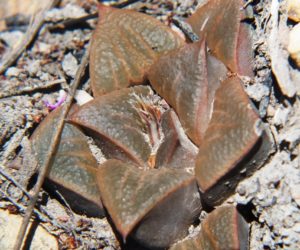



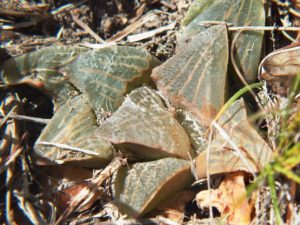
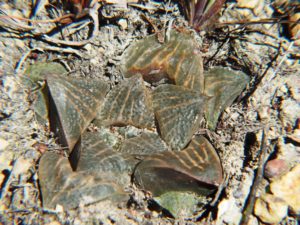
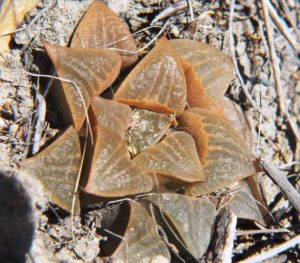

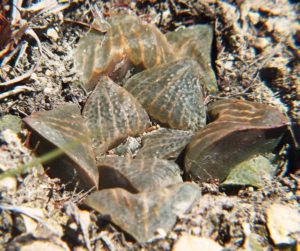
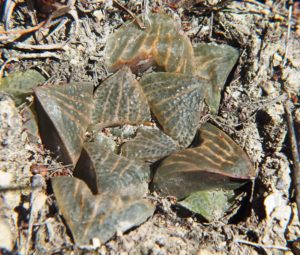
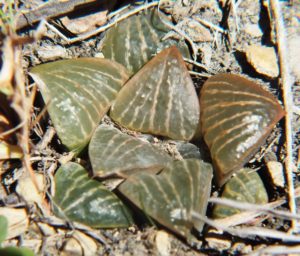
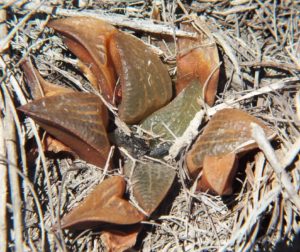

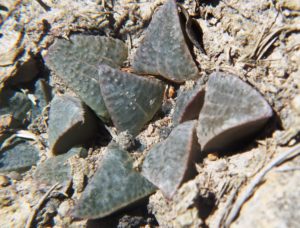
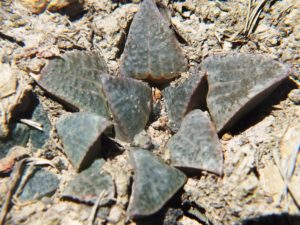

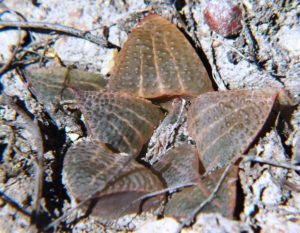

I have to continually remind myself what I am doing. I am explaining that you cannot take bits here and bits there and sprinkle Latin binomials around like confetti to fool everyone into thinking you know something. All these populations and the plants, need to fit a single narrative. Using peoples names to generate a support base for yet another fable is not appropriate. I would remind readers of the story of H. serrata Bayer. There is no way that I feel mistaken in describing it as new except when I found it again where H. rossouwii of von Pellnitz must have come from. Even Ingo Breuer took me remiss for making the connection. This amply demonstrates the illusion of a type and a description as forming some kind of unshakeable truth.
38. 2019.6.12 – More from SW Tradouw – is there any genus that has this extraordinary variation?
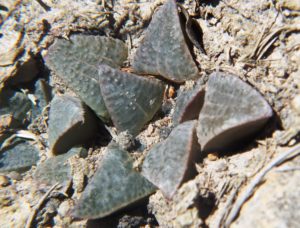
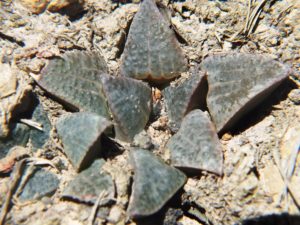
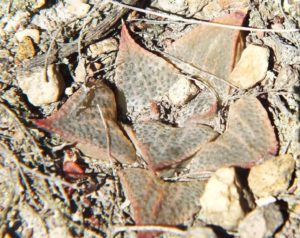
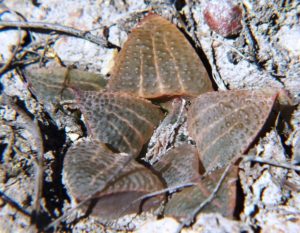
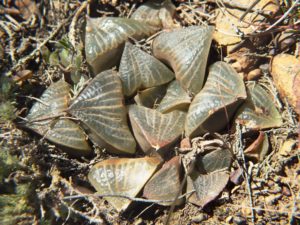
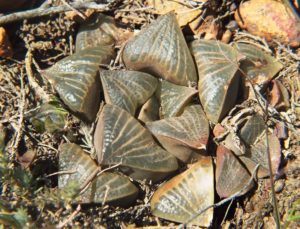
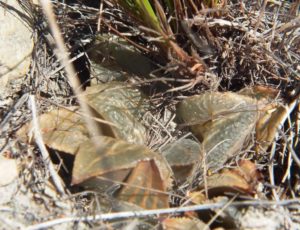
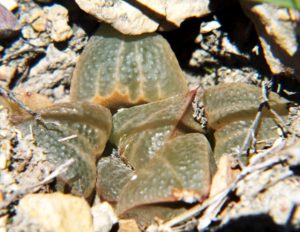
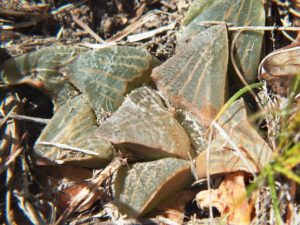
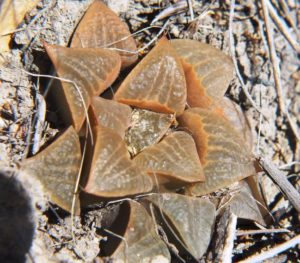
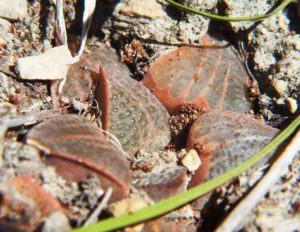
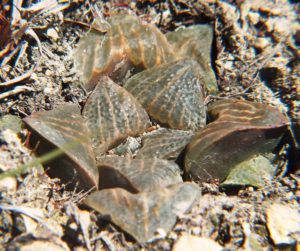
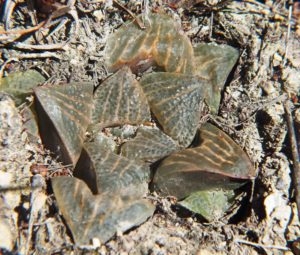
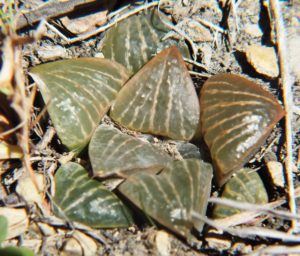
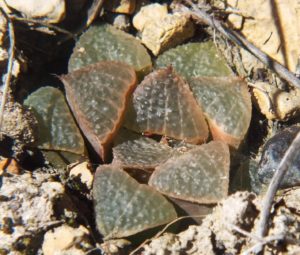
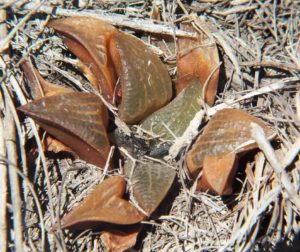
39. 2019.6.13 – Moving 3km southwards and dropping down 150m to the eroded flat wheat areas one comes to expect something different. This is one of many of the small mirabiloids, none the same. When I wrote the revision in 1996 very little was known about them and they existed in a few populations known as H. heidelbergensis. Very common indeed from east of Riversdale to Riviersonderend and morphing out of that in all directions to still other versions. ♦
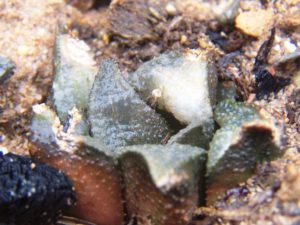
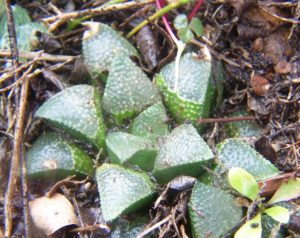
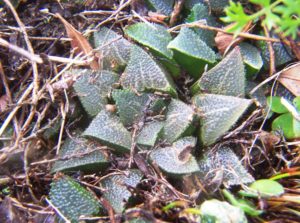

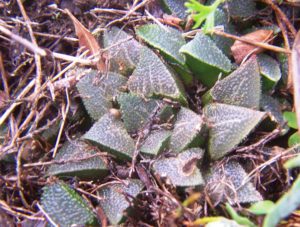
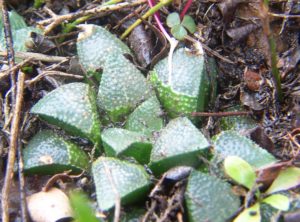
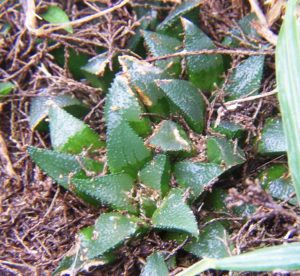

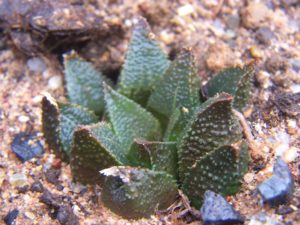

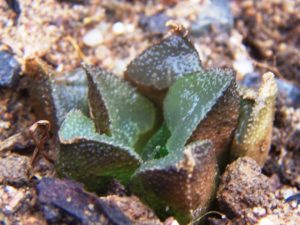
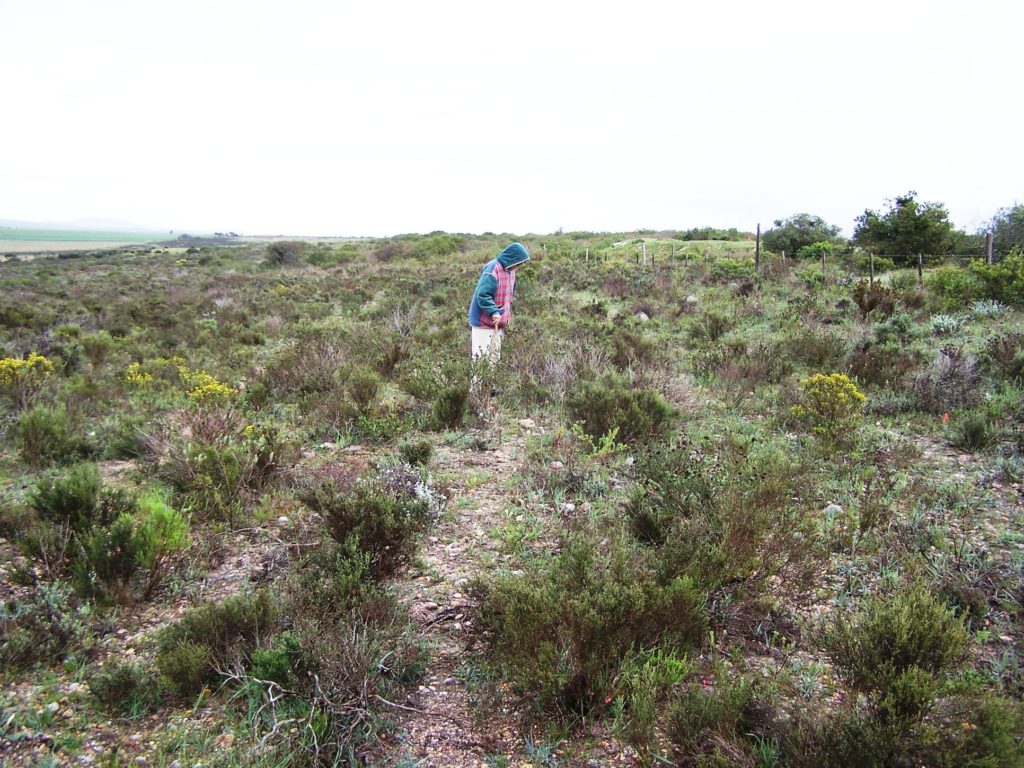
12. How do we know anything?
40. 2019.6.13 – How does one know anything? Why I ask is because I have so often heard strong opinions based on a great degree of ignorance. The revision process in plant classification is built on the accumulation of information. At one stage all known Haworthia were 5 small Aloe species. It has been pretty much chaos ever since. There are many total imponderables within Haworthia even in its purest form i.e. with Haworthiopsis and Tulista excluded. While it is difficult enough to arrive at a reasonable guess as to what a population may be, it is very much more difficult to explain an own informed guess to someone convinced of something else on the basis of near nothing. Can one explain to a frog in a pond that has not even seen the other side of it, what the ocean is like? At the same time one should not expect the ignorant to take a blind leap of faith. H. groenewaldii as H. mutica, needs to be seen in this context and there is a lot of peripheral stuff that needs to be explained. I did not think H. floribunda was going to be so central to my story, but it is. It occurs across the range of the retusoids from the Gouritz River in the east to west of the Breede River in the south. But it gets lost among the mirabiloids along a east/west line between Riversdale and Swellendam. What it does at Swellendam is extraordinary. H. floribunda is a rather inconspicuous small plant characterised by a flattened leaf and rounded leaf-tip. It is this character that seems to be infused into the mirabiloid/retusoids suggesting that H. floribunda itself may be essential to that group. BUT it has its own complications in that it can be seen to be linked to H. variegata, H. parksiana and H. chlorocantha. How does one know that? It is an opinion probably arising solely from seeing so many things in the field that suggest this. Judging from all my pictures, its chief character seems to be that it is non-photogenic. It does incline to be well drawn into the soil with at least half the leaves below soil surface. My pictures are appalling but here are some to give an idea of what “floribunda” may look like, before I show what it is like at Swellendam.
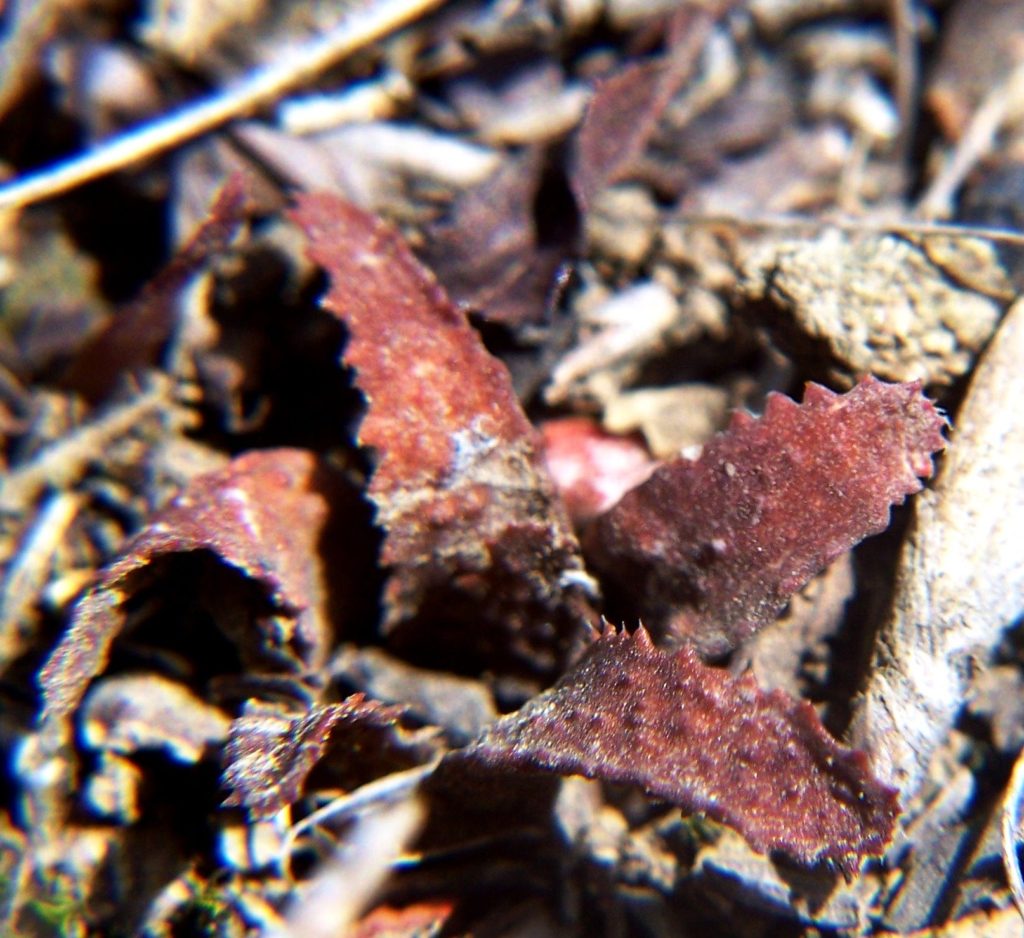
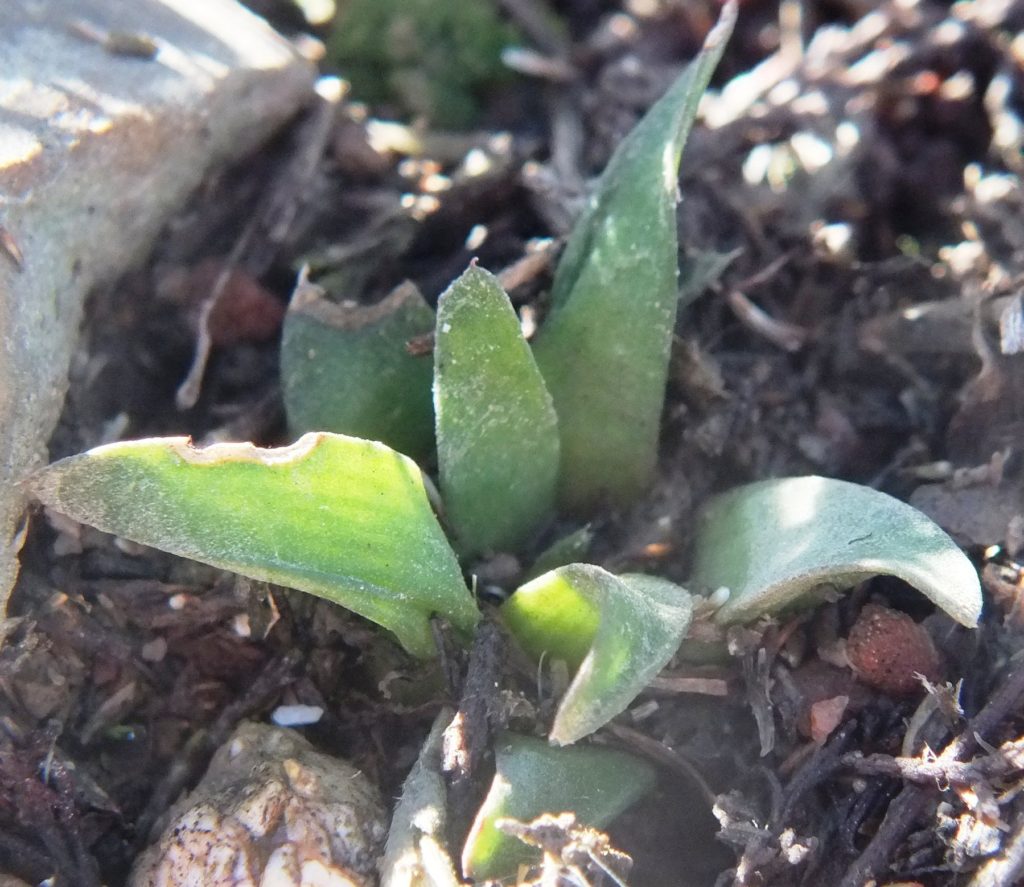
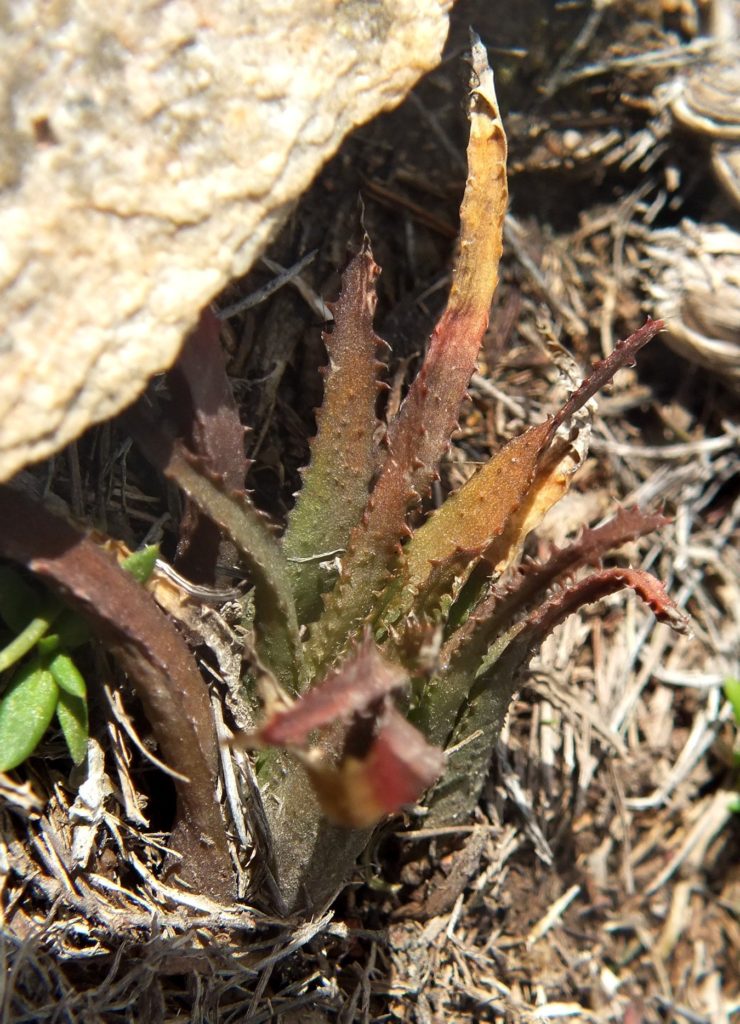
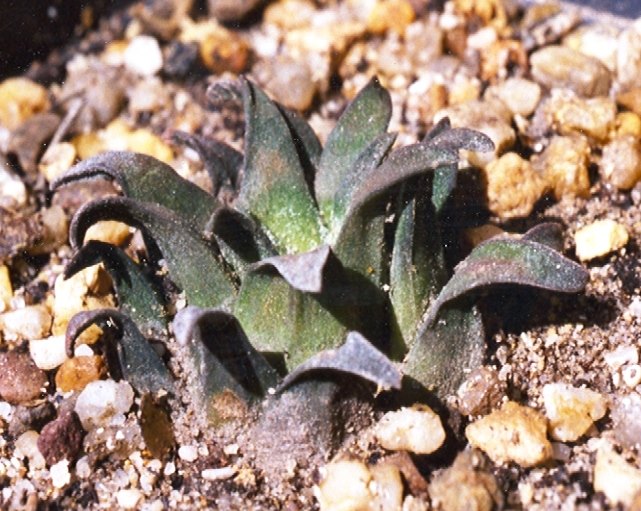
Some of the weak points emerging in my story…
1. Starting point. Perhaps I should have said a lot more. A great deal more. I had a plant from N Bredasdorp that was H. mutica by my identification, and another from N Mossel Bay as H. pygmaea. They were absolutely identical except for the colour of the floral bracts. And I had B/W pictures from G.G. Smith’s draft “monograph” of plants from Buffeljags River Swellendam, and from Kransriviermond Heidelberg that Smith had labelled H. mutica. These also looked nearly identical.
2. Missing pictures. I have no decent pictorial record of my field activity until I got a digital camera about 12 years ago. So there are gaps in the photographic record.
3. Too much to digest. I have about 300 populations relevant to the story with an average of about 10 pictures/population plus the whole historical record. I can’t throw one out without feeling my story is diminished. How does one transmit the combined picture of all these images to anyone else when some of it is forgotten or incorrectly memorised?
4. Inadequate flowering time data.
5. Inadequate understanding of the geological facts and the time scales involved.
6. I suspect there may be more.
♦
13. Swellendam
41. 2019.6.15 – There are many imponderables In Haworthia that cloud the issue. For one, there is the big separation of a group of species in area 2 of my map from the rest of the S Cape. This can be linked to the two populations about 12km west Swellendam. One is on an igneous intrusion and the only rational place for it in my personal view, is that it represents H. mirabilis. The wide range of variants so troublesome to description can be compared with mirablis ‘sublineata’ at Bredasdorp, mirabilis E. of Greyton, but also to emelyae “multifolia” and even to H. rossouwii. Those are the first two pictures. The others must represent floribunda on the basis of the other variants of that species around Swellendam that also suggest it is not mirabilis. Together they stress the reality that a far wider concept of the species is necessary. ♦
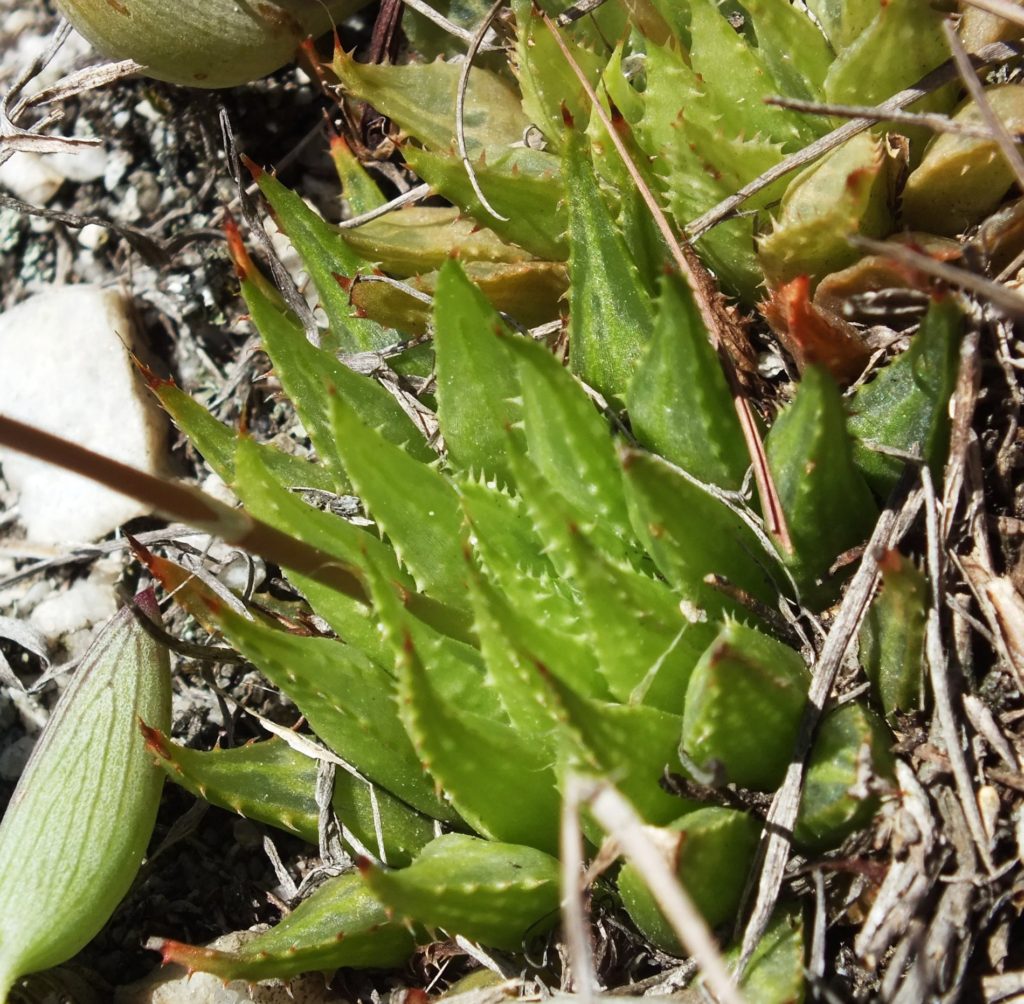
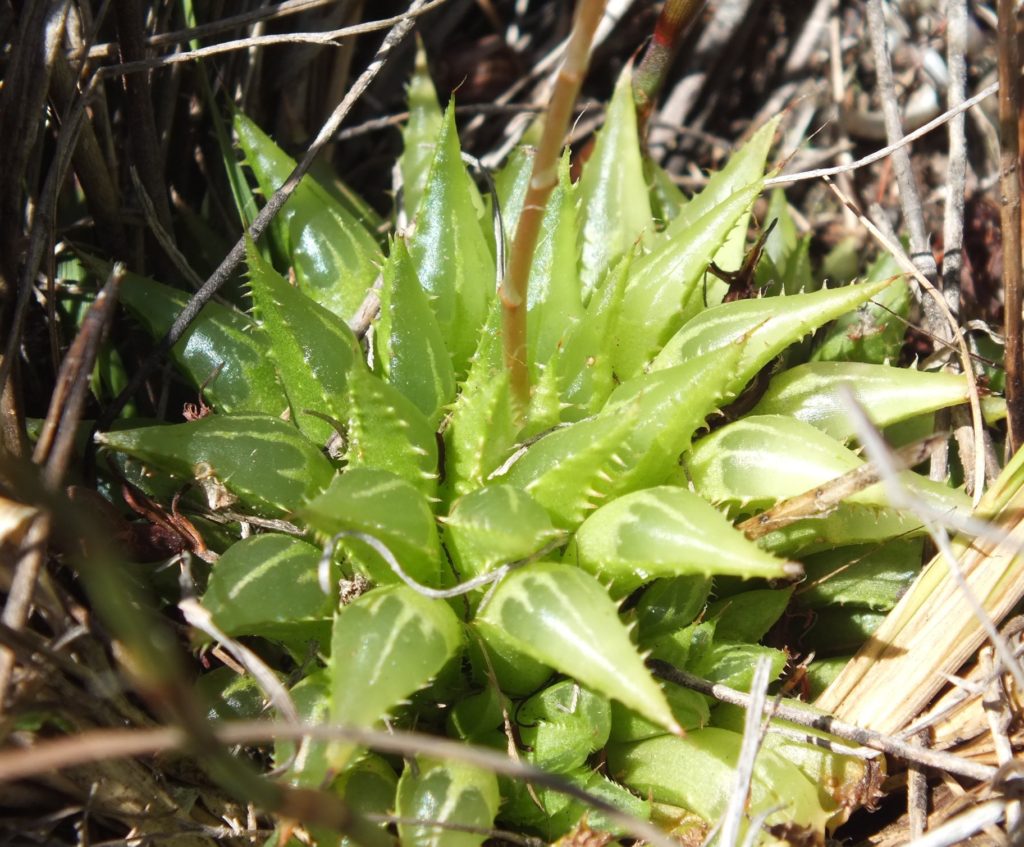
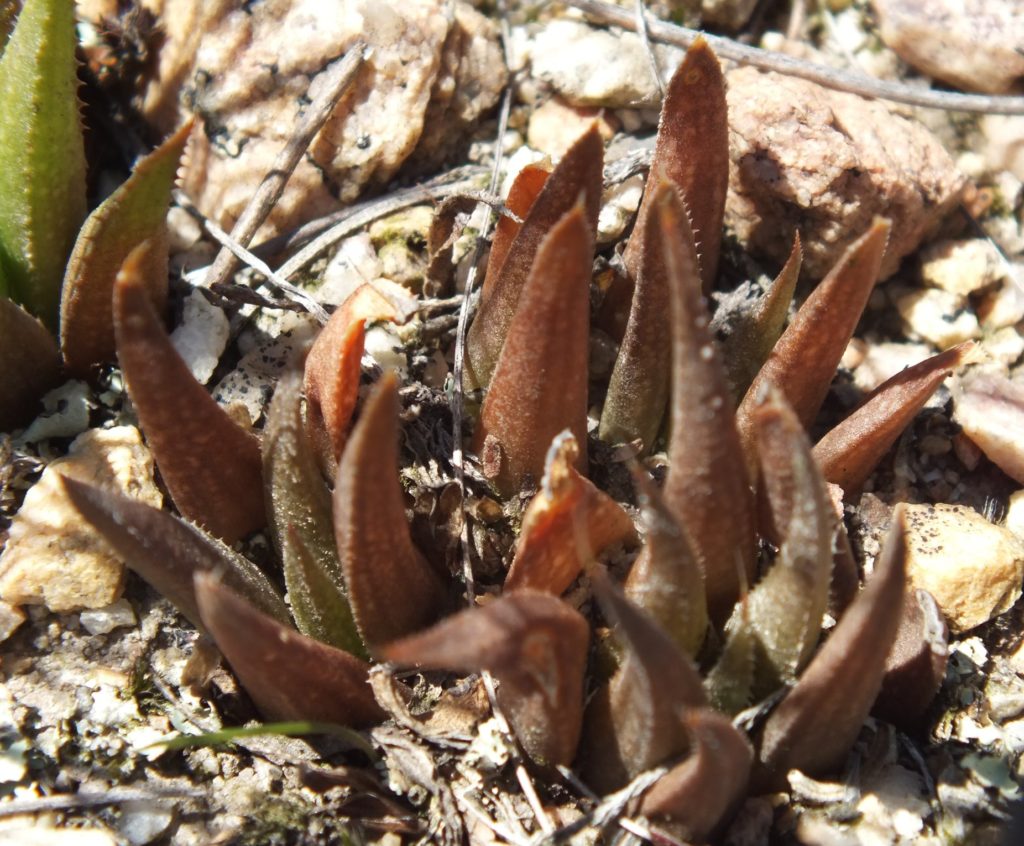
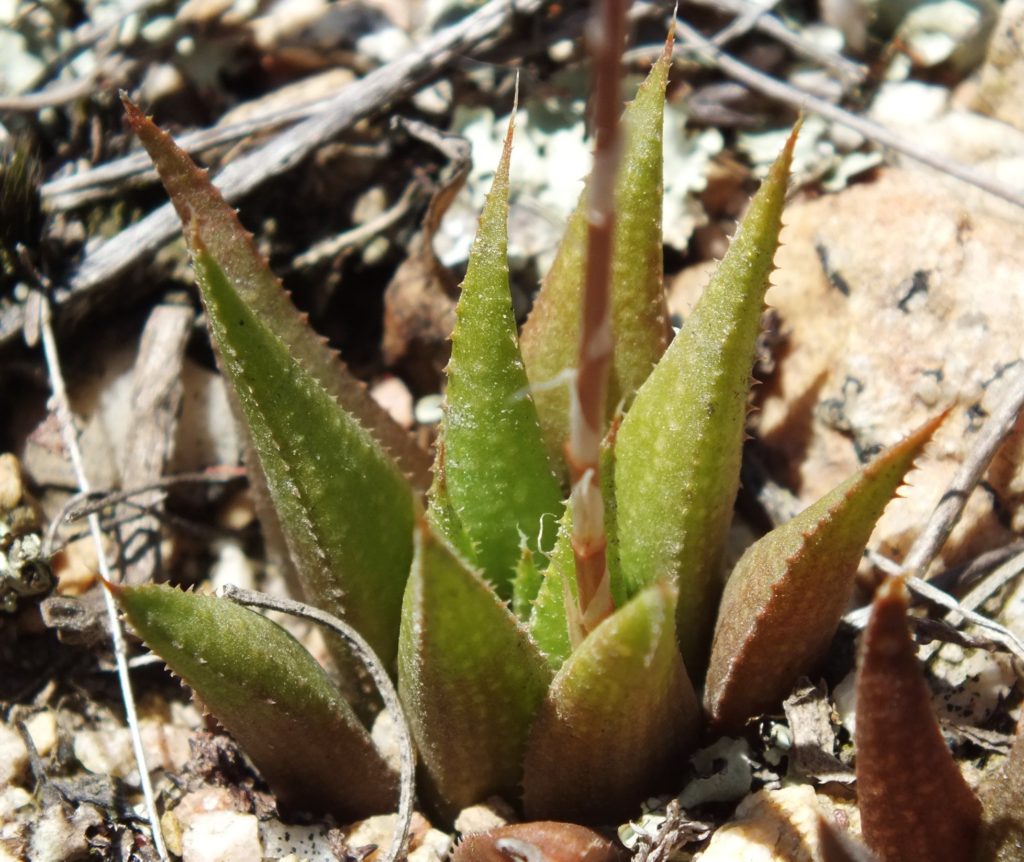

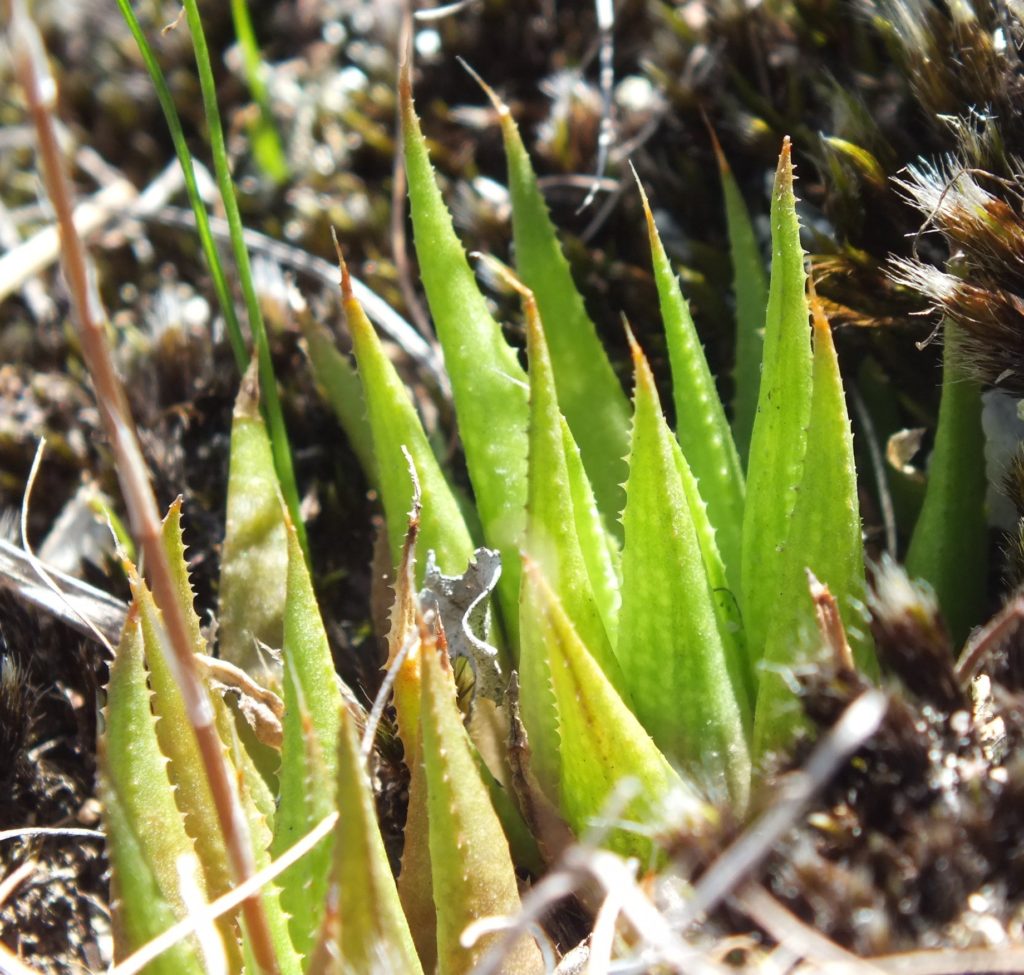
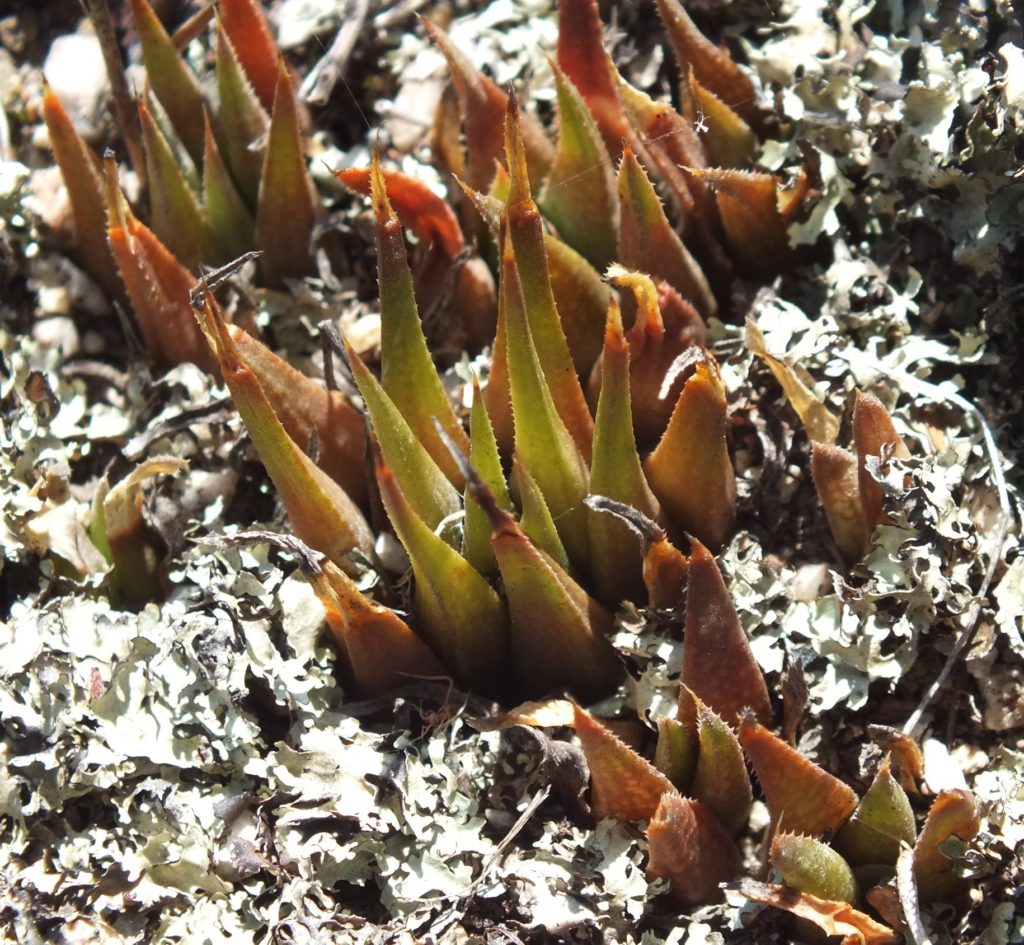
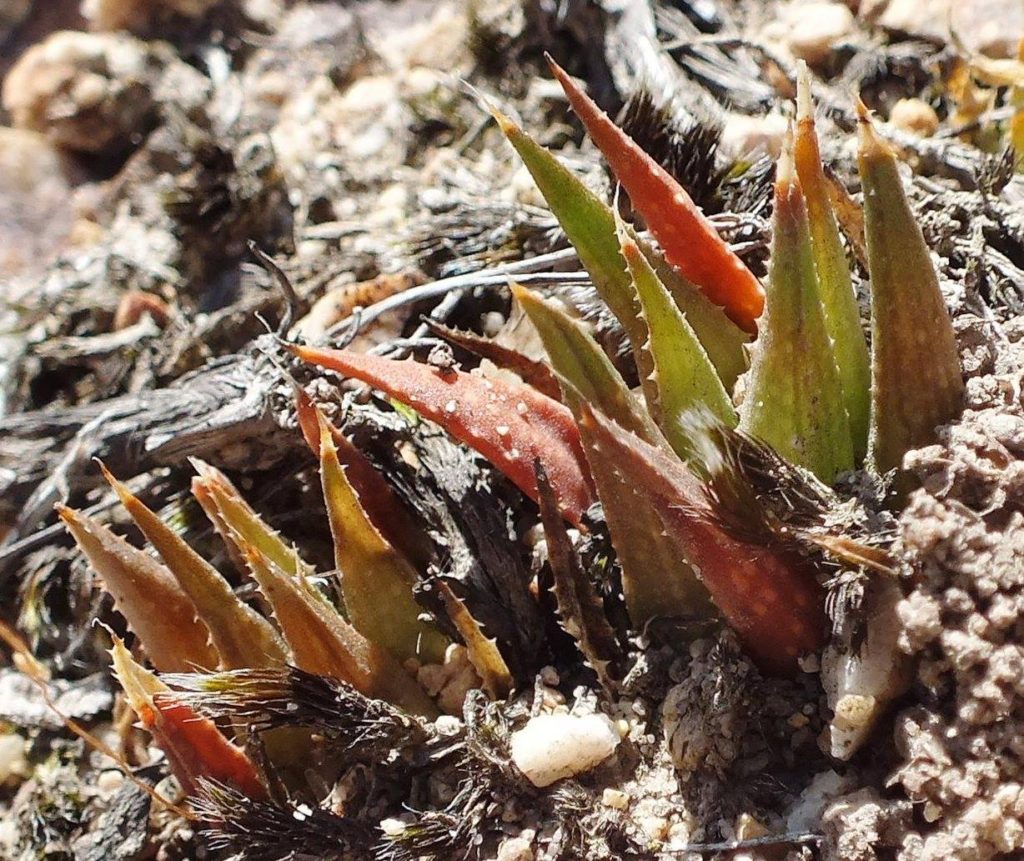
14. Flowers
42. A very critical bit of information is missing in Haworthia classification. This is flower information, which has been traditionally scorned as not informative. Possibly the reason it tells what no one wants to hear. Here are flower profiles for these two imponderable mirabilis (MBB80568) and floribunda (MBB8059) populations from W Swellendam. What do you think?
8058a flower faces (H. mirabilis)
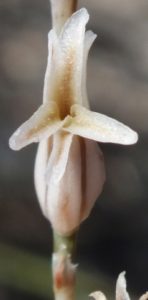
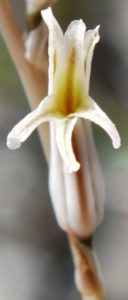
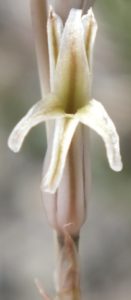
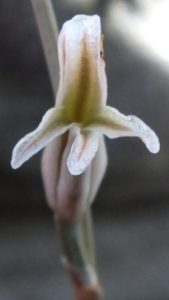

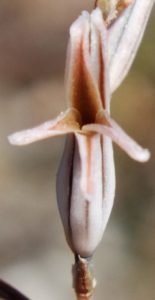

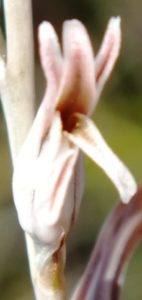

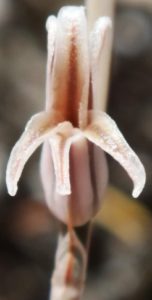
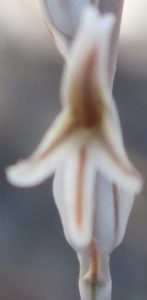
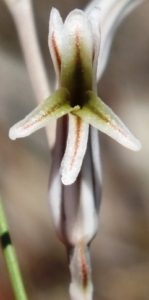

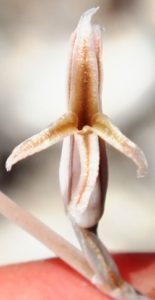
8059 flower faces (H. floribunda)
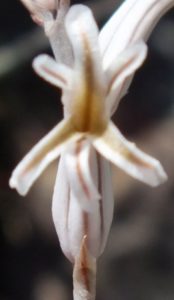
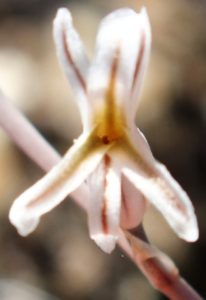
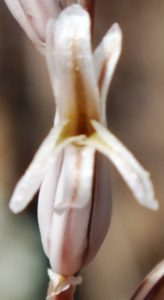

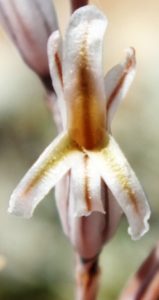
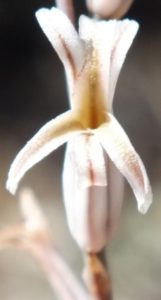

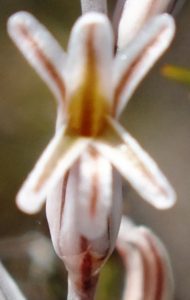
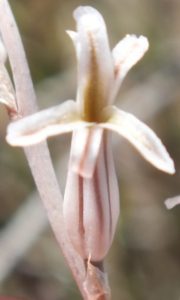

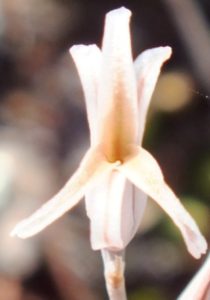
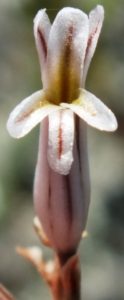
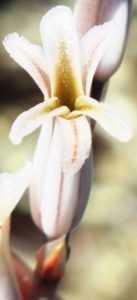
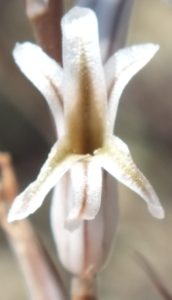

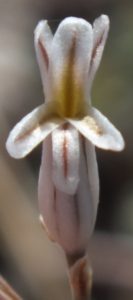
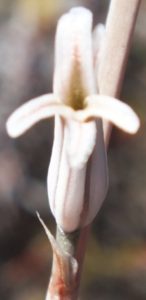
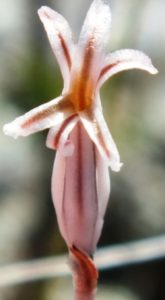
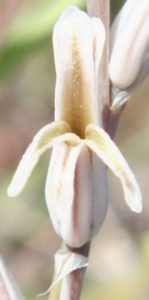
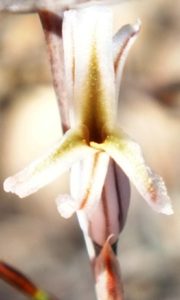
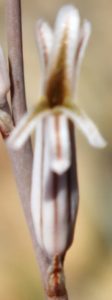
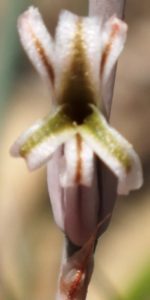
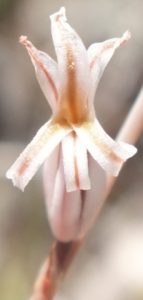
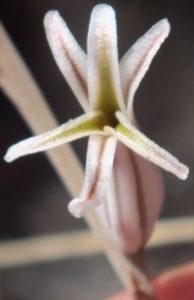
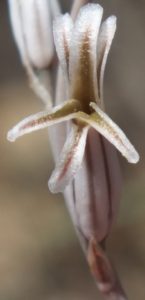
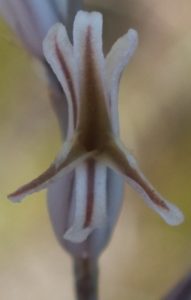


8058b flower profiles (H. mirabilis)
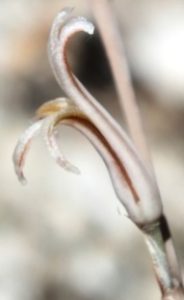
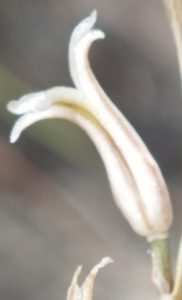

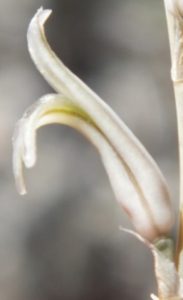
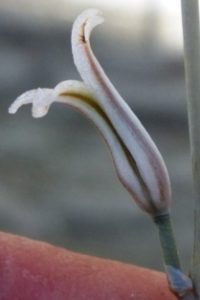


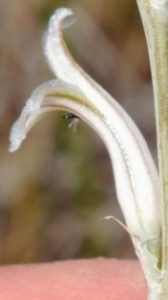
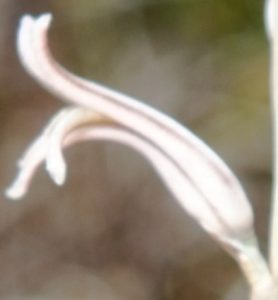
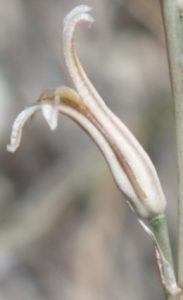
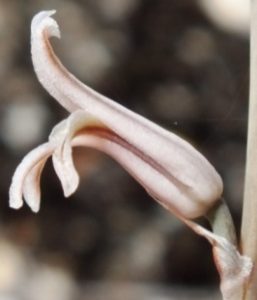
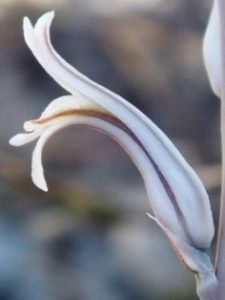
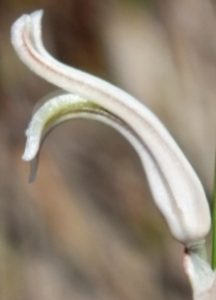
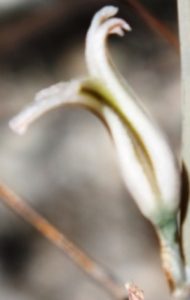
8059 flower profiles (H. floribunda)
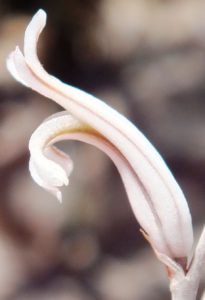
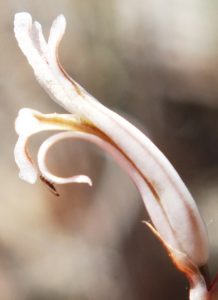
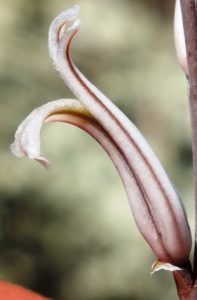
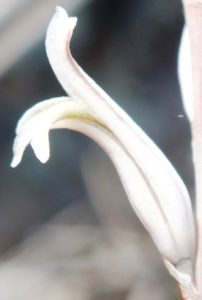
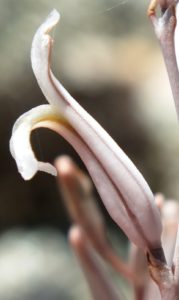
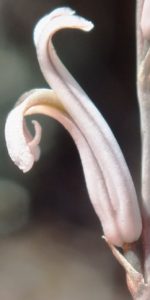

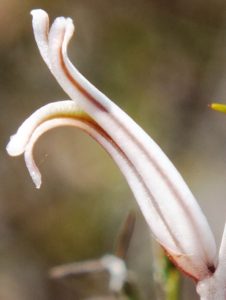
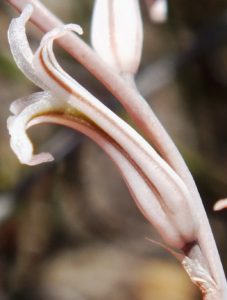
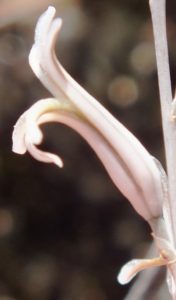
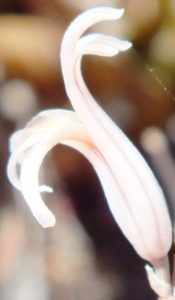
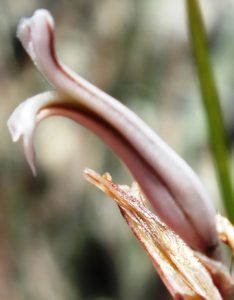
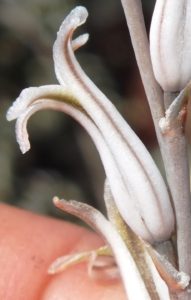
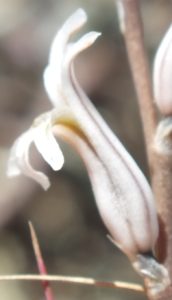
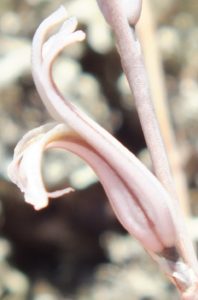
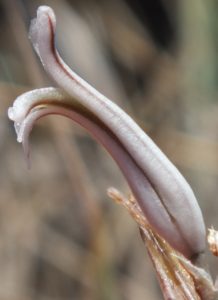
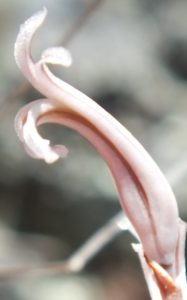

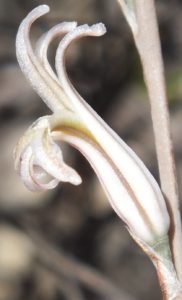
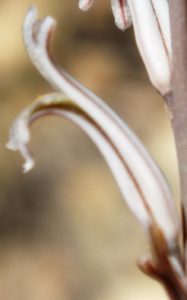
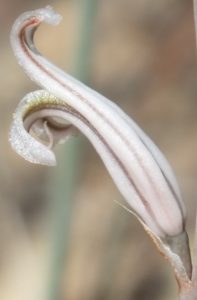
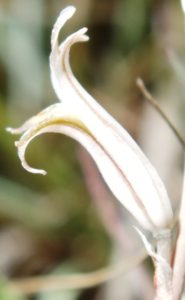
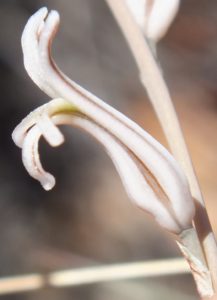



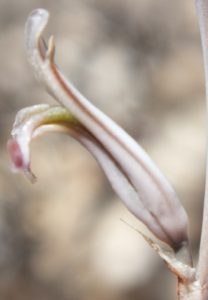

Lawrence Loucka: At a quick glance I can tell these are Haworthia flowers. On closer review it seems the two sets are slightly different, but I don’t have the vocabulary to describe them. The base of the flower tubes, the perigon, seem similar, and the petal center colors range from yellow/green to red/brown in both sets. 8058 top 3 petals seem less spread in face view than 8059. Bottom petals of 8059 seem more curved in profile view than 8058. But if I mixed all the images up I’m not sure I could sort them out.
Bruce Bayer: Yes Lawrence – that is the real rub. I also have sets of pictures of the changes of flowers with age as a complication. My pictures were taken to avoid that. But I also thought that if I halved each set it would also be near impossible to match the halves up again. In Updates I discuss the variables and explain that some of the differences are greater than that on which species are based, e.g. pedicellate vs stipitate, bracts stem-wrapping vs recaulescent, etc.
Bob Guffanti: All other plants are sorted based on floral details, with a little DNA evidence thrown in, and a nod to foliage.
Bruce Bayer: Yes Bob. It is very funny and ironic that the floral differences that distinguish the three “Haworthia genera”, was ignored and that DNA evidence was needed to recognise them. Similarly funny and ironic is that flower similarities are ignored because the foliage are slightly different.
also see …
- Volume 3, Chapter 2:- Flowers of some Haworthia
- Volume 3, Chapter 13:- Haworthia IS confusing
- Haworthia limifolia – a conundrum or a lesson?
- Haworthia flowers – some comments as a character source, part 1
- Haworthia flowers – some comments as a character source, part 2
- Haworthia flowers – some comments as a character source, part 3
- Haworthia flowers – some comments as a character source, Appendix 5
- Haworthia flowers – some comments as a character source, Appendix 6
- Haworthia flowers – some comments as a character source, Appendix 7
- Haworthia flowers – some comments as a character source, Appendix 8
- Haworthia flowers – some comments as a character source, Appendix 9
- Haworthia flowers – some comments as a character source, Appendix 10
- Very brief note re Haworthia nortieri flowers
- A sequel … Still another view of Haworthia retusa and Haworthia mirabilis
- A further report on Haworthia mirabilis in the Greyton area.
- Comprehension and significance
- Haworthia minima and pumila flowers
- MBB7989 Haworthia pumila, Lemoenpoort
- 14. Flowers
- Flowering Time Redux
♦
15. Swellendam H. floribunda
43. 2019.6.17 – Nearer Swellendam to the north west is where there is a bigger version of floribunda similar to this picture. It is unusual because of its pointed leaves. When first found I thought they may be in fact variegata. That seemed very improbable at the time, but since then variegata has appeared at several localities west of the Breede River. It it is otherwise limited to the limestones south of Albertina and west of the Goukou River. So this is an indirect link between the two species that gets very more involved in the south. What is important in the implication of geographical position and physical similarities.
44. 2019.6.18 – Within Swellendam along the highway there is a little patch where floribunda occurs as the more characteristic small plant deeply withdrawn into the soil. Dark coloured and with the leaf tips barely sticking out of the moss and lichen growing on exposed weathered shale.
45. 2019.7.2 – A short way down the road is this monstrous green form of what cannot be anything else but a variant of floribunda. The big question I suppose is “how do you conclude that?” No! You tell me how you can possibly think it’s anything else. It comes from a familiarity with the field, familiarity of what else goes on around Swellendam, familiarity with variability in nature, a bit of academic learning, what haworthias do generally and then just plain common sense.
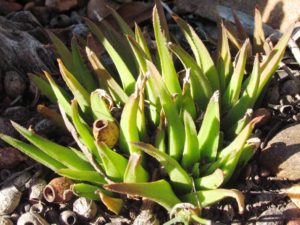
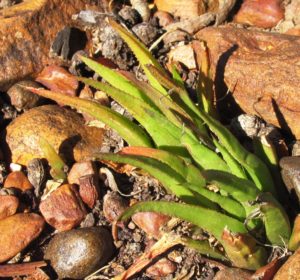


46. 2019.7.3 – A few kilometers east of Swellendam there is this population of green floribunda while another kilometer east returns the smaller dark more familiar form. This strange behaviour of one species is not peculiar to that species. It simply demonstrates that a tiny shred of circumspection is needed before wild declarations of a new binomial identity.
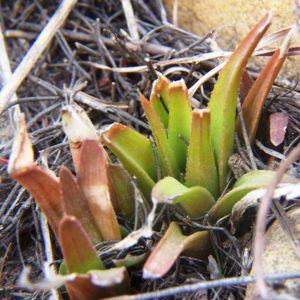
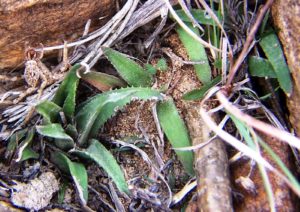
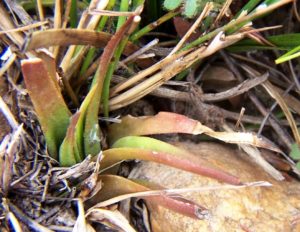
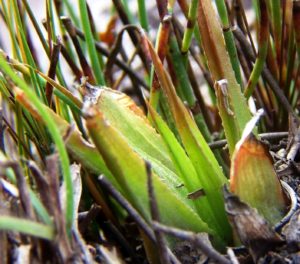
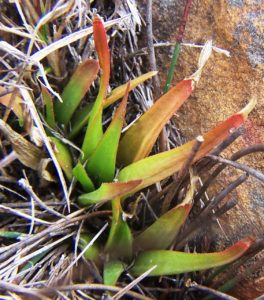

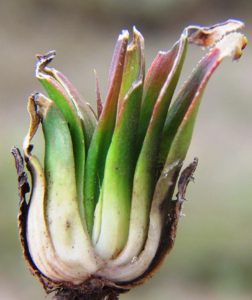
47. 2019.7.4 – In the Bontebok National park, less than a kilometre away from the green and the ordinary floribunda virtually within Swellendam is this little green form. There are also at least 6 populations of the smaller heidelbergensisoid mirabilis – all different from each other. I surmise that this may be of mixed origin – avoiding the term hybridization that implies pre-existing separate species. I suggest outcome from a common gene pool rather than this simplistic dependence on an even more totally speculative guess.
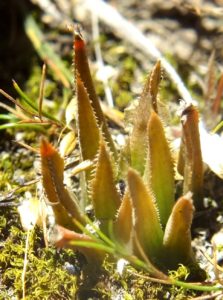
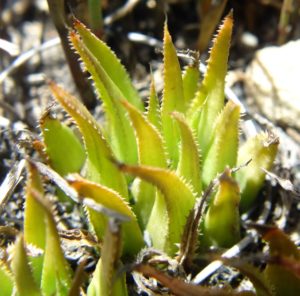
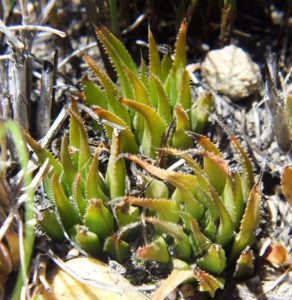
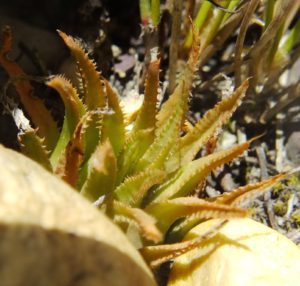
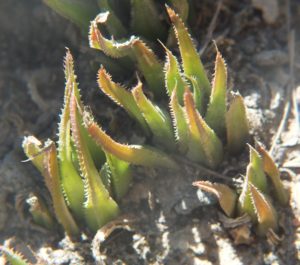
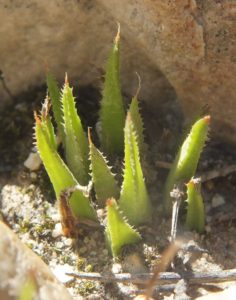
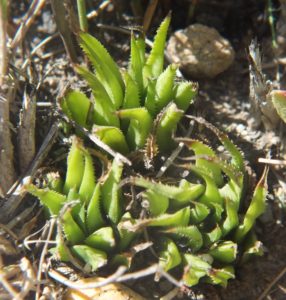
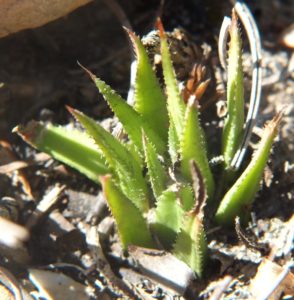
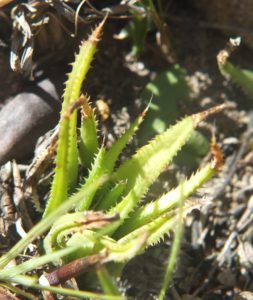
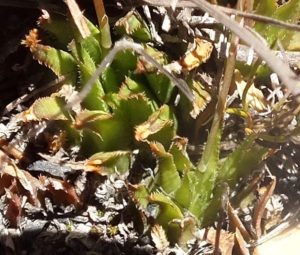
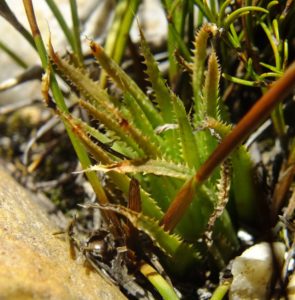
48. 2019.7.5 – Very many years ago I did see the small floribunda within the Bontebok Park but it was extremely cryptic and I was not able to find it again. But just east of the park is this. What is curious is that it is the second of a series of 5 “species”, almost contiguous populations going south to north, each occupying their own space in a near uniform environment. Two of those populations are Tulista marginata and T. minima that vary in some degree from their own species norm and even flower much earlier than they should be expected to. Added to that is the fact that now there are clearly hybrids. So we have a situation where we have two species that may have never truly separated, interacting again? Similar situations exist throughout the Haworthia domain. And I have yet not told half the known floribunda story either.
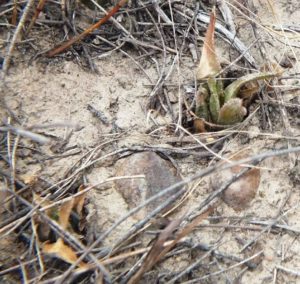
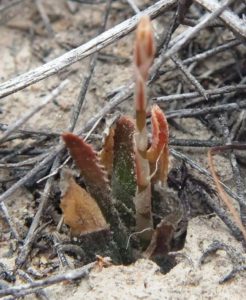
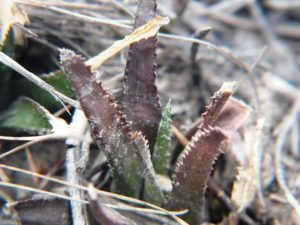
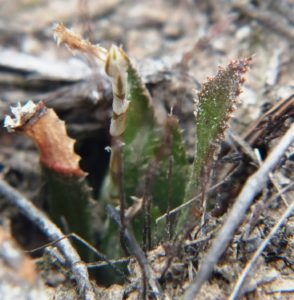
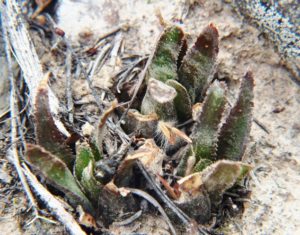
2019.7.6 – In carrying on about H. floribunda (that can be further shown to interact with H. variegata, H. chloracantha AND H. parksiana) it may be thought I have lost track of the prime issue. Not so. The gist of the story is that there are two main elements viz retusoid and mirabiloid. This gene pool disgorges elements that can be labelled H. pygmaea, H. retusa and H. emelyae in the east, and H. mutica, H. retusa, and H. mirabilis in the west. H. floribunda simply demands attention by its involvement and by what it does in its own right. This brings me to something else. I have a near polymath friend who does top-level seriously academic work in major plant families. This source mentions the promise of next generation sequencing. In trying to understand the technology all I could really grasp was this end statement … “The only thing slowing us down now is the interpretation of results.” At the same time I was pondering the phylogram for the aloid sequencing I was unhappily involved in (two major attempts). Especially about some peculiar relationships expressed in that phylogram. It is tough having a small brain when such complex issues need scrutiny and question. But those peculiar relationships (I hesitate to point directly at them now because it means many words and browsing slowly through many files for which I lack patience), require to make me say emphatically … ”A two dimensional array can definitely not illustrate what is a minimally three-dimensional space/time product (species)”. So my contribution is, that while the interpretation of the results rests on a two-dimensional phylogram, the result will never be worth what it should be. ♦
16. How groenewaldii got it’s dots
49. 2019.7.7 – My argument is of course largely directed at “H. groenewaldii” because the binomial so sadly mirrors the pains of Haworthia classification. When I first wrestled with the issue of H. retusa var. nigra in 1969 I did so because of a G.G. Smith’s photograph of a similar plant recorded from Buffeljagsrivier way back pre 1947. I “guessed” that this Buffeljags phenomenon was central to the Southern Cape retusoids and must have some relevance to Smith identifying the Kransriviermond hybrids as H. mutica. So its “(re-)discovery” and description more than 50 years later comes when when we should have learned something about taxonomic problems. Unless, one persists with a blind belief that there are countless species that owe their separate existence to origins from outer space (panspermia) and at any moment, “groenewaldii” (by resort to ordinary common sense) must relate to other Haworthia in the Southern Cape. Just as H. floribunda surely does. But I have found it hugely frustrating and sheer tiresome, to have to deal with the kind of taxonomy that gets dished up to collectors by amateur taxonomists in amateur journals who have no greater insight into the mysteries of life than the most modest collector wholly unconcerned with the issues of relationships and origins. So I will turn to “groenewaldii” now and if any reader imputes its extraterrestrial origins, I think they must click elsewhere. :) It is said … ”Hell hath no fury like that of a woman scorned.” Does hell also have no obduracy like that of someone honoured in a plant name, defending it from sub summation? The taxonomist gains too much from the side benefits of using personal names as binomials and I have experienced this with “tauteae”, “meiringii”, “pringlei”, “vincentii”, “armstrongii”, “kingii”, “leightonii”, “blackbeardiana”, “battenii”, “cummingii”, “davidii”, “mortonii”, “jakubii”, “baylissii” to name but a few. So many (with sincere and warm regard for each persona so honoured) that almost the whole nomenclature of Haworthia seems to rest on the creation and preservation of mutual and self esteem? There is of course a “bayeri” too! I would happily lump that if it produced a truthful classification and if I knew where it better belonged. This is what is described from Buffeljags – are they commonly like this?
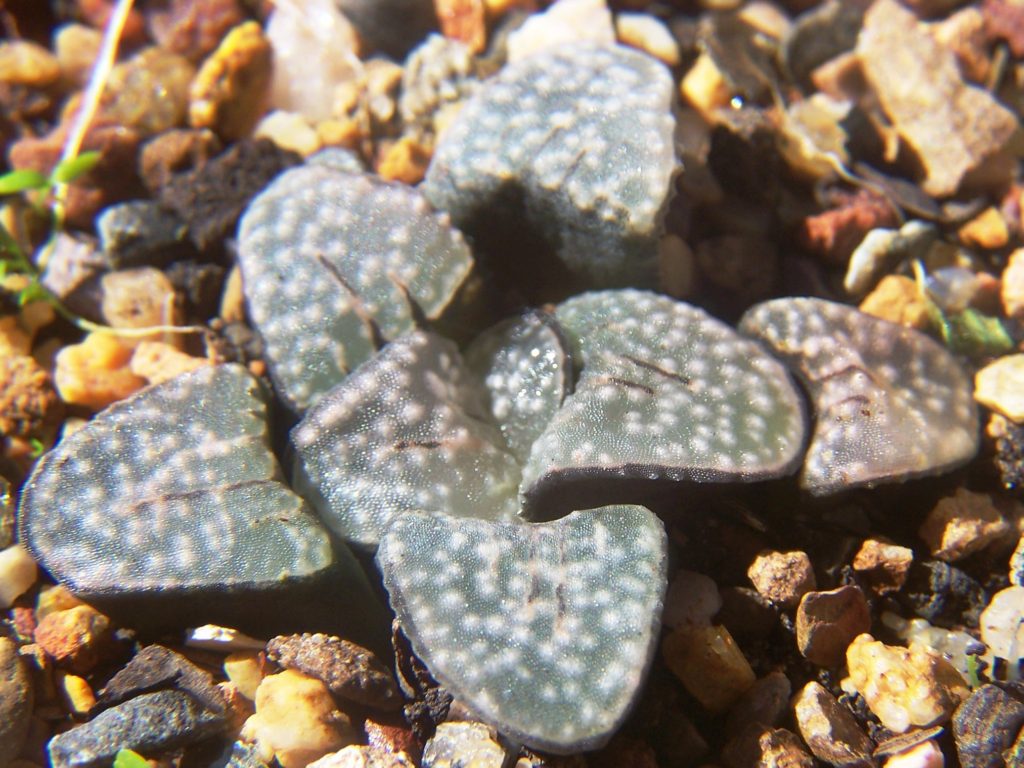
The answer to that last question is of course … ”No they are not.” Where do those spots come from? Outer space naturally. :) DNA dropped from a passing comet, and a bit also straying to the floribunda a little further east? See pics. There is also a mutica to the south west with teeth like a floribunda – new species? H. tigrina?
Is there a good explanation for a sequencing product? I mean who said the only problem now is trying to explain a sequencing result? A phylogram is a print-out of a sequencing exercise that presents a two dimensional tree of relationships. In the sequencing research where I have been involved in (unfortunately, as I said) the names were known to the researchers only by virtue of the written label attached to each sample. How a result can possibly be interpreted on that basis alone, staggers the imagination. On the other hand there are scientists who do at least have some idea of what the names are generally attached to, and for some weird reason assume the phylogram is telling them more than what they were able to deduce from direct observation. That is wishful thinking. Is that somehow linked to the equally weird lack of a rational species definition applicable to the plant world? It did NOT need DNA sequencing to tell anybody that Haworthia was three quite different sets of things and that Haworthia sensu stricto was further from Aloe than either Haworthiopsis or Tulista. It is no joke that there is one school that proposes one large genus Aloe, and another that splits it into a myriad of genera. The same information is available to both groups. The truth may be that DNA sequencing is also telling us that our species concepts are simply too narrow and we do not like that. ♦


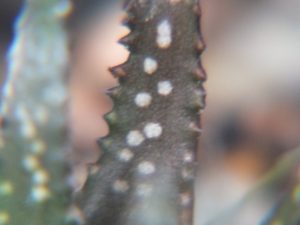
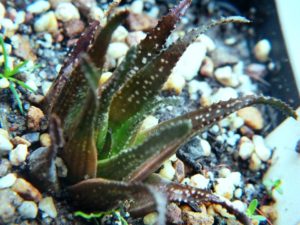
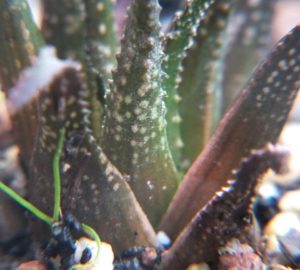
17. H. mirabilis and groenewaldii
50. 2019.7.9 – While I have dwelt a bit on the oddities that comprise H floribunda, I have said very little about H. mirabilis. In my early days I recognised things like H. maraisii, H. magnifica, H. heidelbergensis and how specimens cited from von Poelnitz’ H. nitidula may have actually been drawn from 10 different species of the time! I have since written extensively about H. mirabilis and pointed out several times the “problem of H. magnifica”. The population that this “species” was drawn from is so variable as to stagger the mind, and yet not that different for each of the many other populations. Yet the biggest purveyor, and one of the supposed all-knowing experts on Haworthia tells me that the binomial H. magnifica makes sense to him. Nothing can be more bizarre than this. A truly mental distortion. Influence of the moon. : ) So please bear in mind that H. floribunda is not some out-of-the-ordinary mix of unlike things. Here are just a few variants from the “magnifica” source, and one (at least) definitely infused with H. retusa. Call it hybrid if you insist.
It should perhaps be remembered that it has been mistakenly assumed (particularly by G.G. Smith) that Haworthia could be revised in the same way that Reynolds did with the genus Aloe. In Aloe, the individuals in the population are close to identical and in fact also from population to population. Haworthia taxonomists use the same approach today and it does not work. It is plain fraudulent to base a description on what is essentially an unrepresentative specimen or sample. Hence the absurdity of a statement that any description could have been reasonably made of a population like that of H. magnifica, and make sense.
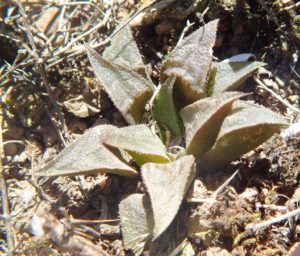
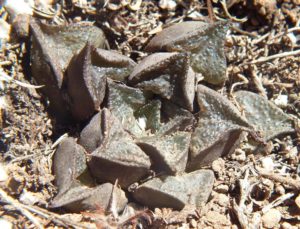
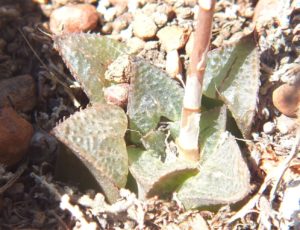
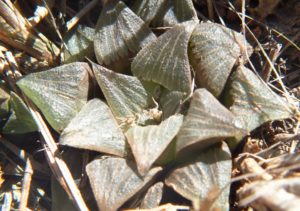
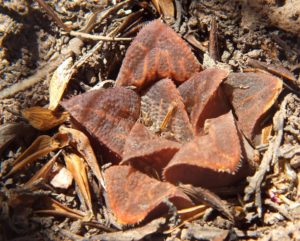
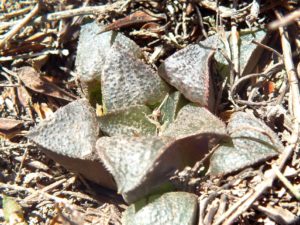
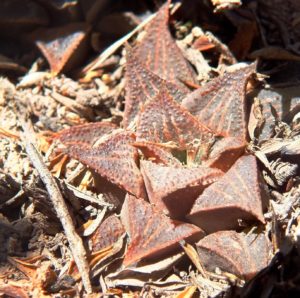
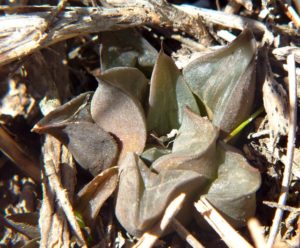
51. 2019.7.10 – So let us look now at these amazing plants that comprise H. groenewaldii without confusing respect and deep consideration for the persona, the equally remarkable quality of the plants, with the problem of a classification that is true. The habitat on the east bank of the Buffeljags River needs to be noted as quite unlike any other occupied by the retusoids/mirabiloids/emelyoids. It is shallow alluvium over a very old shale layer.
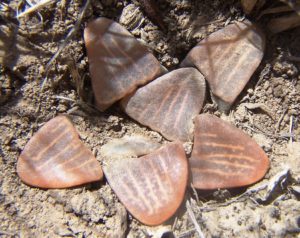
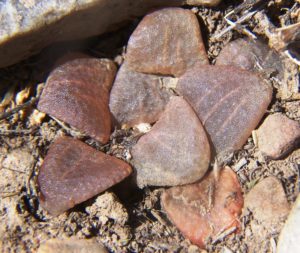


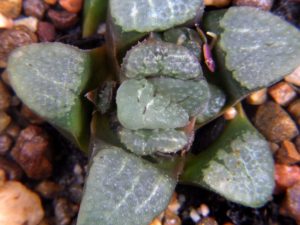

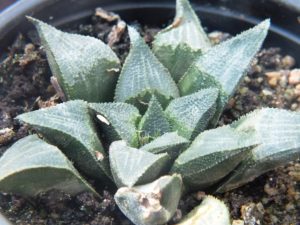
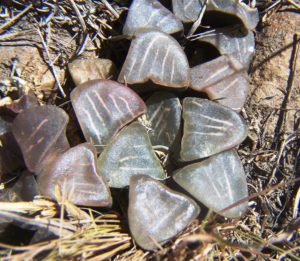
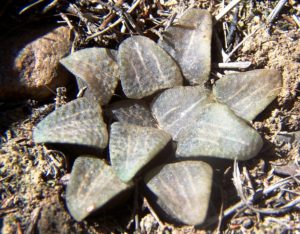
Lawrence Loucka: Is the pointy tipped one from the same population?
Bruce Bayer: Yes Lawrence, I am glad you asked – and this is how amateur taxonomists depart from basic principles. A basic principle is that a species is a universal truth and all inclusive – so this must be H. groenewaldii too just as are all the other variants that are side-lined. There is absurdity and incongruence in the way these things are described and typified. This is what I highlighted in the case of H. magnifica. More to come.
52. 2019.7.11 – On the east bank there are 3 fairly discrete populations and it was obvious that looking across the flood plain that they must also be on the opposite west bank. Sure enough, also 3 and more discrete populations. Now there is a difference between east and west bank. The erosion/deposition cycles are or were, quite different. The east bank is abutted by wheat fields while the west bank is a nature reserve (Bontebok National Park) precisely because it was unsuitable for agriculture!! Thank goodness for non-arabiity. But like the east bank there is a veneer of alluvium of probably equal age. You can determine if the plants on the two banks are strictly the same by the same criteria “new species” is touted. Mirabilis, floribunda, and Tulista marginata. T. minimima in proximity but all in discrete habitat. There is some pupping but the plains dwellers are less prone to pupping than cliff occupants anyway.
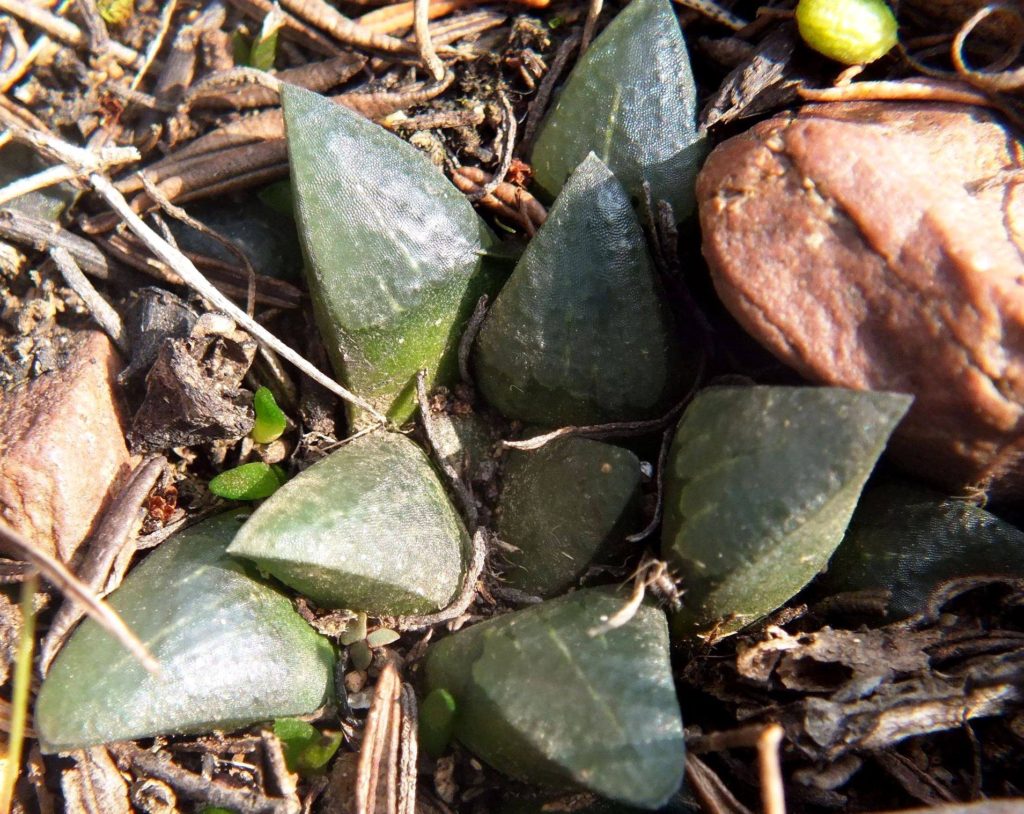
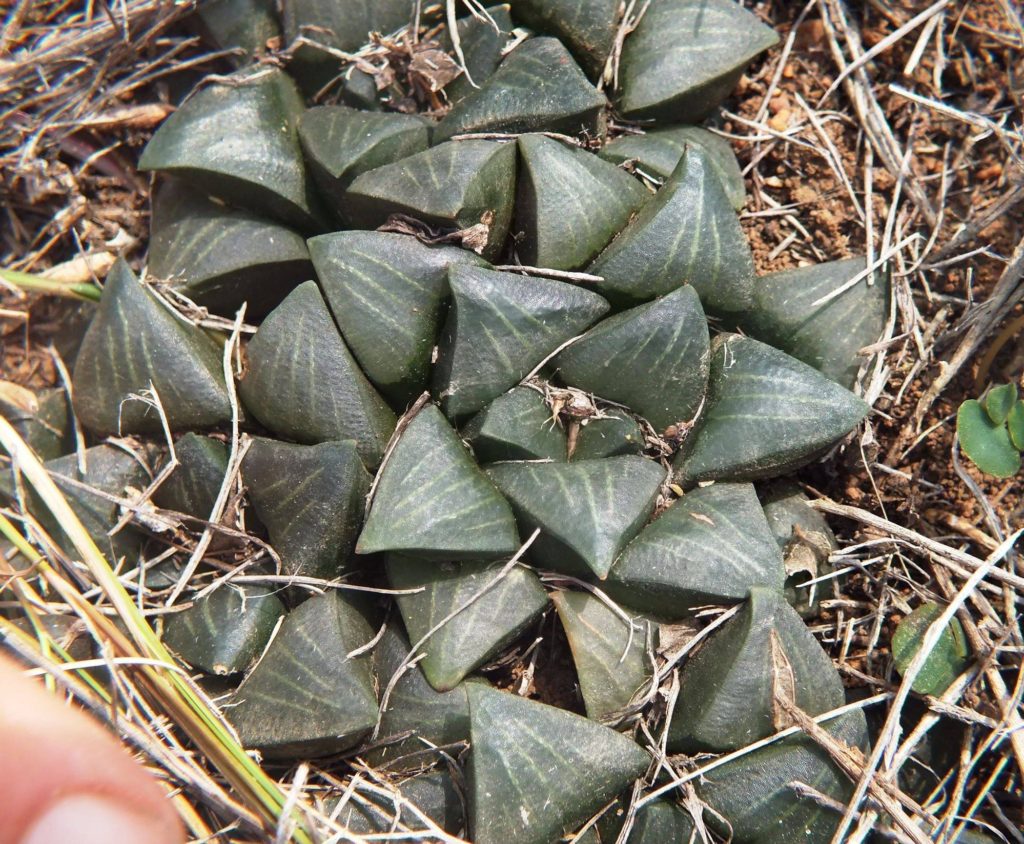
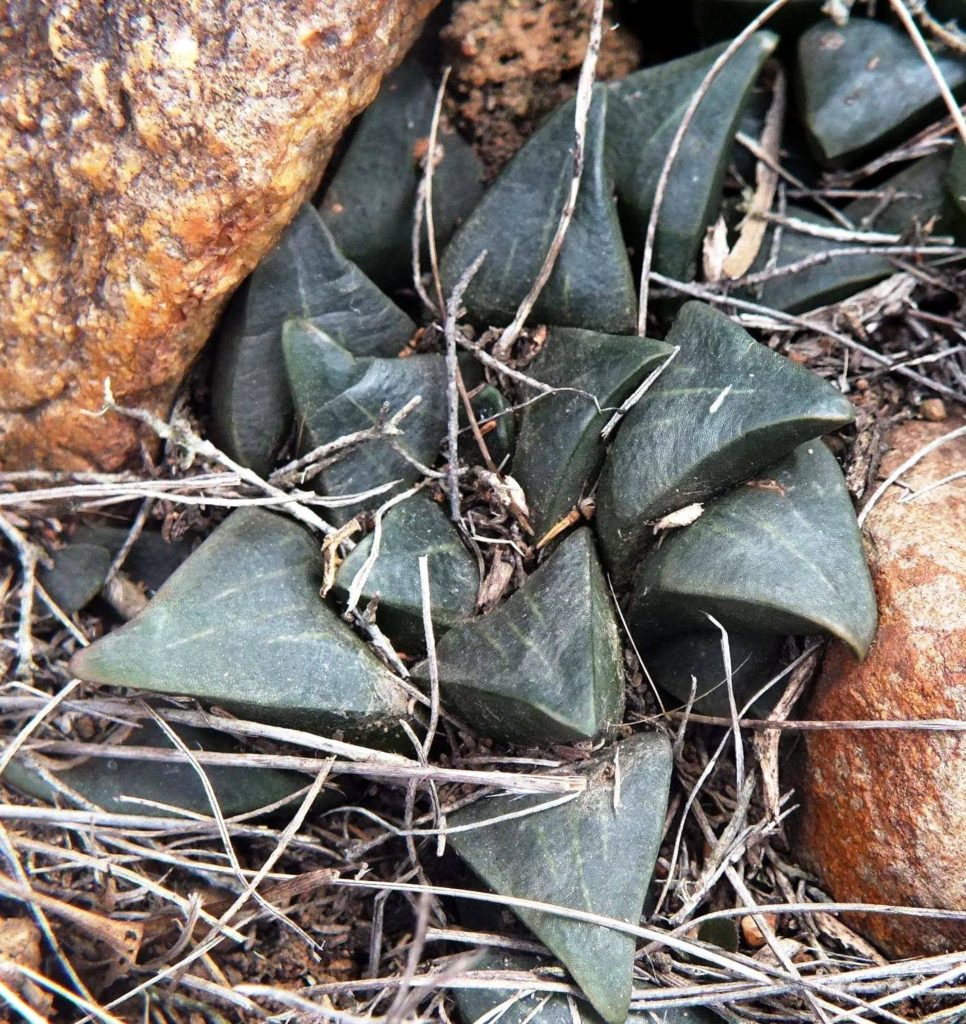
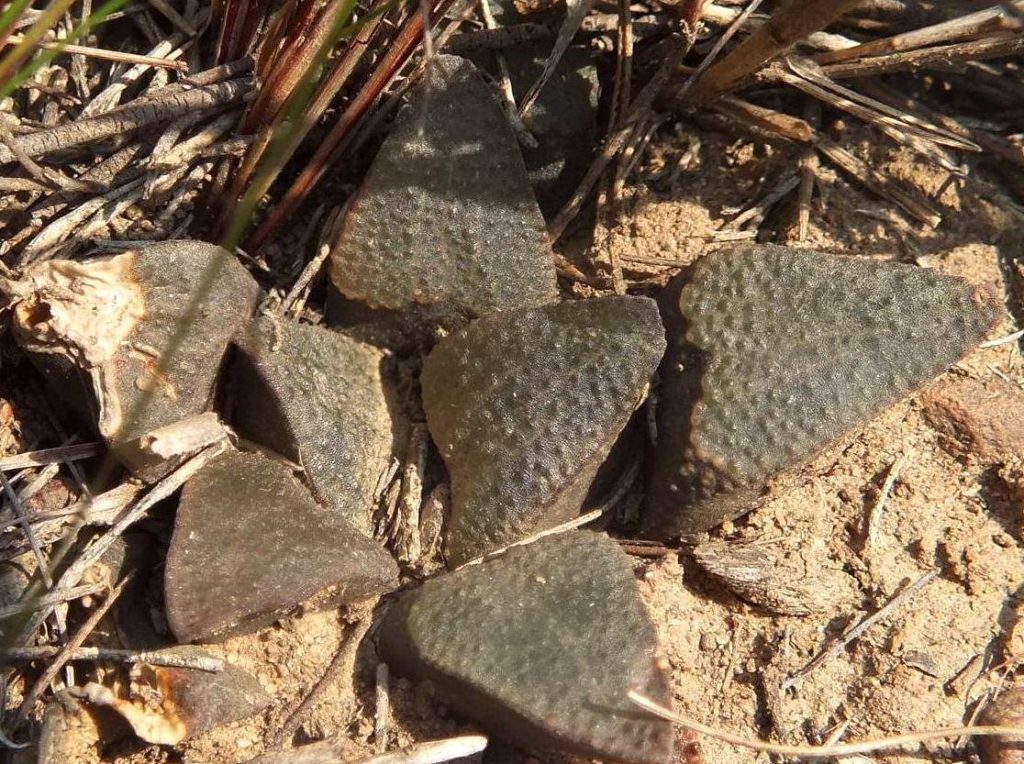
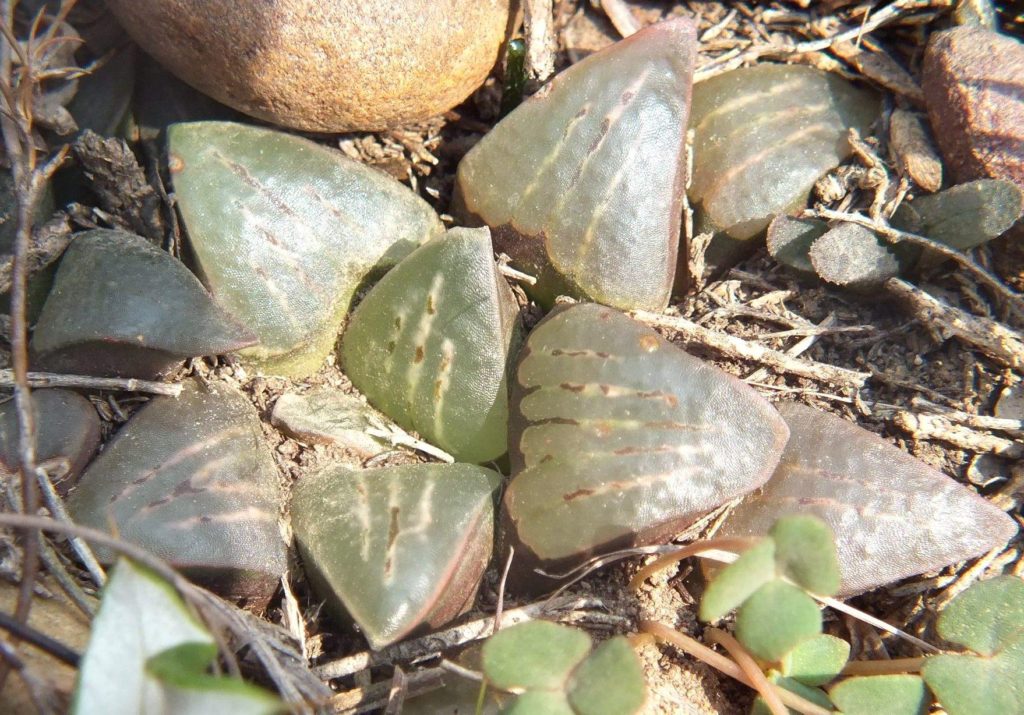

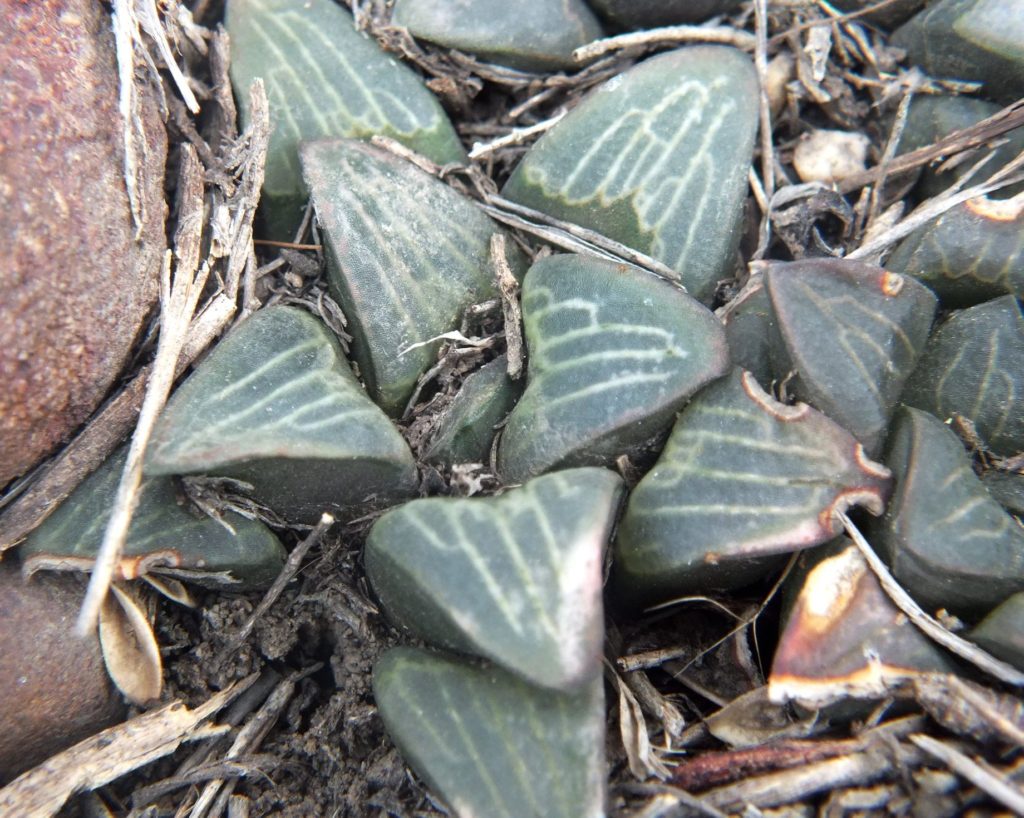
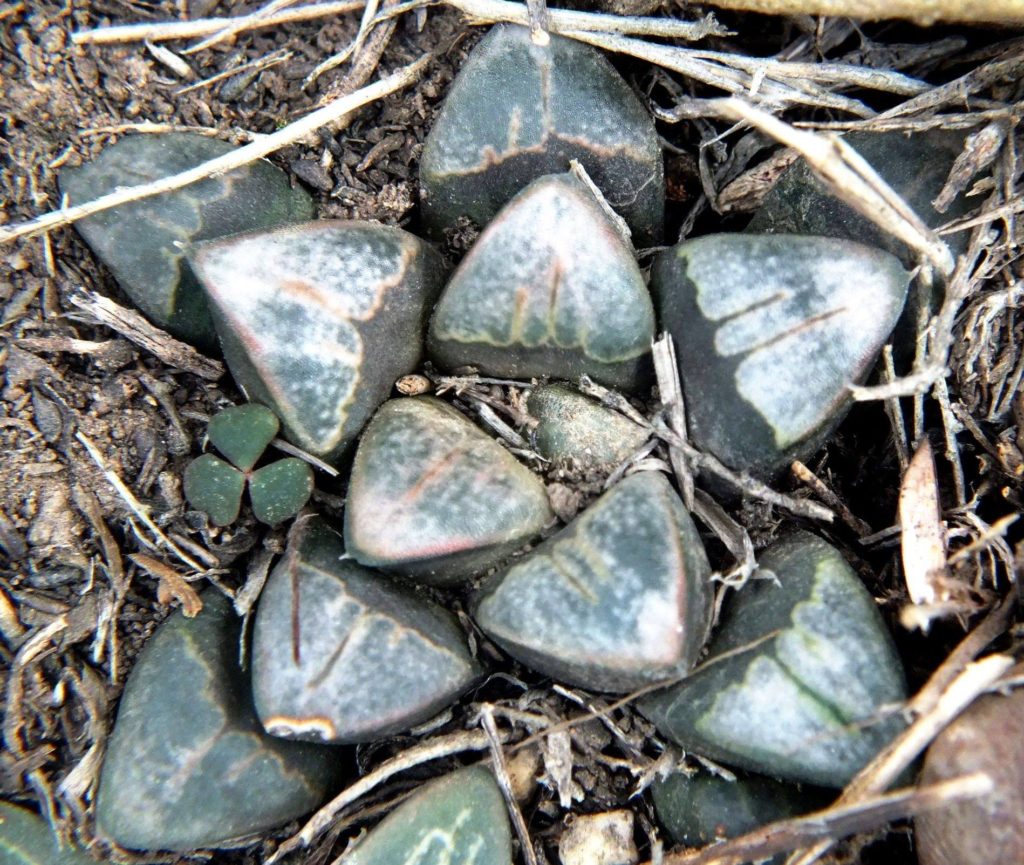
53. 2019.7.12 – Now a second population from the west bank and from these few pictures you now know what groenewaldii unmistakably is? You also have a good image of H. floribunda? and H. retusa? and H. mirabilis? and you think H. magnifica is a good species? And of course like the author of the H groenewaldii you know H. mutica intimately. Some surprises in store for you. Perhaps from the limited array of pictures posted here you are better equipped than some of these taxonomists who proclaim names. ♦
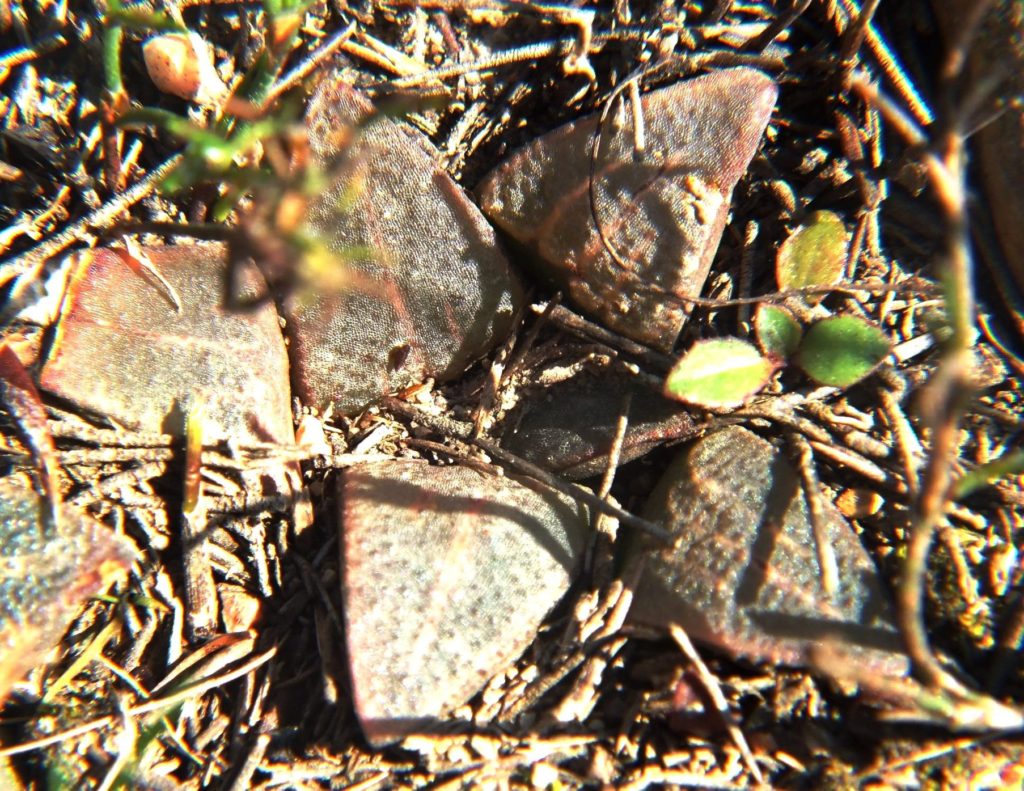
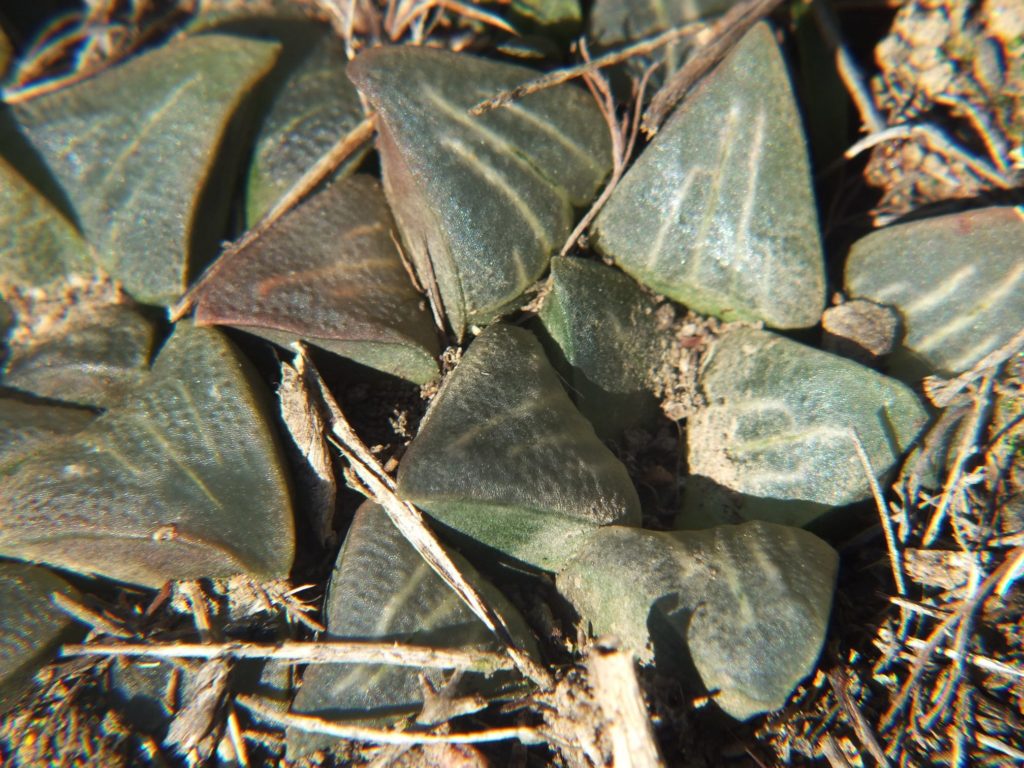
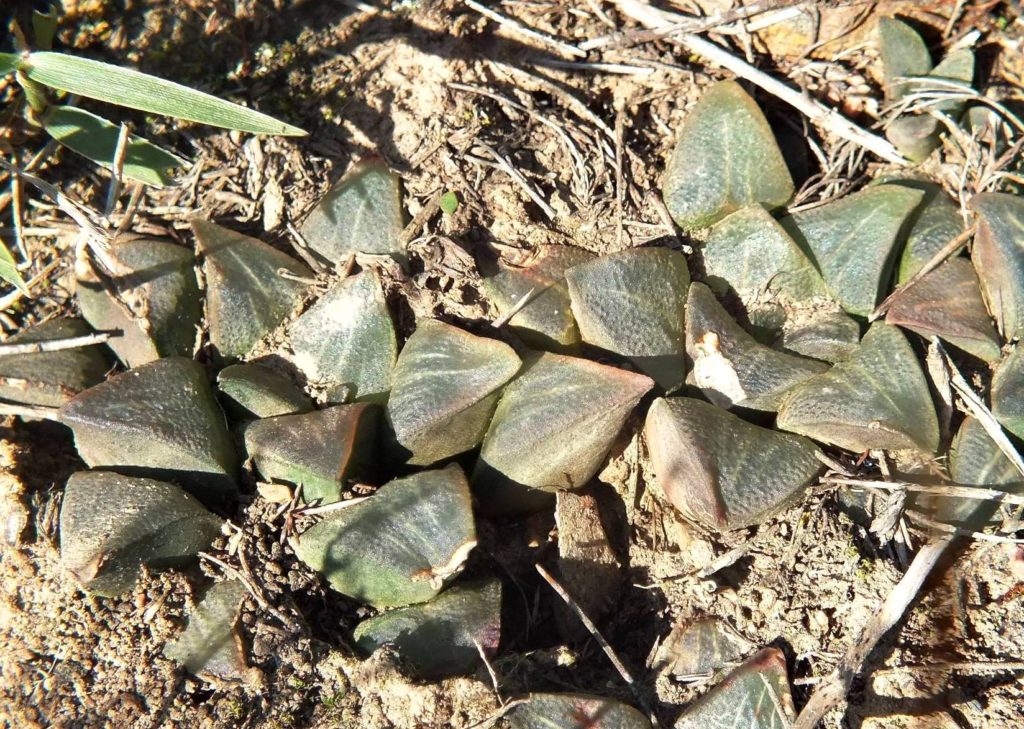

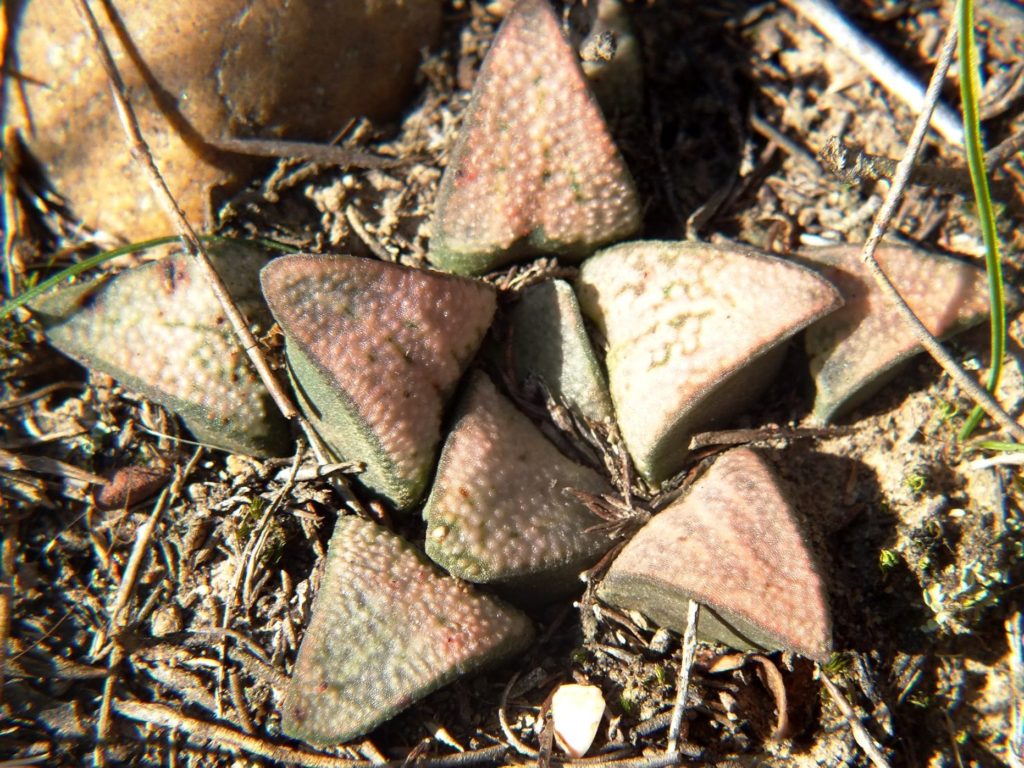
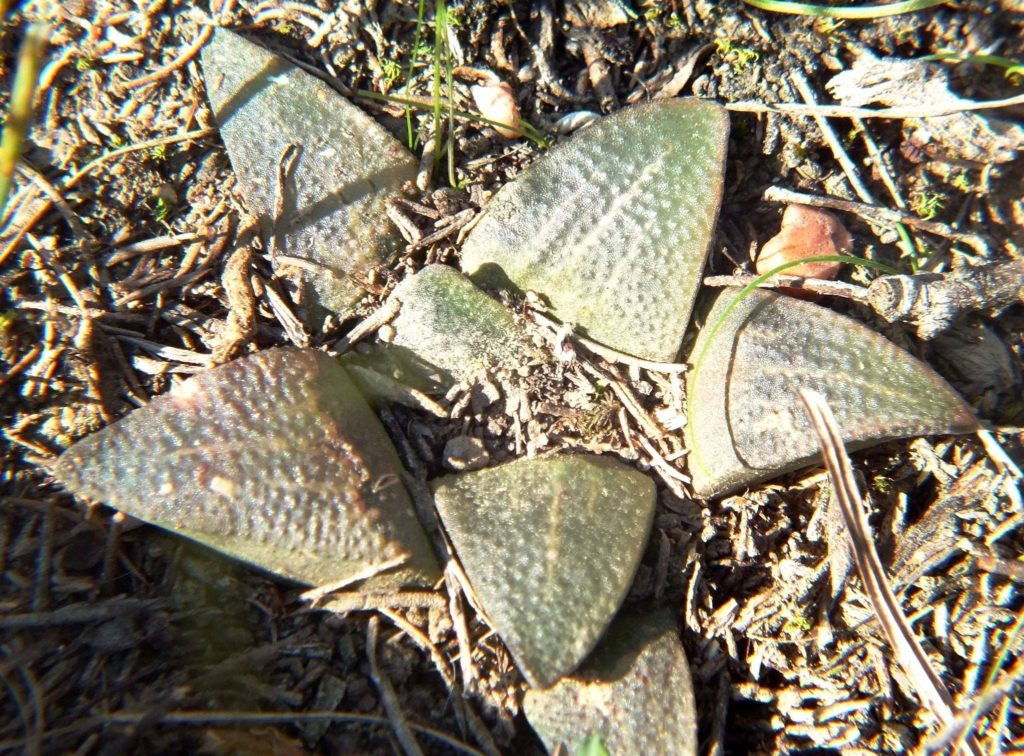
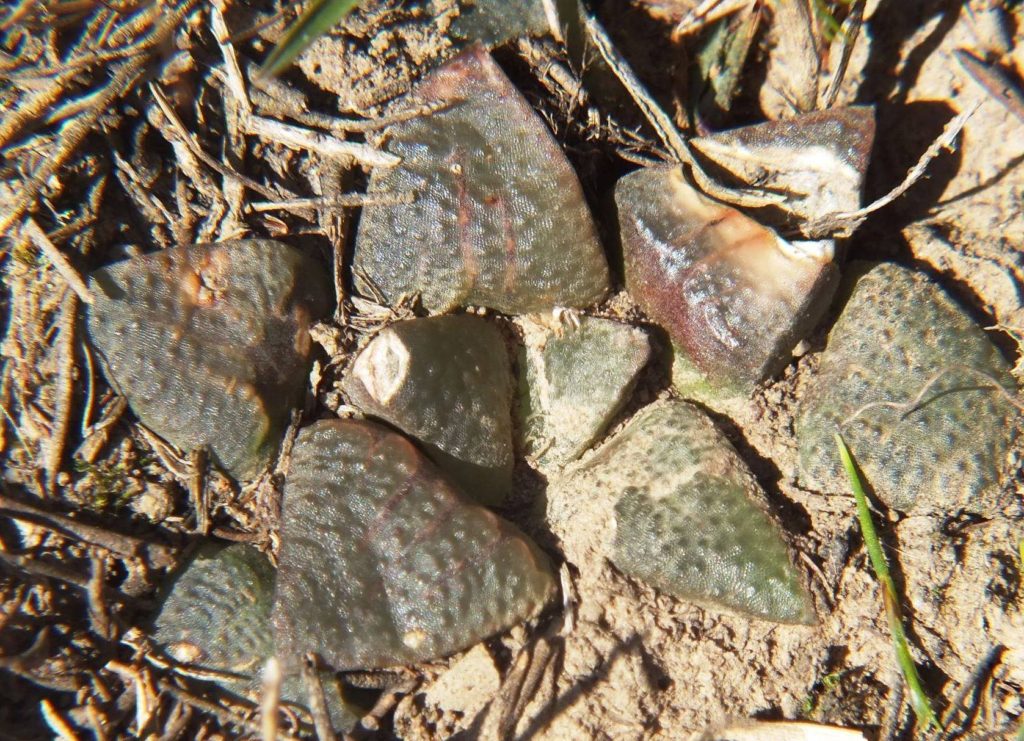
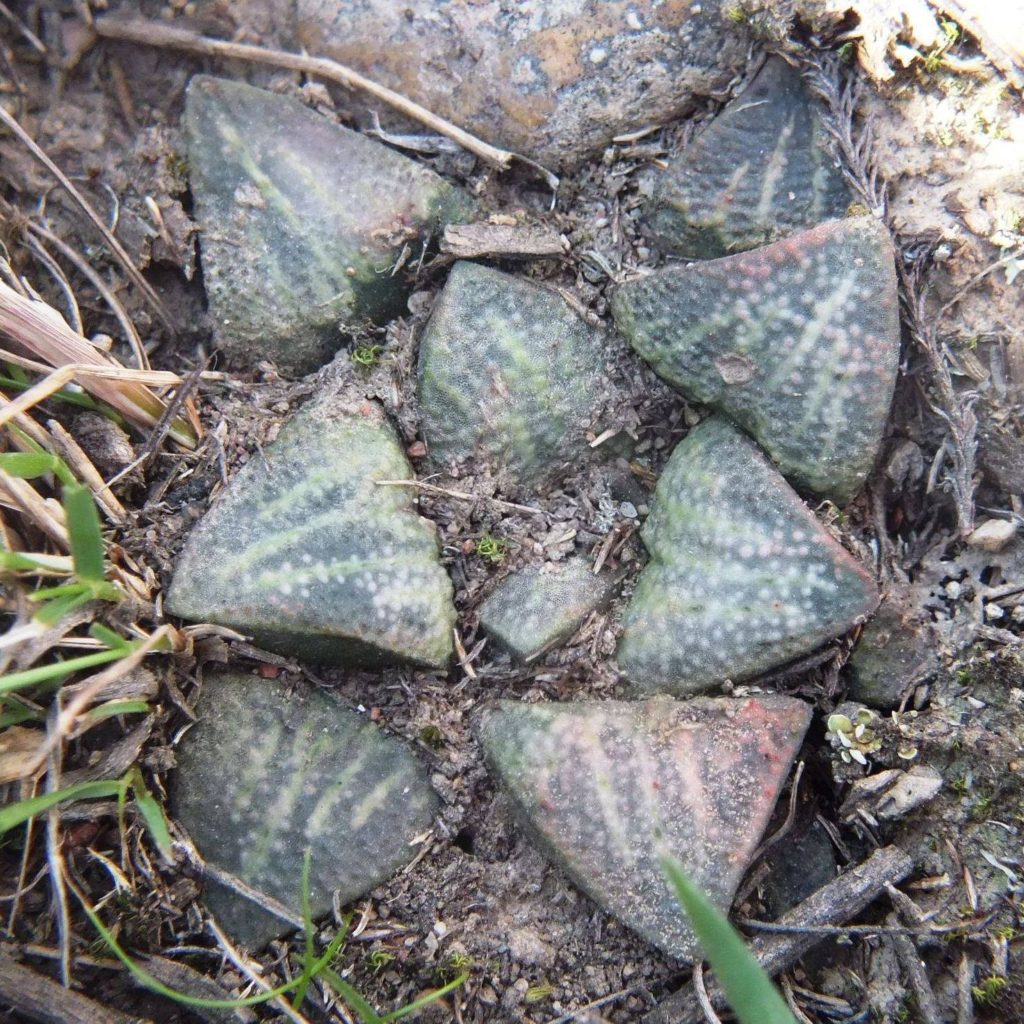
18. Recap
53. 2019.7.13 – Another recap. Species are supposed to be primary discrete life forms both in biology and in metaphysics. The definition should be the same. But it does not seem to bother botanists that they do not have a rigorous strong definition or more often, any definition at all. It does exist for zoology. Also for metaphysics but who knows what that is, or bothers to ask? There are some scientists that dispute the existence of “species” but they are probably also not taxonomists. But leaving that aside. If we are going to insist on Latin binomials, we really do need to be sure where the things we name, stop and start. You would think in the case of groenewaldii that the boundaries of mirabilis, emelyae, pygmaea, mutica and retusa (and even floribunda) were known to its author(s) and protagonists, and defined with some sense of certainty. Not so! So from Buffeljags I will jump to Area 1 of the given map and demonstrate the problem with H. mutica starting with just one locality in the south west (MBB7937). It is only problematic because the plants are associated there with white quartz in different stages of decay. This white quartz occurs in lenses up to 1m thick but also in thin strata. The erosion rate is slower than the shale that it is embedded in, and the plant associations are related to such differences. But this white quartz is not a requisite for the presence of H. mutica that also never shares habitat with H. mirabilis. I have about 40 pictures so see if you come out with also an unerring idea of what constitutes H. mutica as you now can with H. groenewaldii. This is so that you can be comfortable with names as binomials that makes sense, while there are also so many other populations that the narrative may extend to.
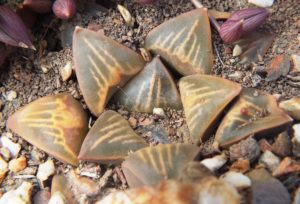
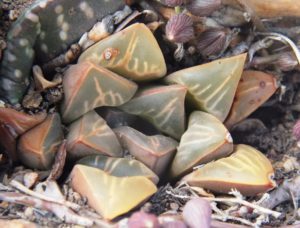
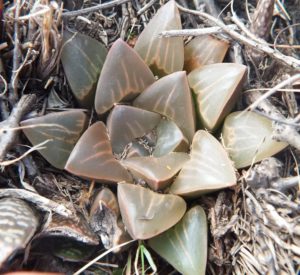

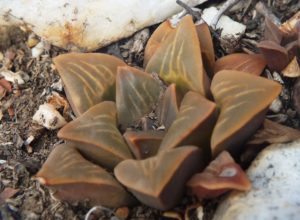
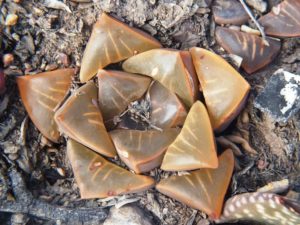
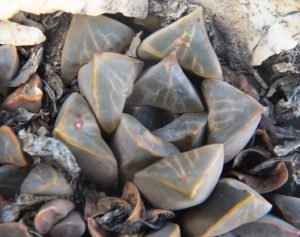
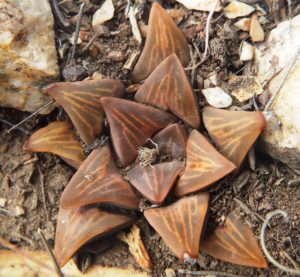
54. 2019.7.14 – It is quite easy to fool yourself into thinking it’s easy and that this lot is distinctive. But remember it is a quite new habitat and thus different growing circumstances. Many of these plants could be taken and deposited in populations across the Southern Cape without much chance of being recognised as misfits. Paradoxically, mutica is possibly one of the most homogeneous of the groups I still recognise as “species”, but the warning is that this may not be true. I have often commented on my early amazement to find a plant of H. mutica from Bredasdorp identical to one of H. pygmaea from Mossel Bay, in every respect apart from a slight colour difference in the bracts. Notices how the leaf tips of the first 8 leaves of the plant in the 6th picture, vary – pointed vs. rounded?




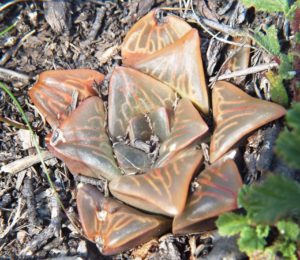
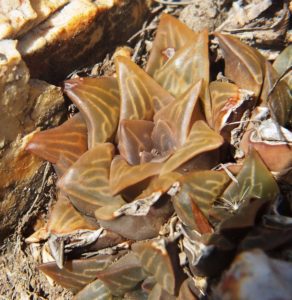
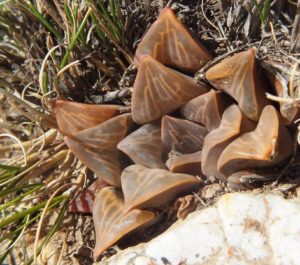
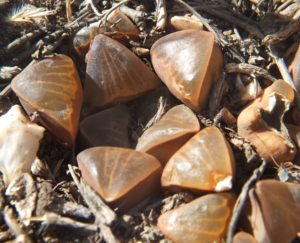
Lawrence Loucka : mutica means ‘without a point.’ If pointed, then can it be Mutica?
Bruce Bayer :) Of course – but this is a bit of the typological approach.that bedevils classification. You have been in the field and experienced how we grasp at straws to explain why we think we are looking at magnifica or maraisii or atrofusca or something from some other population while we are unable to come to grips with the totality of the single population we are in. The raw and inexperienced jump straight to “new species”! Looking for differences rather than similarities?
55. 2019.7.15 – I am curious to know what people are thinking … “Hey these are nothing like Buffeljags?” If so you join the club of a majority thoroughly fooled? If anything confirms the fact that geology and substrate chemistry are major role players, this is probably it. Where Buffeljags is essentially alluvium and a depositional surface, this white quartz is the rawest remnant of an erosional surface. What you will still see is that what is as a rule a non-proliferating plant, also coming out as highly off-setting (pupping). Could be this is related to the propensity of cliff hangers to pup furiously, on an erosional surface?
I note for the first time that there may be pattern in the sequence of truly leaf-without a point, and and successive leaves being less so?
Also notice on the 6th photo that this plant has comptoniana-like reticulate venation.
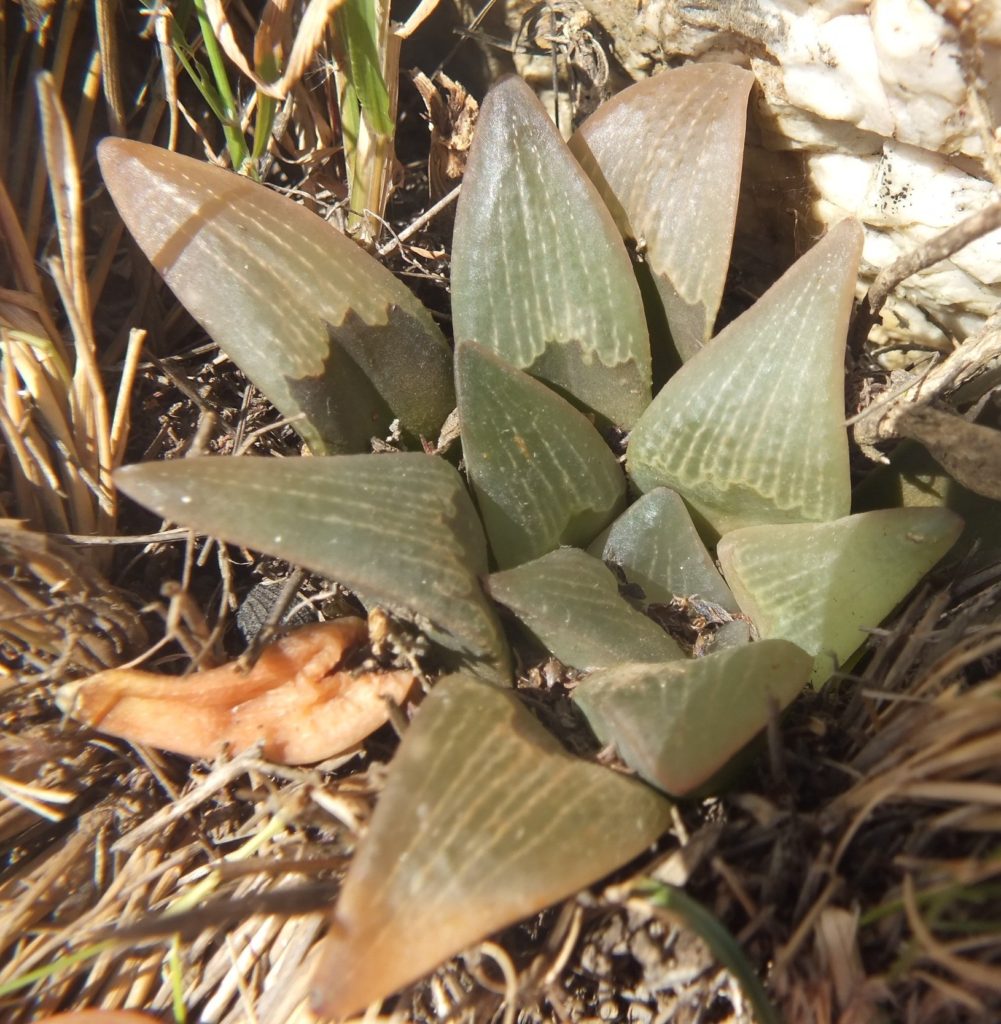
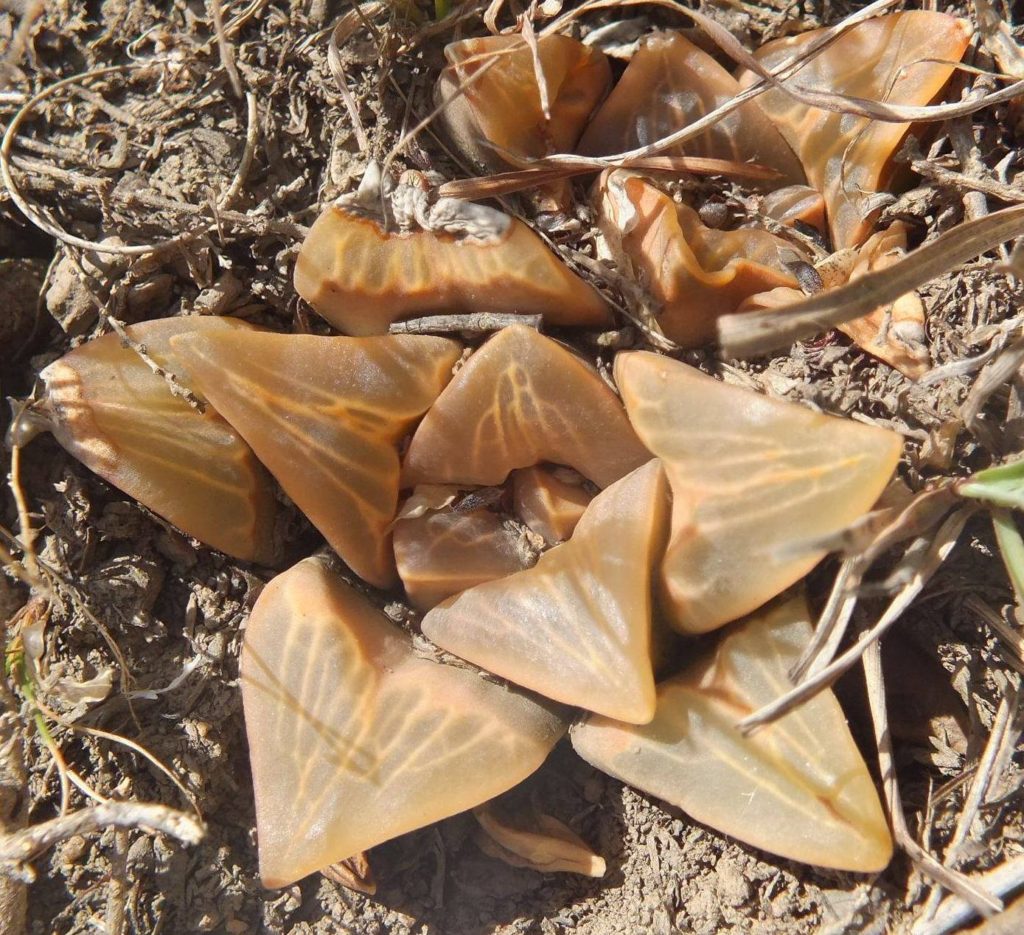
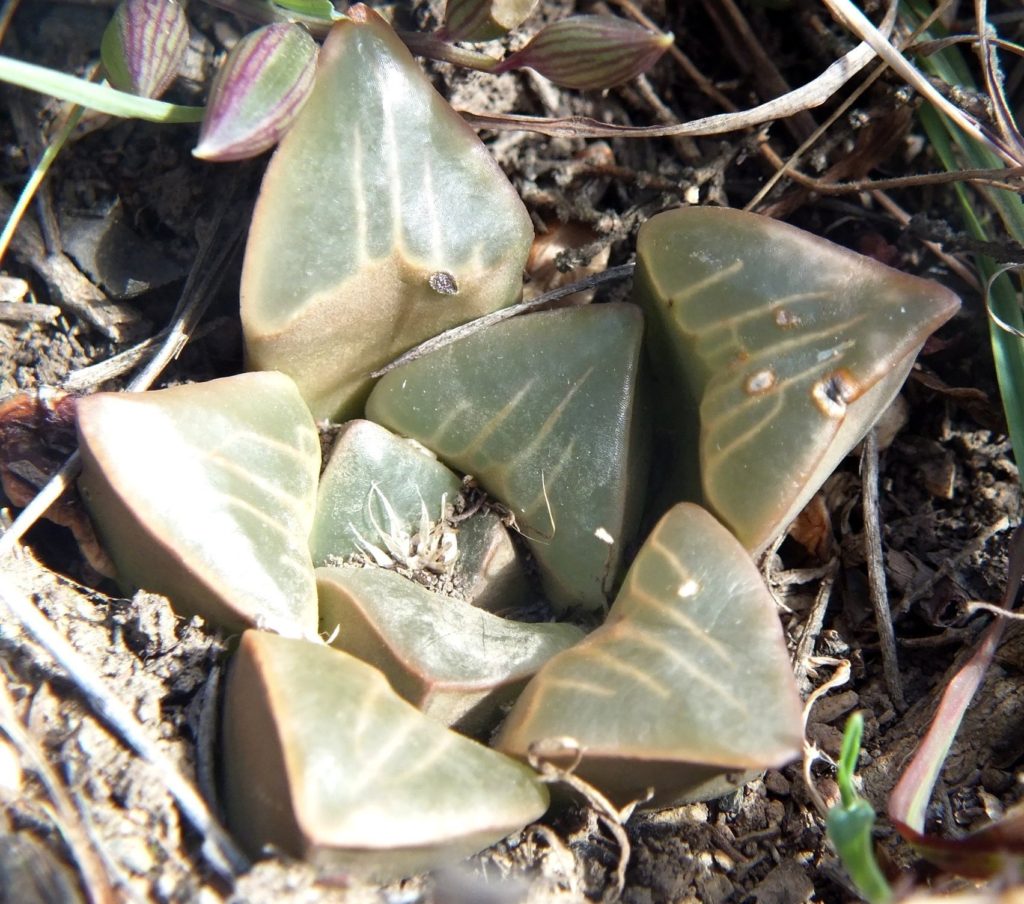
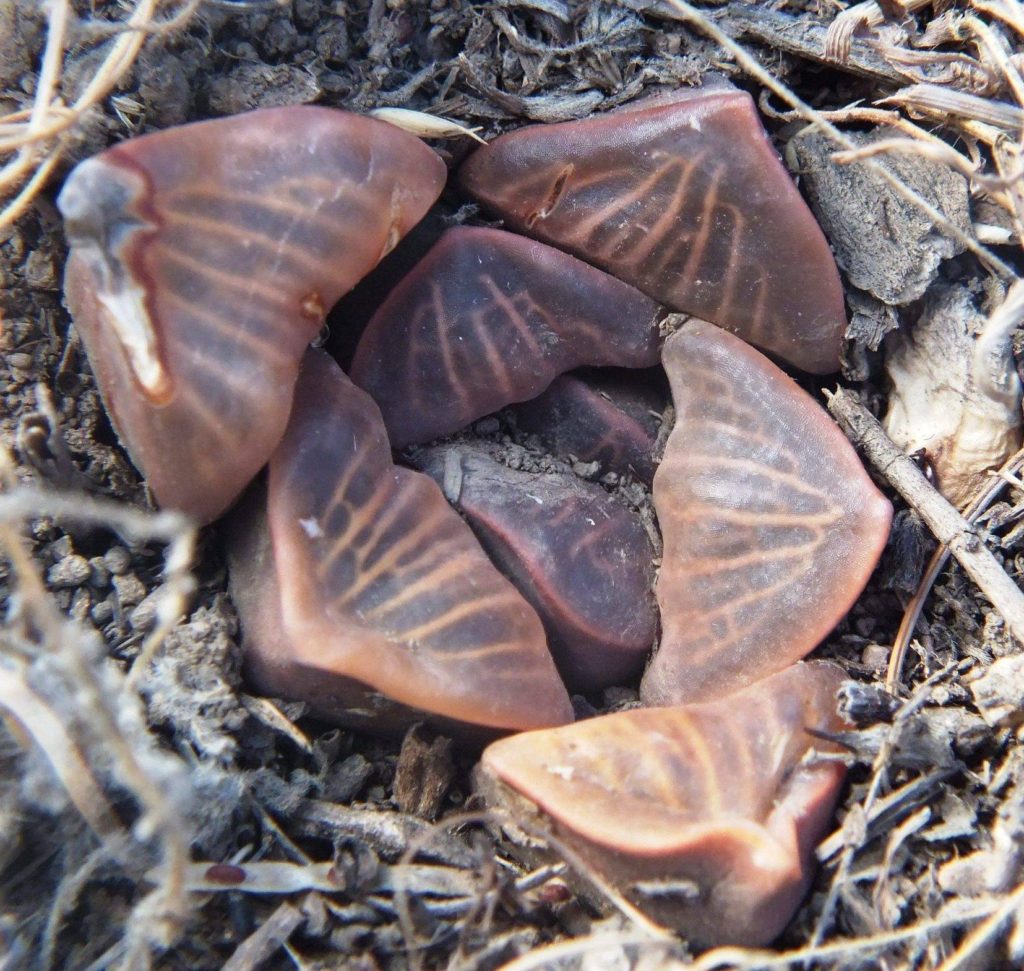
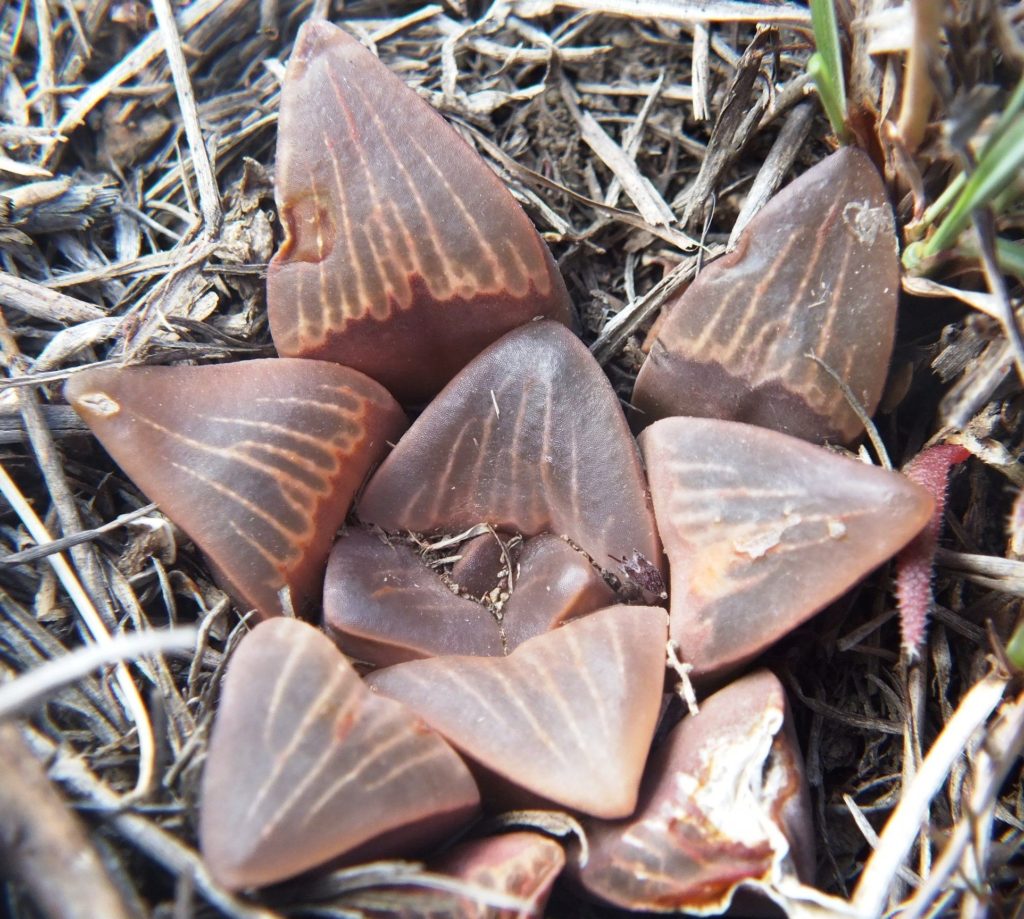

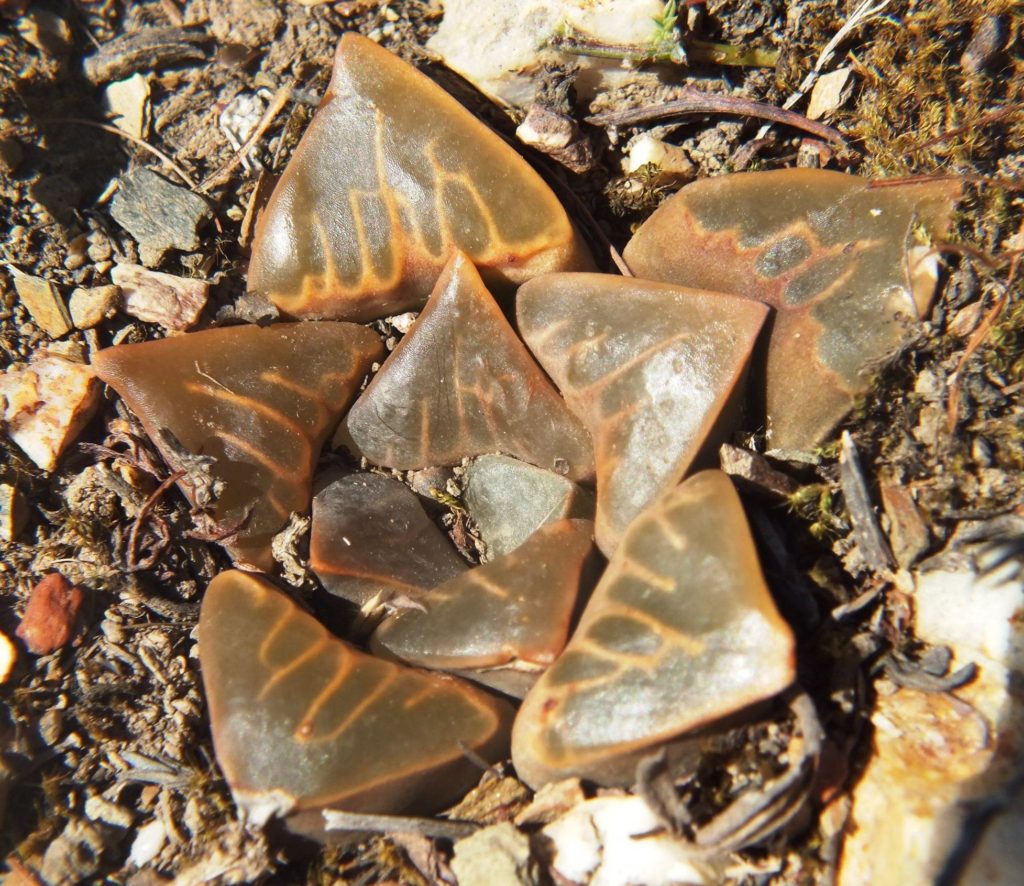
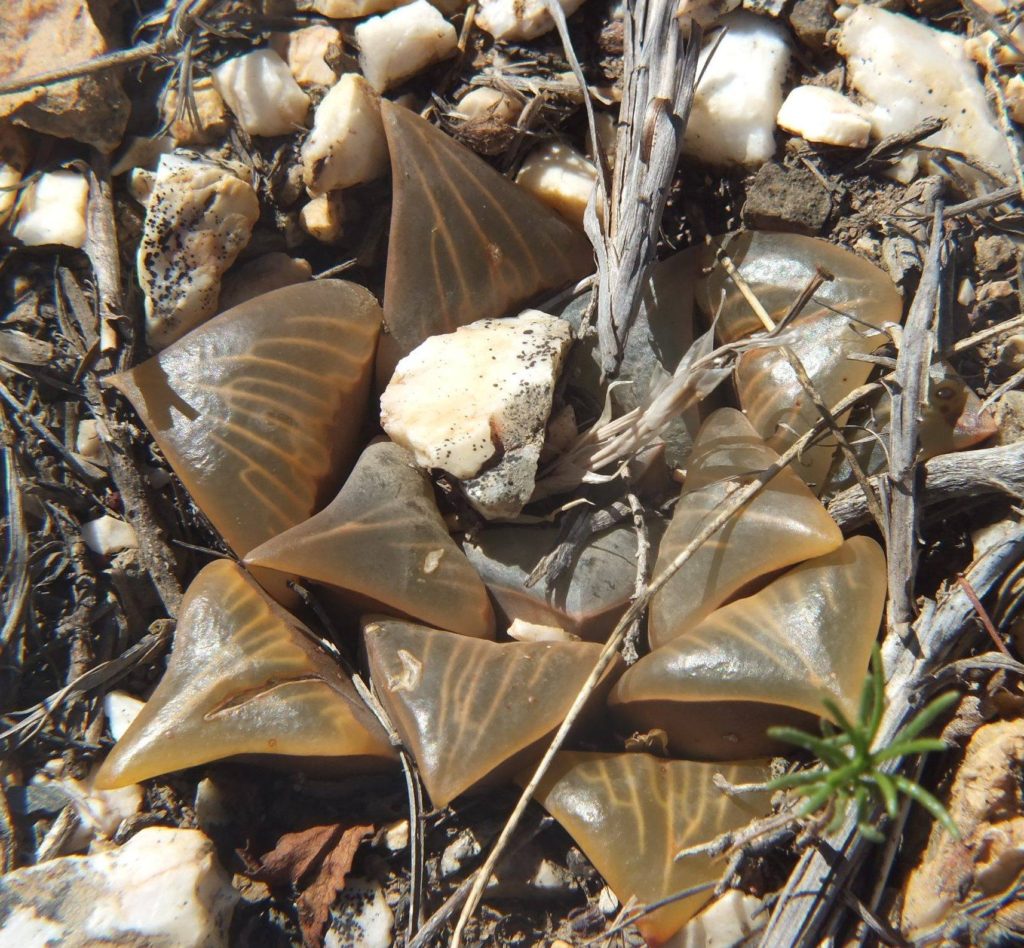
56. 2019.7.16 – I do not think I can get away from the need to note this aberration. About 10 years ago there was a great meeting of Aloe experts (about 30 of them) to discuss Aloe taxonomy. A protocol was drawn up to spell out the requirements for description of new species. No mention whatsoever of just what a species might be. Just what were they so anxious to see described in some proper fashion? Not surprisingly, a few years later a description of Aloe Barbara-Jeppeae1 was published. Aloe is not like Haworthia in that individual plants of a species are near identical and there is by contrast and general rule, very little in separating them on that score. So to have this new species described based on the flimsiest of criteria when the literature was already suggesting that Aloe vryheidensis and A.dolomitica were possibly the same except for the issue of geographical distance, was surprising to say the least. No tribute to a great artist and personality either. I am grateful these experts stayed out of Haworthia. Or did they really and this is this just a demonstration of the deeper problems of classification? What is this proliferation where H. mutica is by rule a loner?
(1) Tom A. Mccoy and John J. Lavranos “Aloe barbara-jeppeae TA McCoy & Lavranos; a long-overdue tribute,” Cactus and Succulent Journal 85(4), 154-159, (8 July 2013). https://doi.org/10.2985/0007-9367-85.4.154

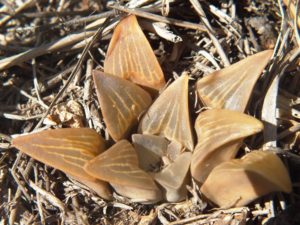
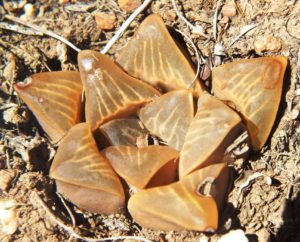
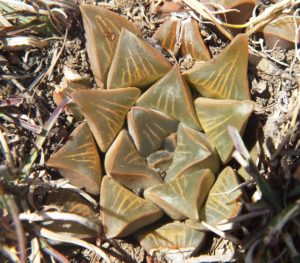

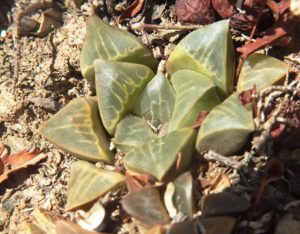
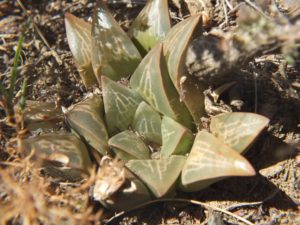
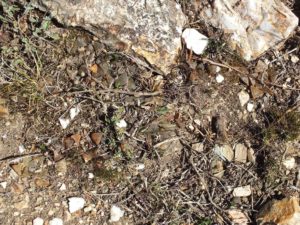
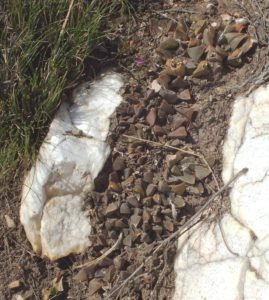
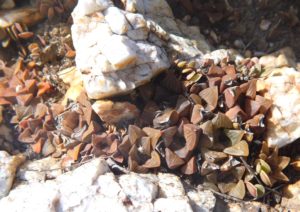
57. 2019.7.17 – It is interesting in that almost the entire quartz lens is just lying fragmented on the soil surface, which is weathered shale. (Elsewhere in the greater area, these quart patches are/were treated with disdain and some farmers go to great lengths to cultivate through or over them). There are almost two habitat conditions viz. large lumps of newly fragmented quartz, and smaller older fragments between and round about. The proliferating plants were in or among the largest fragments. A few hundred meters away there is a second population where the habitat seems to have formed from a decomposing weathered this quartz layer with much clay. The soil is perhaps saprolitic i.e. there has been chemical weathering absent from the first site. The plants are not much different but how would one measure and tabulate “difference”. I add two isolated plants photographed about 1.5km east in a most unexpected habitat. ♦
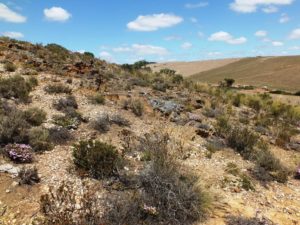
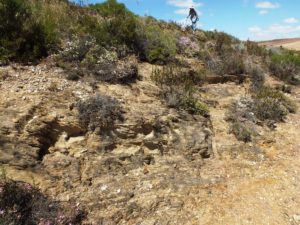
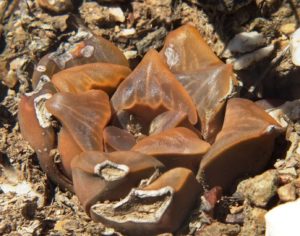
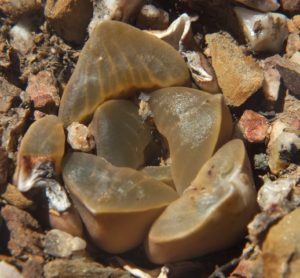
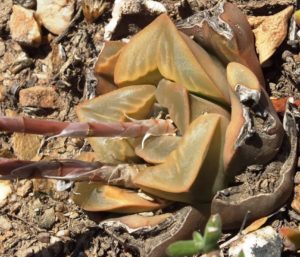
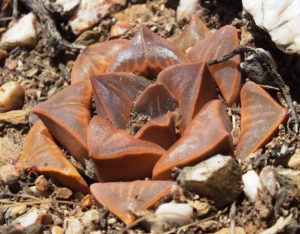
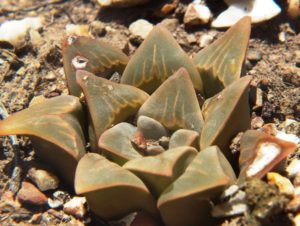
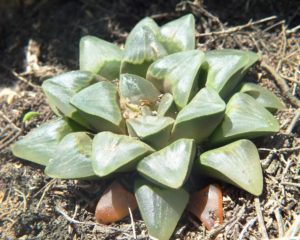

19. Surprises
58. 2019.07.15 – I did promise some surprises but I am abandoning any choices. There are really surprises in any one population. You all know the story of the baboon in the maize patch picking cobs? It is just like that with images. How many can you hold in your mind? How good are you at memorising, averaging, synthesising or whatever it takes, to make an accurate call on similarity or difference? Very few people are familiar with H. mutica at all, and yet make the call on “groenewaldii”. They probably do not even have a clear overview of what that really constitutes. These pictures now are from a population in the Stormsvlei area and from a habitat that is as different from the Buffeljags River site as it is from all the other mutica localities. It appears to be a saprolitic (chemically weathered) soil, earlier underlying a manganic (containing manganese) surface cementation. Nearby is a truly remarkable mirabiloid population on the cementation itself! The images can tell their own story and you can ask “where do those spot come from?” The same passing comet that dropped them on H. floribunda and groenewaldii further east? This is no new species and the weirdness of the close mirabiloid underscores my entire hypothesis. This is of a single interactive gene pool in the Southern Cape and Little Karoo birthing retusa, pygmaea, mutica, mirabilis and emelyae, with still several hundred populations to demonstrate this as a very probable hypothesis, if not fact. ♦
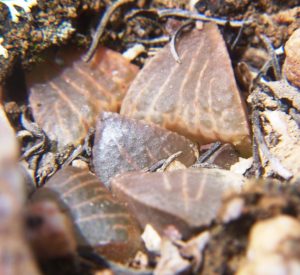
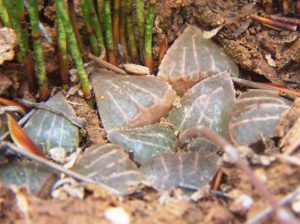
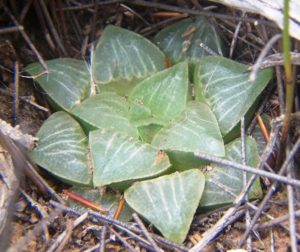
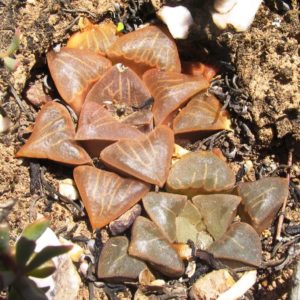
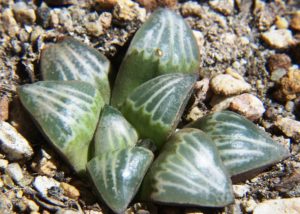
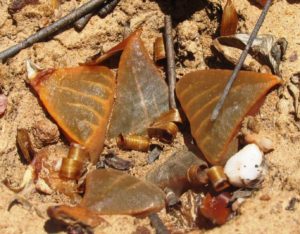
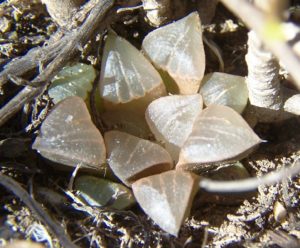


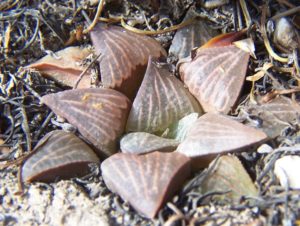

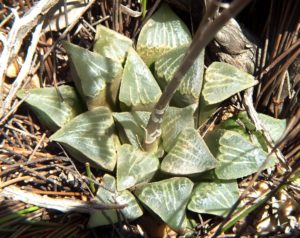

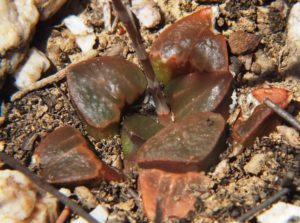
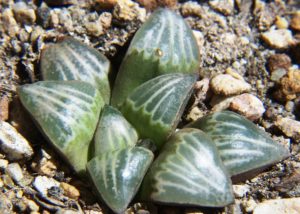
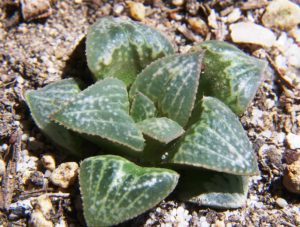

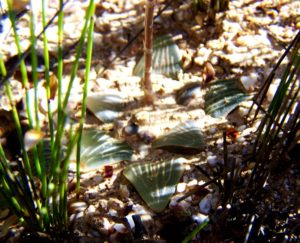
20. Sandrift
59. 2019.7.19 – This is from Sandrift Drew (2011), well into the Robertson Karoo and so the most NW muticoid/retusoid/mirabiloid. A strange place with three Tulista species present and two sets of their hybrids. H. mirabilis is also present. But put that mostly in past tense. I was raw to field Haworthia at the time and exploring the amazing relationship between H. herbacea and H. reticulata when they existed as more than 10 different species names. (I shudder to think what the amazing taxonomists and experts of today would have made of that lot without my intervention). I happened to stop at Sandrift and quickly walked a dense patch of renosterbos. Picked aside some foliage and saw a single plant of H. mutica? It is sacrilege to collect any single plant and I did. It grew into White Widow and a story told elsewhere. The patch of renosterbos is now the site of a centre-point irrigation system. In about 1945 a Mr. Meiring employed at a nursery (Hurling and Neil) at Bonnievale, collected and sold 200 plants of H. mutica from Sandrift to Triebner at Windhoek for 1 shilling each. 1 shilling became10 RSA cents and I wonder what the equivalent worth is today. But the plants did survive in the wild until 2017 when change of ownership (again) brought the inevitable new broom and all is now gone. This despite countless visits and contacts with the landowners. I would describe the habitat as some kind of gravel terrace. But geological connections is now Steven Molteno’s domain. Very complex. I have two albums from different times and will post them both by date.
The first picture is White Widow – it developed that milkiness 15 years in to cultivation!
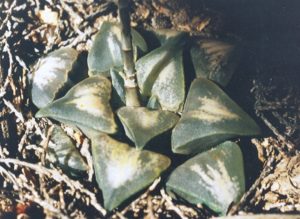
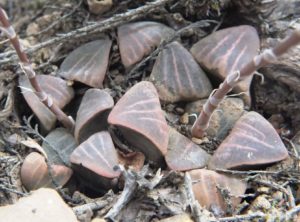
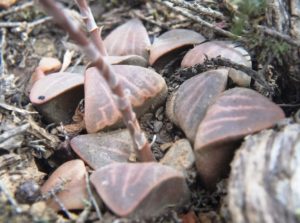

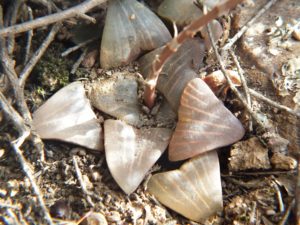

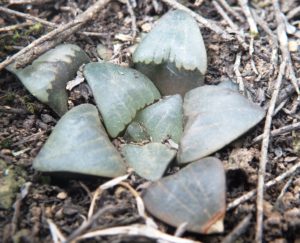
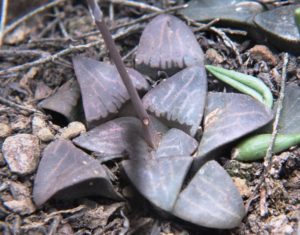
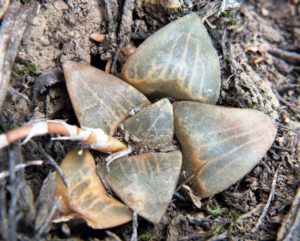
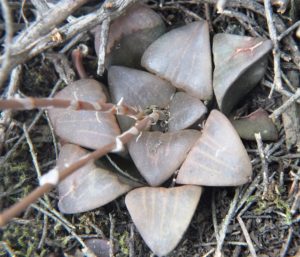
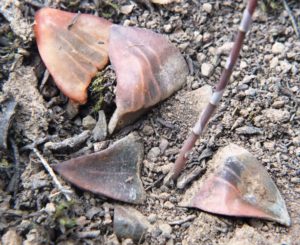
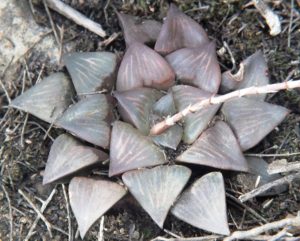
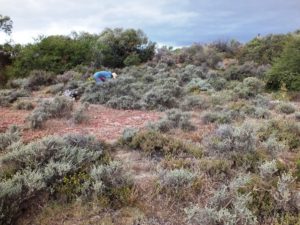
60. 2019.7.20 – These next were taken at Drew one year later, and a great thought comes to mind. There is an exciting, great future for all us kooky taxonomists with no clear idea of “species”. Just imagine all the new species we can describe if we visit the same sites at intervals of, say, 10 to 20 years. The truth is if we were just presented with clones from supposed different sites, we could end up describing several species from each locality without bothering about possible changes with time. I wish I had more evidence from my own experience to substantiate the real truth of this. I have two dramatic examples and evidence for just one. “White Widow” (“mootica“) is also an indicator of what can happen with time? ♦




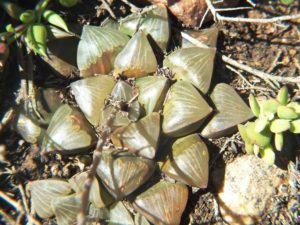
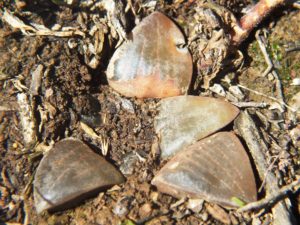
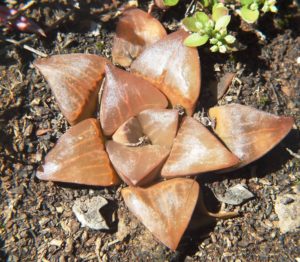
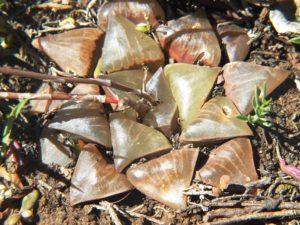


21. Napky
61. 2019.7.19, MBB6536 – I recall Napky as being the origin of H. maraisii v. simplicior1 or something like that in the total chaos of the von Poellnitz/Smith era. While we seem so anxious to return to that timeline, are there any more surprises? Many. Just look at these few. Some could be taken for “magnifica” if that was remotely a reality. So let us rather say “some other mirabilis population”. But this must be “mutica” because there is a mirabilis in the vicinity and this population of spring flowering does not match that of nearby winter flowering. And did we say “mutica” without a point. Look at that picture of an excessively mucronate (ending abruptly in a short sharp point) plant almost in the image of the present meaning of “retusa” with the point drawn back from the margins in the centre-line of the leaf. Or has that changed too? I see the modern dictionary has a rounded leaf tip with an indented notch? Latin names also get a bit confusing because I recall “retusa” originally being taken to mean “bent-back like a thumb”. This at least agrees with the original Latin description and accompanying illustration. (MBB6536 – the mid-east of Area 1)
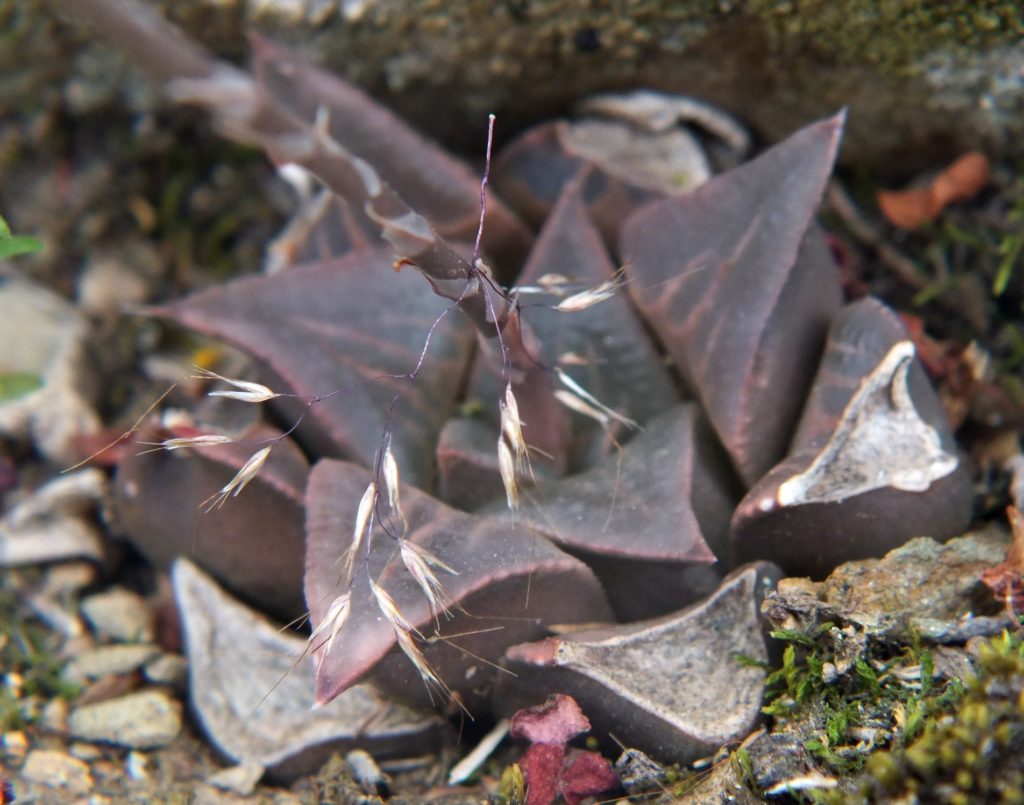
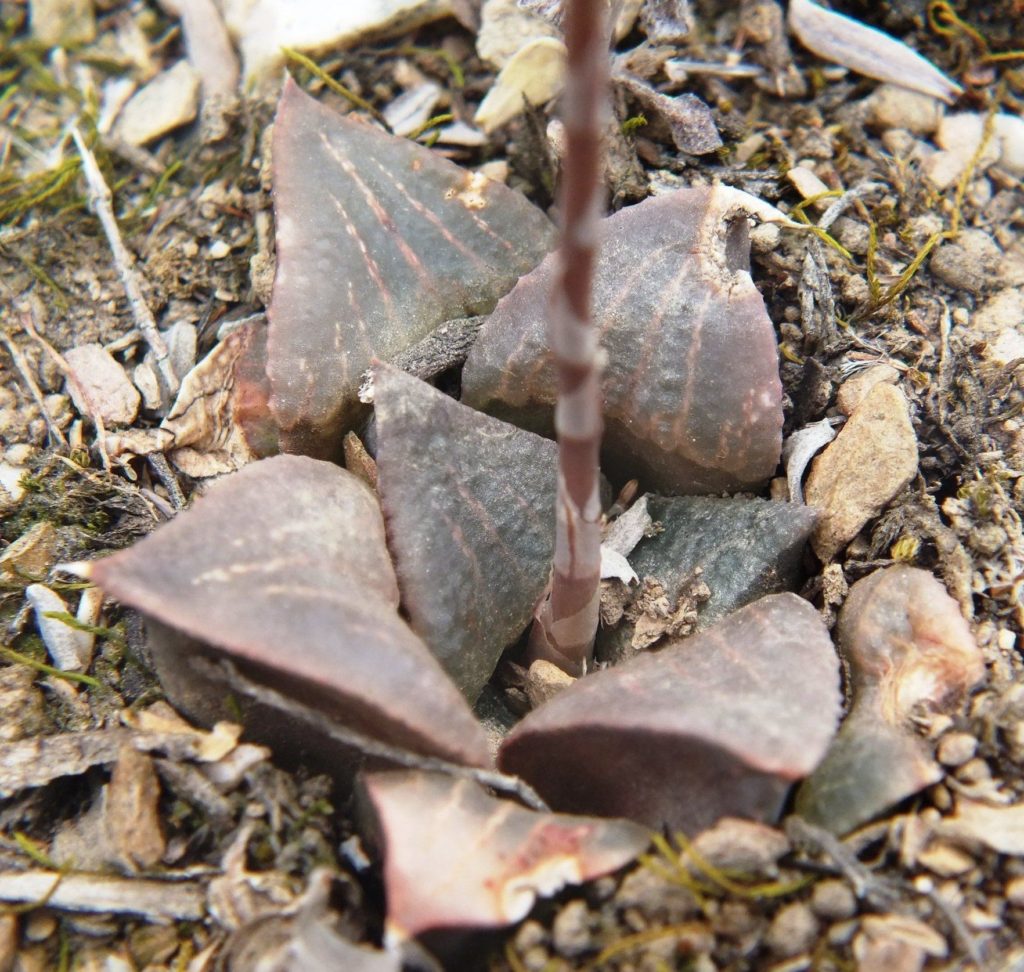
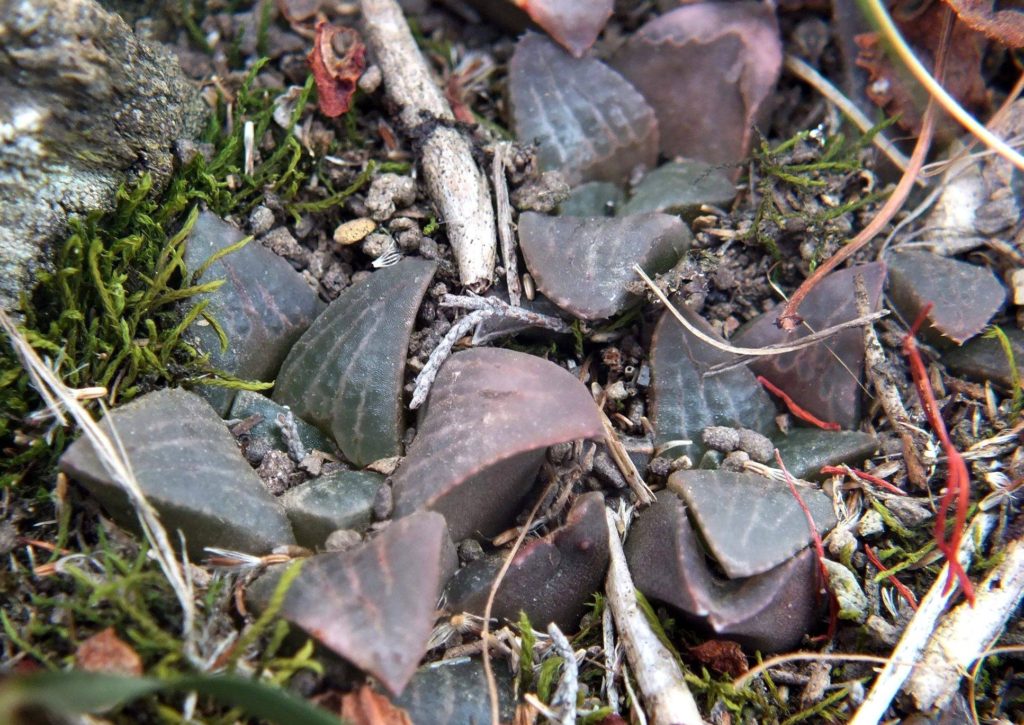


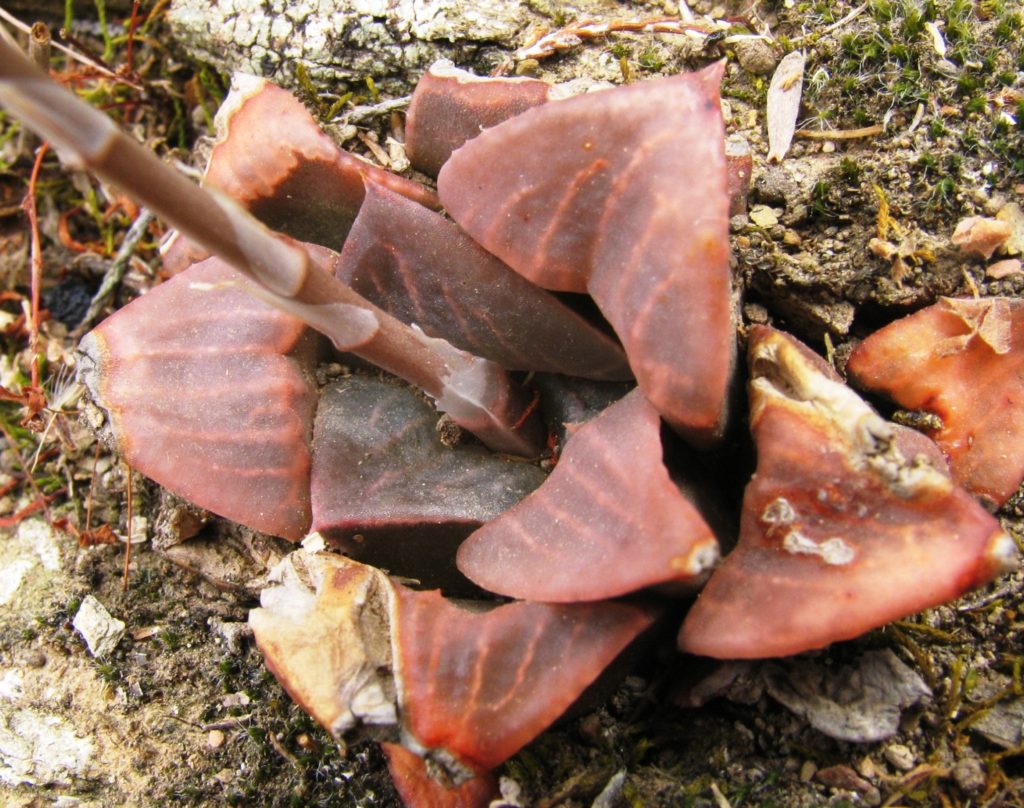
Let me just add that H. maraisii is as much a myth as H. magnifica and people should know my history of involvement with those two names. It was a hard pill to swallow when I found that in fact they were part and parcel of the same mirabiloid complex. That there are those that dispute this simple reality is beyond my comprehension. IF they are right then there are several thousand haworthia species in the S Cape and many from any one population.
(1) H. schuldtiana var. simplicior idem. v. Poelln. 49:26(1940), Cape, loc. unknown, Beukman in Long 690. Not preserved. = H. mirabilis var. maraisii. ♦
22. Haarwegskloof again
62. 2019.7.21 – Going away to the west southwest is Haarwegskloof – one of those conservation areas by default, as it was too difficult to grind down to make a wheat field. Jannie Groenewald was manager there. In dealing with this issue of “groenewaldii” and my present hypothesis, there is no intention to do anything but respect and applaud his genuine interest and competence as a naturalist par excellence. The problem at Haarwegskloof is that H. retusa (turgioid), H. mutica and H. mirabilis (as possibly 3 different heidelbergensisoids) are present. I concede that it will be nearly impossible to convince any botanist that these are all the same one species. But I have so far presented only about one tenth of the raw evidence, if as much as that, of the fact that this is a very probable truth. At Haarwegskloof, we have H. variegata just a short way away, that strange form of it in the limestones a bit south, and no Tulista? Even H. rossouwii could pitch up nearby. I am not at all sure what the geology of the area is. It is within a series of inselbergs in Area 1 (our map) NW Bredasdorp. There is much shale and quartz in the area. The mutica there is pretty average for what would generally pass as this “species” and you can just look at the variants and see that even here there are divergences. Again I happen to have two sets of images from 2011 but just a month apart. I can’t explain why there is just one inflorescence prominent in the pictures as flowering time should have been October about when the pictures were taken.
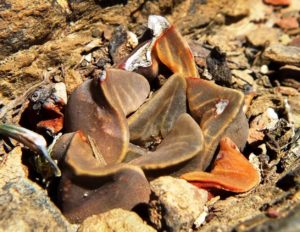
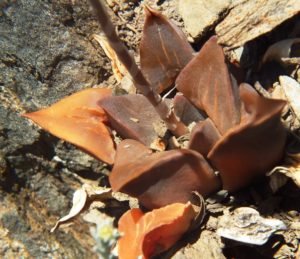
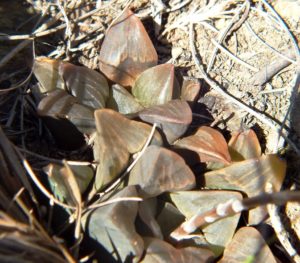
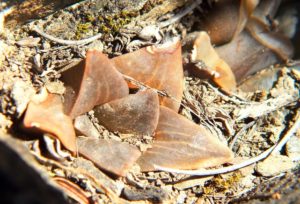
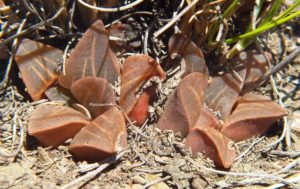
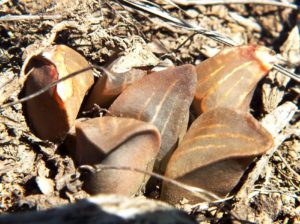
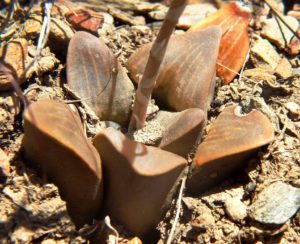
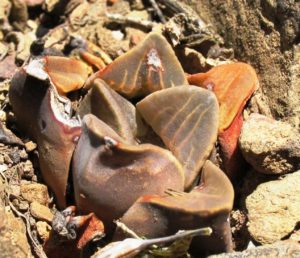
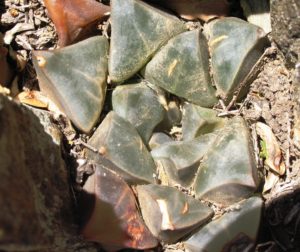
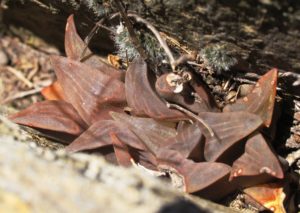
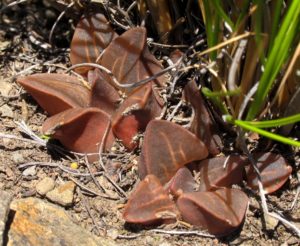
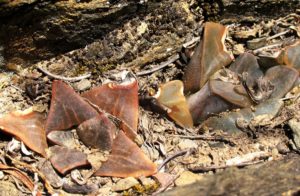
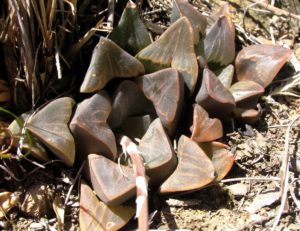
63. 2019.7.22 – Time is short and I am anxious to move on. Still Haarwegskloof and same general place a month later. I so wish I could just drop the whole lot down in one shot like a reinforced block of concrete. One population after another setting into one solid argument. I have too often found in Haworthia that I start putting an argument together point after point. Agreement all the way until 4th or 5th when I find the communicant has forgotten what the first two were that were agreed upon. End of discussion and no end result bar more confusion and disagreement. With writing it has been much the same. As if readers do not read and look at the pictures instead with conviction they know from that what the message was. The area around Haarwegskloof is studded with heidelbergensoid mirabiloids and I shudder to think that I had forgotten about the complexity of the area east of the Potberg. I do not think our map even covers it. That alone is a killer.
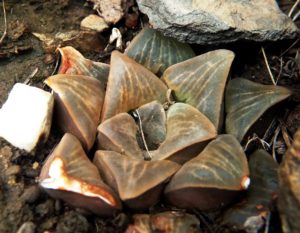
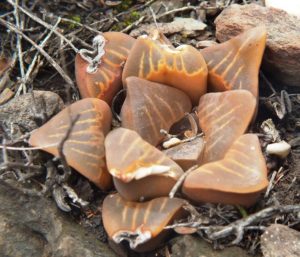
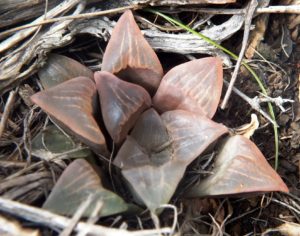
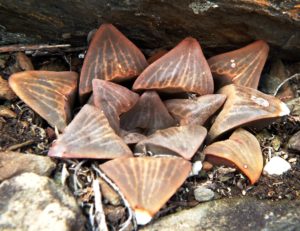
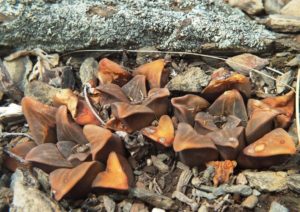


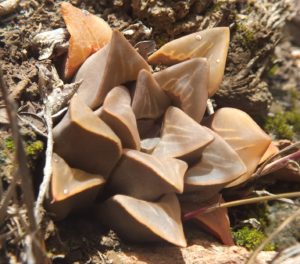

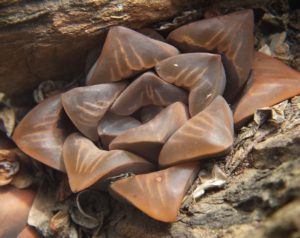

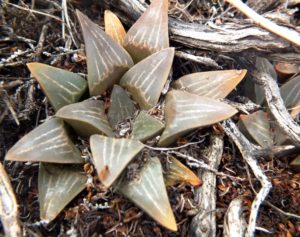
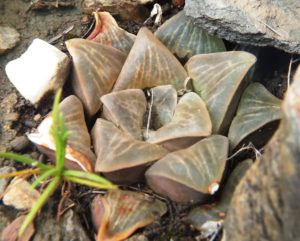
64. 2019.7.22, MBB7934 – October. South of Haarwegskloof and looking towards the limestones of De Hoop. I wish I could will slip in a picture of the variegata-like thing there just to hint that there is another can of worms to open. Problem is that was before the days of digital cameras and my mountain of evidence is only a tip of an iceberg. But no problem for taxonomists. As they say – do not confuse me with the facts. New species, new species, new species. Our succulent journal editors have nothing to worry about as there will always be something to fill the pages and please subscribers? Growers will be wondering how they can get sticky fingers on these? Nature conservation will be wondering how they can stop the army of pilferers. I sympathise with them all as it is a wonderful and enchanting creation just as it is meant to be. That house was occupied and people lived there in 1970 when I first wandered around in that area – a sad truth was the disappearance of the small farmers.
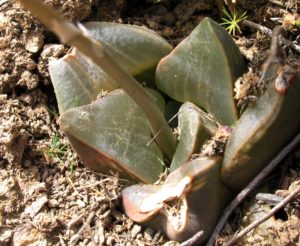
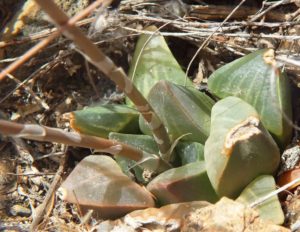

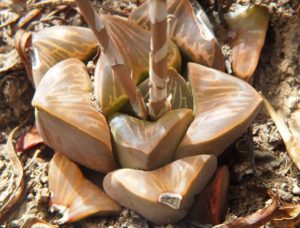


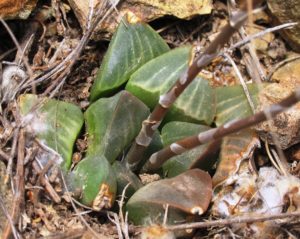
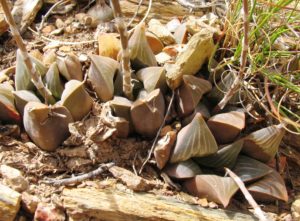
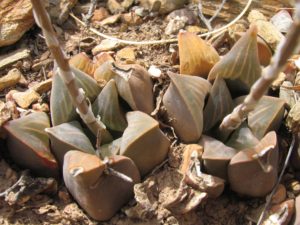
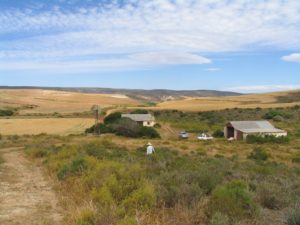
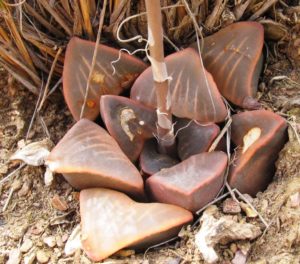
2019.7.24 – My view on conservation is that we can respect the gems and try to conserve them, but the essence is conserving the system that produced them. Every population has something in it that may be special. Recognising my own limitations, here is a diagram of the Southern Cape depicting the species hypothesis as simply as I see it i.e. H. mirabilis and H. retusa as a common gene pool between the Gouritz and Breede Rivers. H. floribunda does unquestionably intrude. This really complicates the issue because H. floribunda has its own connections to H. variegata, H. chlorocantha and H. parksiana. The interpretation of sequencing simply has to take account of these realities of geographic association and continuity. In my association with DNA researchers they have simply failed to address the issue as I have explained it to them. It has been suggested that the technology used is not separating the elements that it should. Thus the assumption is that the existing classification used to draw samples is adequate and that it is only a fine tuning and refinement that is needed. Further that “next generation sequencing” will produce a better answer. The truth may simply be that the sequencing is based on a poorly generated hypothesis and that the concept of species is based on a very weak definition. Question mark. ;)
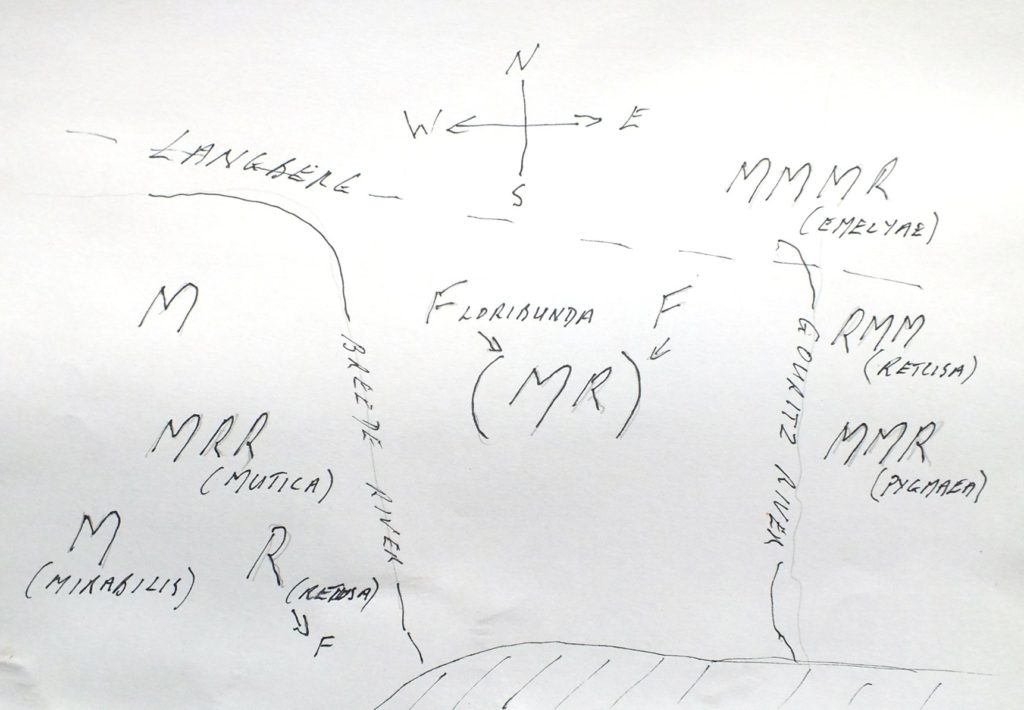
Don Kirkwood, (Stellenbosch University Botanical Garden – US Botaniese Tuin ): Putting aside his (Jannie Groenewald) personal connection, I do think that whether the species is valid or not, there is a case to be made for “groenewaldii” being as distinct from mutica as mirabilis or pygmaea, including distinct separate flowering time where it is near other mutica from what Jannie says and what I’ve also seen.
But I’m no taxonomist or Haworthia expert at all – I’ve worked in landscape conservation most of my career – so want to make the more general plea for the community to err on the side of delineating and red-listing at least subspecies level if the variation does represent a consistent and separate type, especially if there are breeding barriers from flowering time. I think the poaching is driven by more aesthetics than formal nomenclature, and land use and protected area decision making is underpinned by targets that must be at least subspecies level. I’m obviously not pushing for rubbish taxonomy, but if there is any doubt, it makes sense to err on the side of delineating at least to subspecies level.
Bruce Bayer: Thanks so much Don – if you have read all my posts I am sure you must see that this is exactly what I am on about and where I am heading. Every haworthia population contains something genuinely different. What is the difference between 600 species and 600 subspecies? I have specifically addressed the flowering time issue and explained how it relates to the whole system. Has Jannie explained that there is a similar plant on the other side of the river and in the Bontebok Park as well? Is that not groenewaldii? He is perfectly welcome to post his views in the context of all my posts. We have had many discussions. See my latest post about conservation and system. I was instrumental in the initiation of the red data listing and see a serious problem with conservation by “concern”. Please look at the earlier post re system here and I really welcome comment.
I do not want to be distracted by a problem even more vexatious than classification i.e. conservation. But I live in Fisherhaven and see how conservation is applied to virtually only designated reserves. Other open green space is at the mercy of Environmental Impact assessment and whether or not conservation principles make any difference to outcomes. There are many open green spaces in and around the village grossly impacted by alien vegetation. These green spaces in reality have no conservation status whatsoever despite being on the Bot Estuary margin, and in the Kogelberg Biosphere. There is no floristic data to support any conservation issue largely because no Red Data species are apparently present. It amounts to the fact that this is an area of least concern based on non-existent data? It is a nodal point for 4-5 vegetation categories.
Lawrence Loucka: Setting aside not having a definition for ‘subspecies’ it is important how we classify and name things. H. groenewaldii certainly has become recognizable, and has entered the vernacular. What is wrong with recognizing this thing as H. mutica var. groenewaldii and accepting that it is highly variable and can be indistinct. Please explain.
Bruce Bayer: Again Lawrence, this is not my terrain as I am on about the species issue where there also is not a definition? If a conservation argument occurs someone can do this and argue for the fact that this mutica variant is distinctive. But no argument based on a single species or subspecies will do much unless the threat is better identified and supported by other stuff. Is it east bank or west bank? East bank – does it have anything else of conservation concern (this itself is problematic). West bank more important but Bontebok Park is already there – does it need expansion? But is conservation by designated reserves or by general environment? Then we also look at floribunda and say all those oddities in and around Swellendam need some sort of conservation status. What criteria are used to place a mutica variant over a floribunda variant. Can I point out that one of our A-rated scientists confided in me that “Conservation biology is in a mess.” Can we resolve it here? My observation just by recent local experience is that environmental conservation outside designated reserves is in a crisis of monumental proportions. Debating one species vs subspecies – does it have any significance? How do I persuade a botanist that so many of these Fisherhaven species need some sort of taxonomic recognition to make the place conservation worthy. There is a new Oxalis species here, Leucodendron has significant variants, Serruria, do we have adscendens or rubricaulis? What is this thing we cant identify to species level, a Lachnaea? Is this small form of Protea scolymocephala insignificant? How important is leucodendron linifolia? Just how accurate is the red data list???? Haworthia is significant because it has been so thoroughly researched beyond that for so many other genera – and by many taxonomists. Eriospermum for example has had one researcher in the last 40 years. Who actually knows a simple genus like Asparagus? Lobelia? Is even Erica actually understood or is it solely the taxonomic preserve of one man who has spent his entire life working on it. If he did finish, is the genus he started with, still the same today?
65. 2019.7.24, MBB7937 – Still further east is/was this remnant population (ADH2729) showing how remnant skeletal habitats crucial to the survival of these plants, are slowly degraded. On the conservation scale it is of least concern when it is these skeletal habitats and low rainfall that give us anything to conserve at all. Elsewhere in area 1 you can find sheer ecological deserts from skyline to skyline.
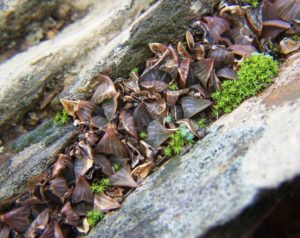
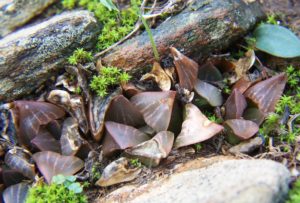
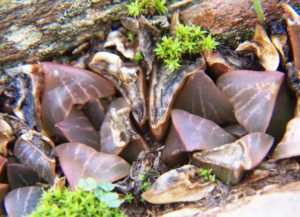
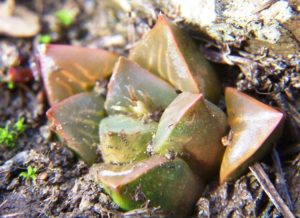
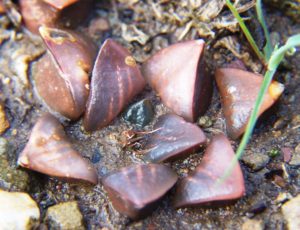


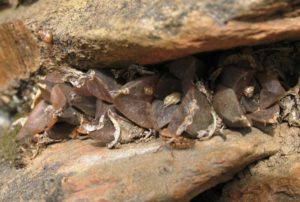


66. 2019.7.9, MBB6941 – Just a bit north now. Amazing co-incidence with the threat to and destruction of “groenewaldii” on east bank of the Buffeljags river. It was brought to my attention by a consultant while doing an Environmental Impact Assessment. A wonderful population of H. mutica on a shale ridge that I identified for him. He reported back that OK he would recommend they move the proposed borrow-pit (quarry for road materials) back a bit to save it. I am very hesitant to go back and check again to see if the recommendation was ever implemented. This is a fundamental problem (or at least one of the problems) of the conservation process even if mutica was a double red-listed species. My own experience is that it is extremely unlikely that any recommendation is ever truly honoured, implemented and monitored. Although, there is great hope for “groenewaldii” still on the Buffeljags River west bank. ♦
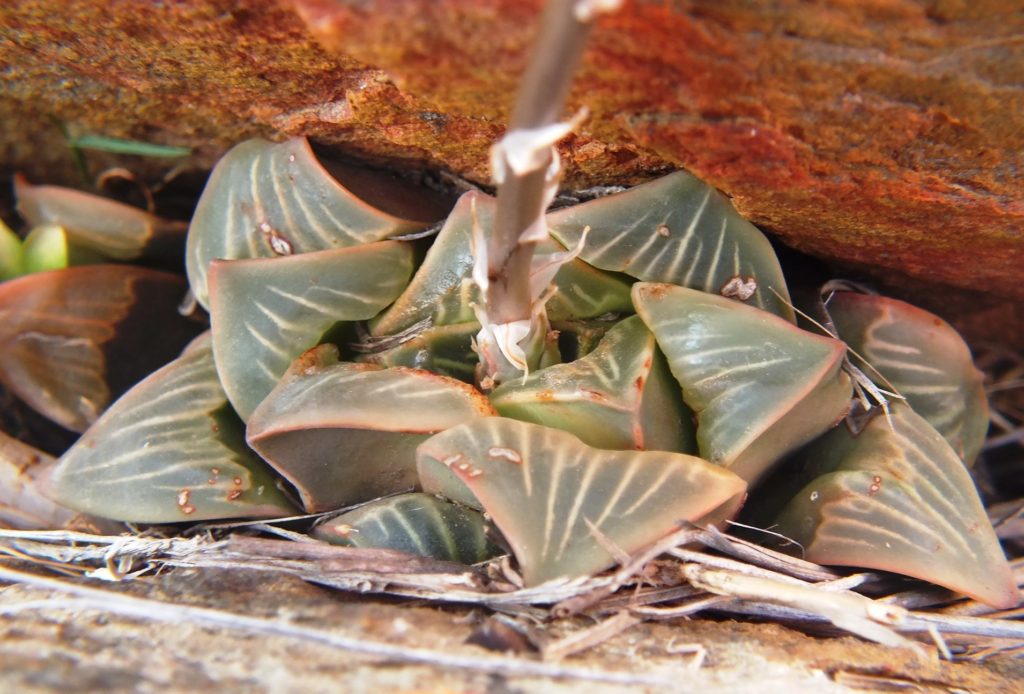
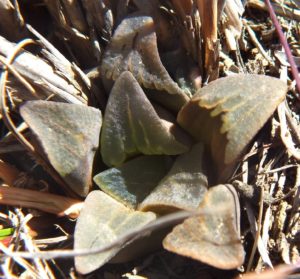
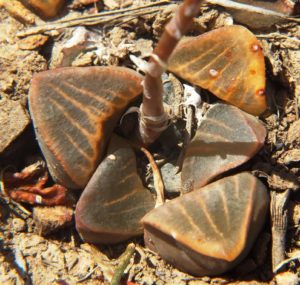
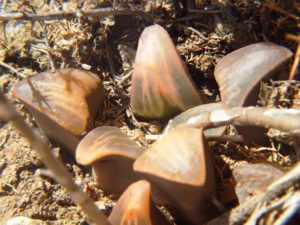
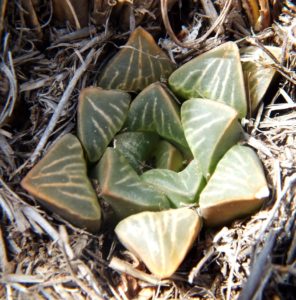
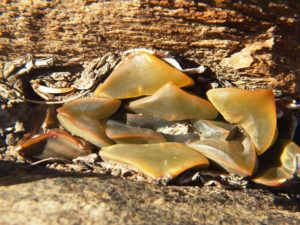

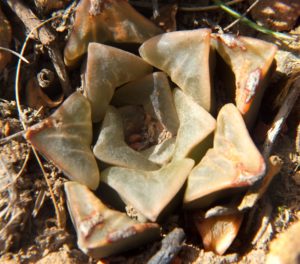
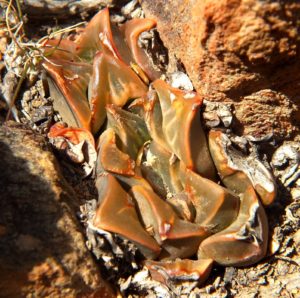
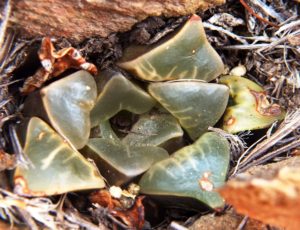
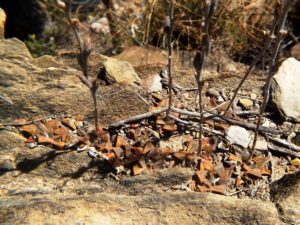

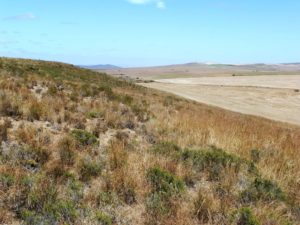
23. Groenewaldii conservation
67. 2019.7.25 – I think I will have to shut down on this topic as I am clearly misunderstood on most fronts that matter in general society. My species definition sets me apart from botany and science as a total oddball viz … dynamic fractal systems of living organisms that are physically (genetically, morphologically, physiologically) and metaphysically, continuous in time and space. I do not add another sentence but suggest that this is a conscious creation and there is a lot more to species than an endless list of binomials.
How can I stop? Essentially I am being blamed for the implementation of a multi-million rand agricultural project by not opposing it on the basis of fraud. If instead of touting groenewaldii as discrete oddity only on the east bank, it was seen as a critical element in a vast complex system, I think a 10 times better argument is available. In any case here is a map showing one of two other localities on the west bank. One extends into the Bontebok Park a little west. Some of my readers just do not seem to get it.
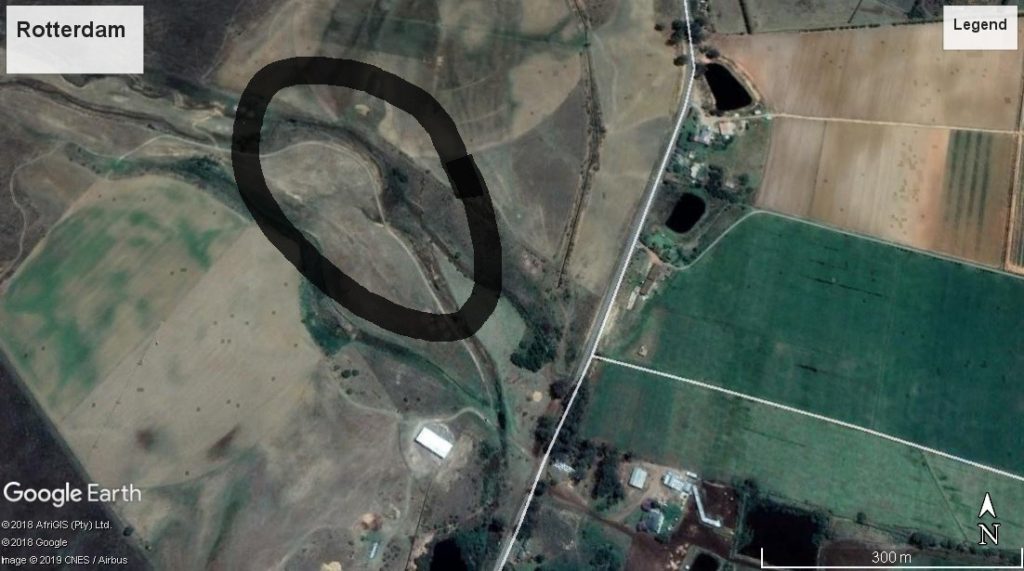
Solomon Nomolos: People who care (most) about earth are constantly in contention with people care (most) about money. It’s always a battle to preserve the sacred in the face of profit. What ever anyone wants to call that plant we can all agree it’s beautiful and we can also all agree that citrus fruit is relatively easy to grow in many different regions.
Bruce Bayer: Solomon – now we move that landowner somewhere else too? I think I met the guy – already displaced from somewhere else battling with a dairy business in the face of that industry’s problems. Then also move the citrus to the Stormsvlei area and rather destroy that equally unusual population. Besides this is not the only point. The plant could still be safe on the west bank – for a while until that landowner starts to feel financial pressure. We are all to the singe individual, totally confused and confounded with no insight into the creation and its purpose.
Solomon Nomolos: I get it … it’s heartbreaking to me. Here in my country they’ve given up protection year after year, there are oil drilling operations everywhere, it’s always in the name of jobs. It seems to me there is no end to it all, one place at a time we are ruining the planet. And I have to ask from time to time when is enough enough?
Bruce Bayer: I would like to remind visitors that this site is about a specific hypothesis and the use of the word “species” with full appreciation for what it means and what a Latin binomial represents. Conservation is a completely different issue and also not something that you prostitute science for. Or common sense for that matter.
Bruce Bayer: An interesting take … “It is better to tell the truth and make someone cry, than to tell a lie and make someone smile”. Science and religion have destroyed what it really means to be human. These two disciplines should both be about truth and in accord with one another. It sure would help me in the wreckage of Latin binomials.
Solomon Nomolos: Subjectivism has done more damage I would say. The idea -according to what I can see- of being human is living in the broken state. Humans are bent from birth, and have made no positive contributions to earth. They’ve also all together abandoned the notion of living with the earth, in her cycles, with her motions. I think religion is another social weapon created by men. Science is seldom viewed in balance because the eye in which we use to view it sits atop the pride and ego of its possessors.
Bruce Bayer: Solomon I think it is that science as it is thrust on the human psyche is a form of particularisation and reductionism. So you are quite right. Abandoning living with the earth is simply not recognising that this is a conscious creation. Life is not a mechanical, physical or chemical process. Species are living things.
A serious issue of availability of plants is a topic that no one wants to touch. My personal view is that conservation issues cloud the scene to the detriment of conservation itself, to the detriment of commercial horticulture, as well as to people who are interested in and enjoy these plants. There is no need for it. But who has an answer. Ivory – one school says burning of hundreds of tons of tusks stopped poaching and others say it encouraged it. Again my personal view is that prohibition and exclusion are as immoral as poaching. ♦



